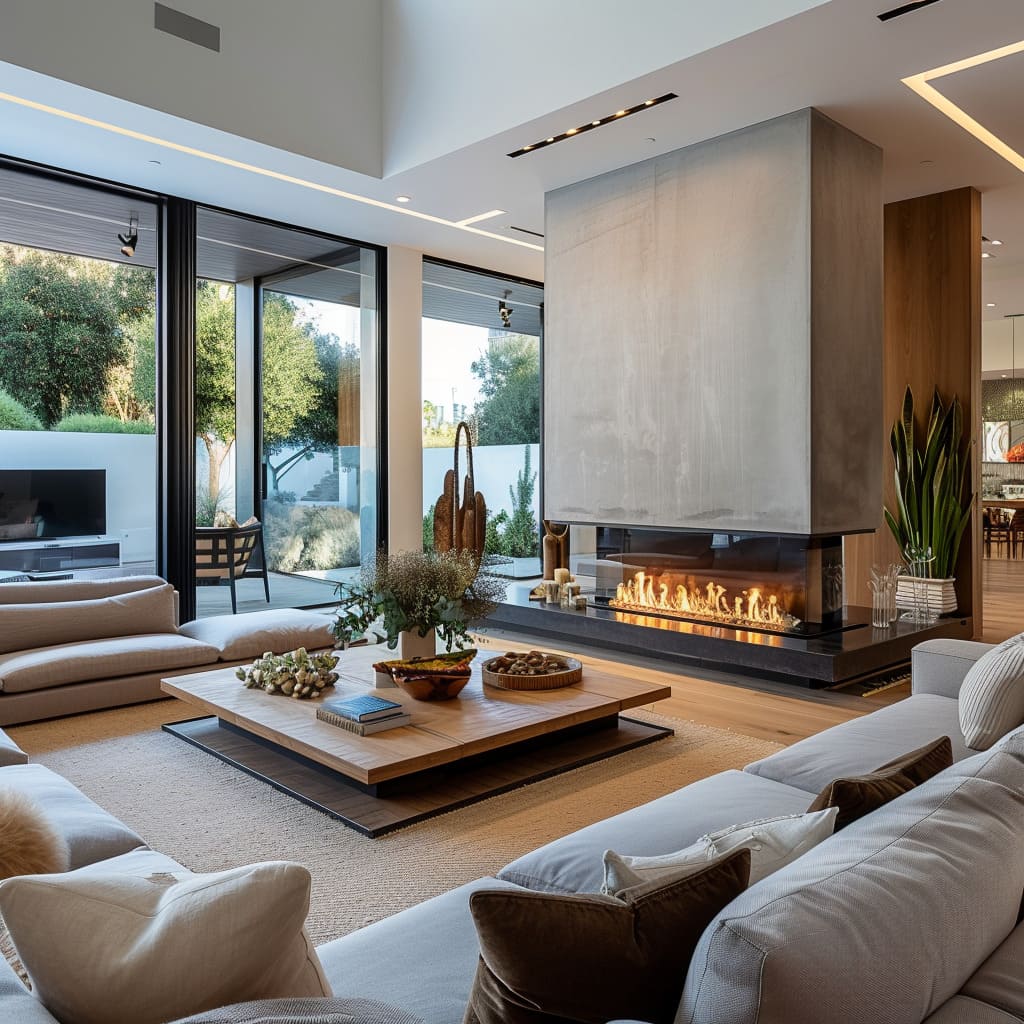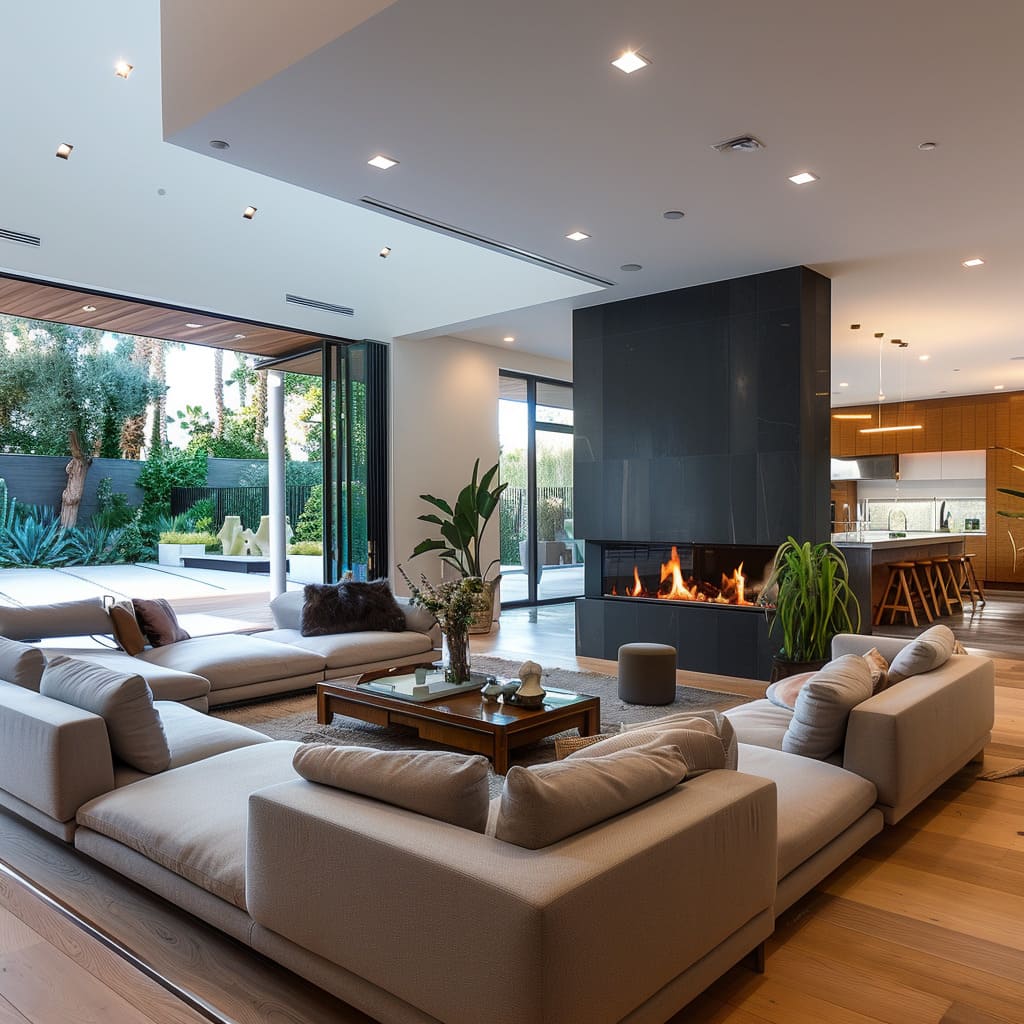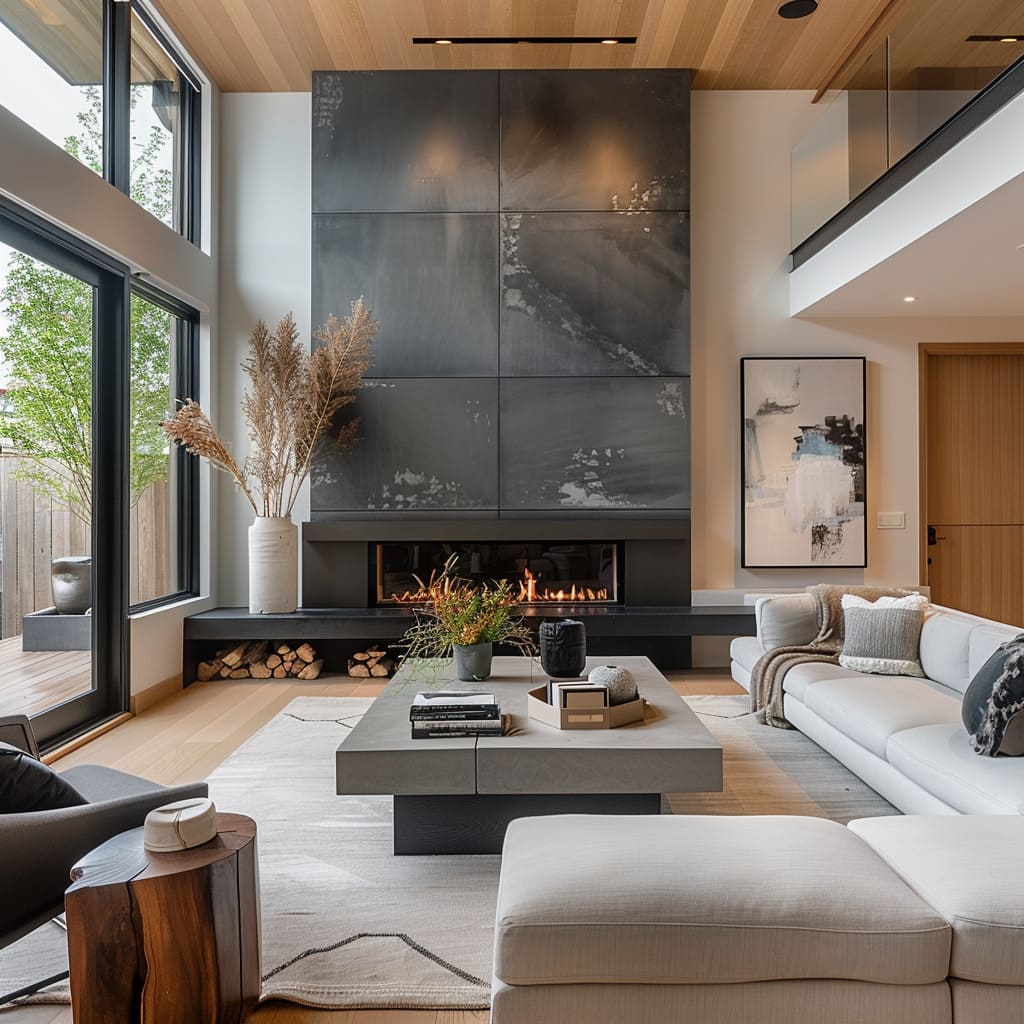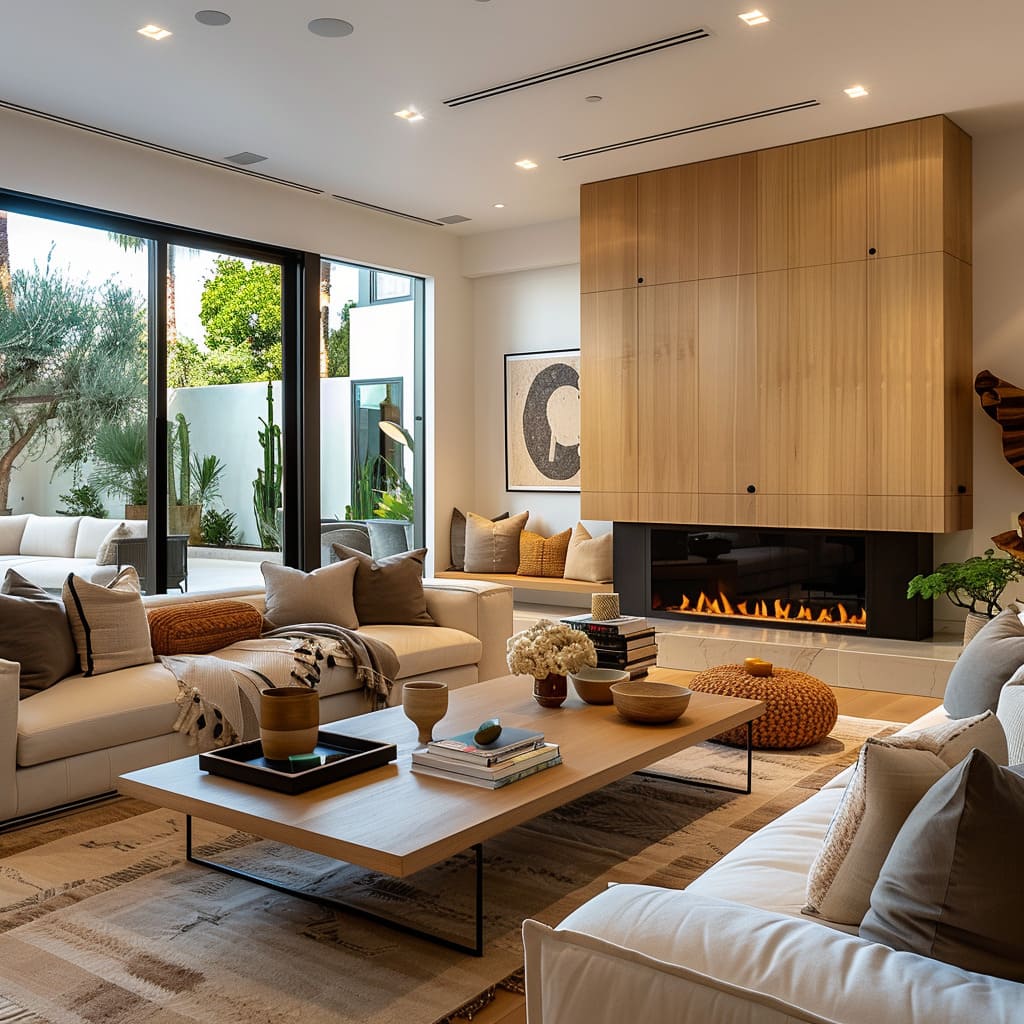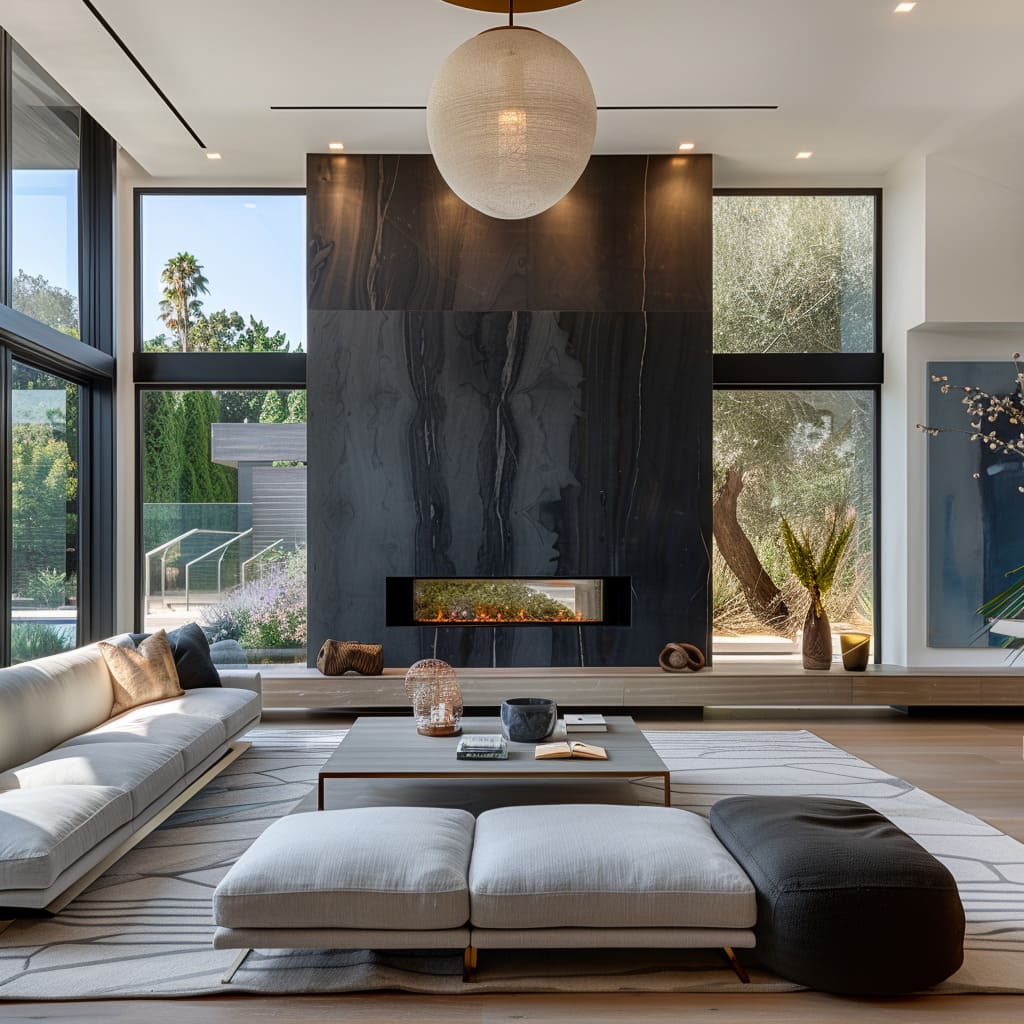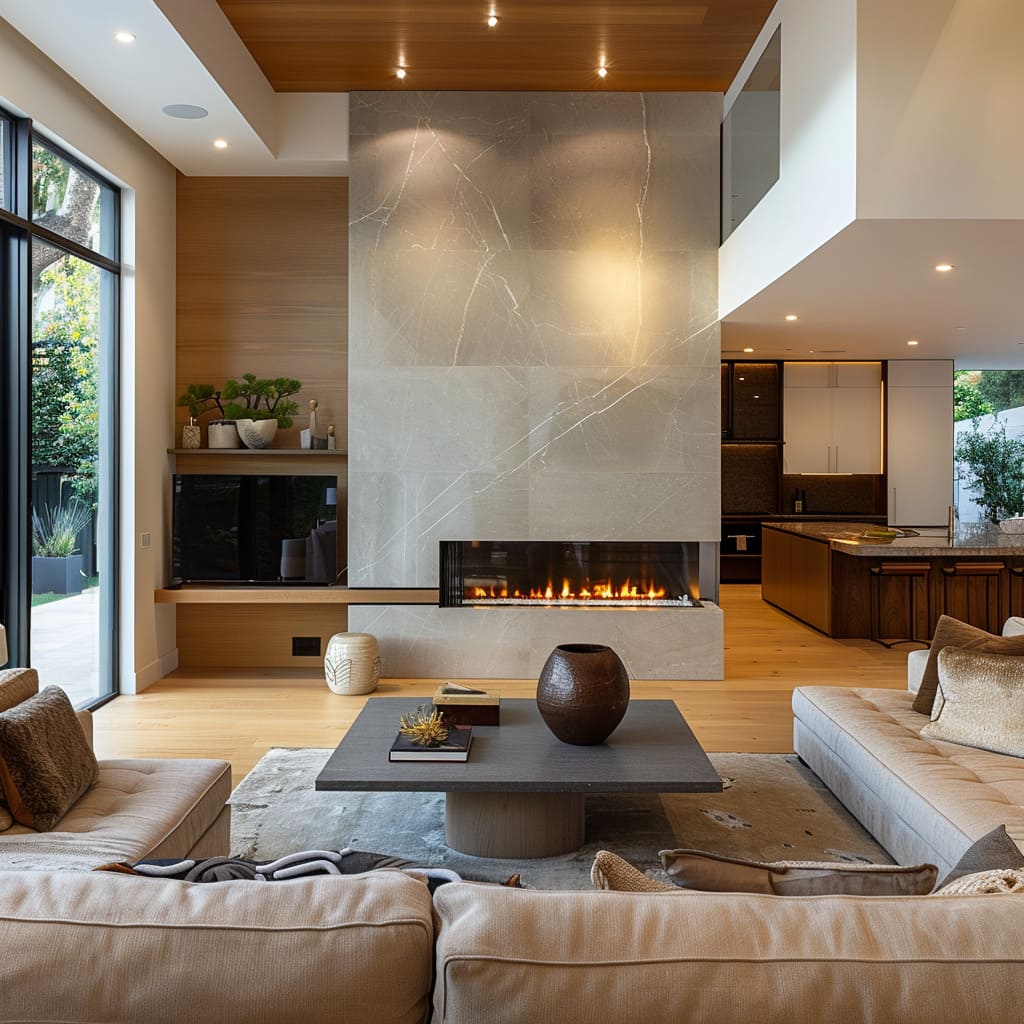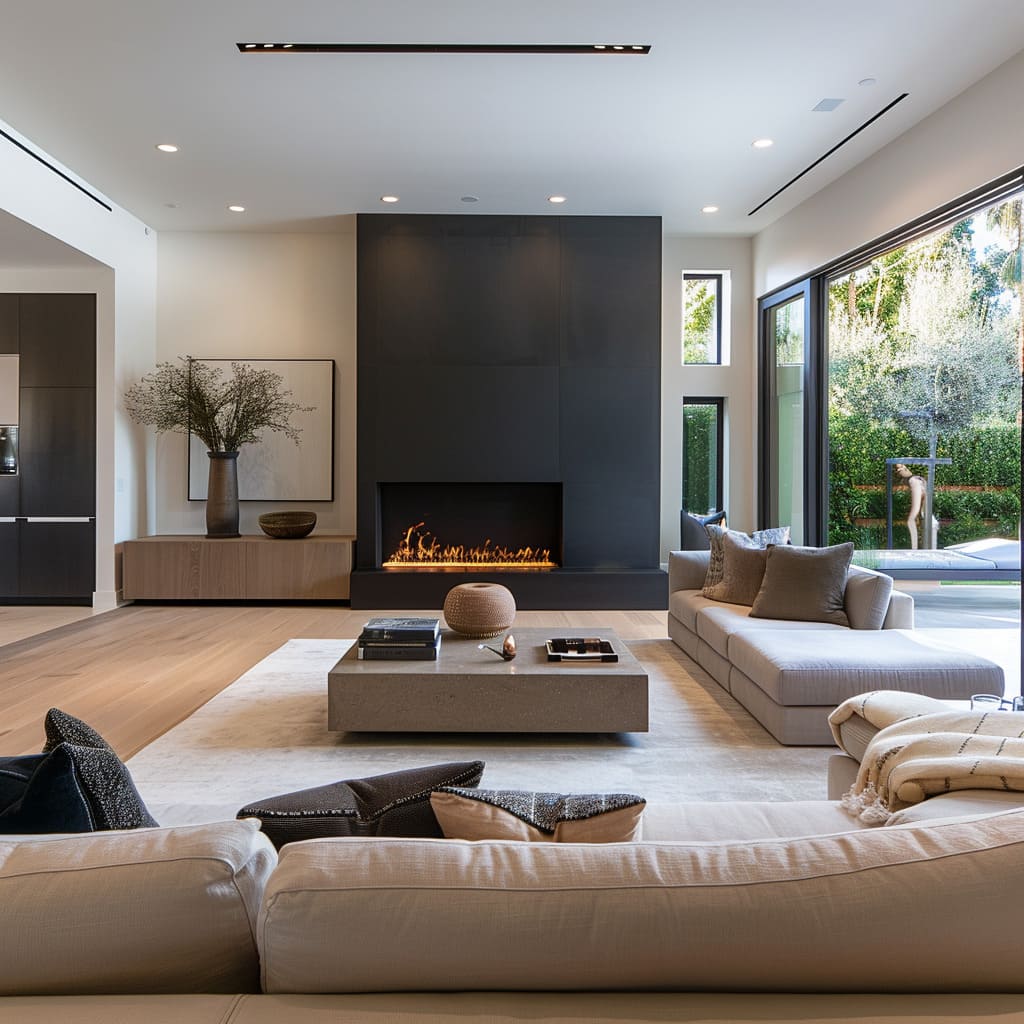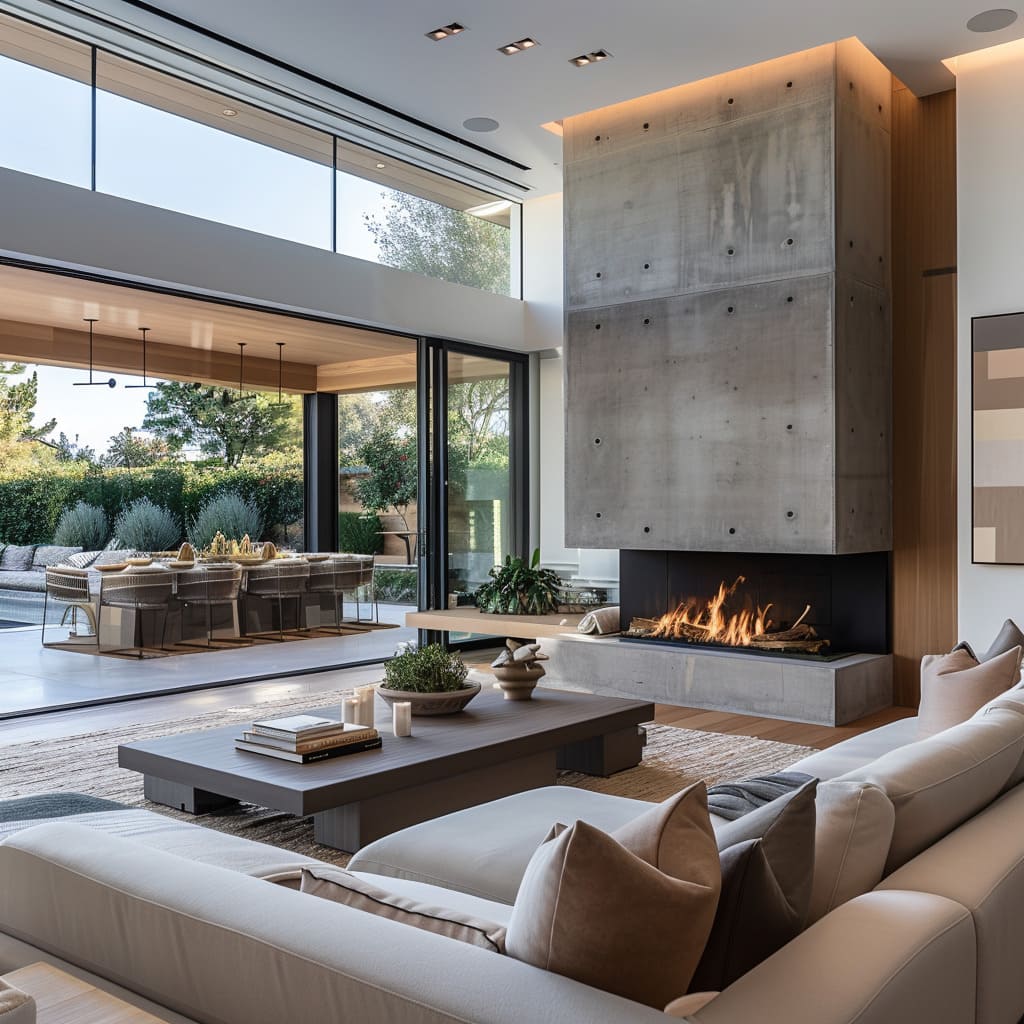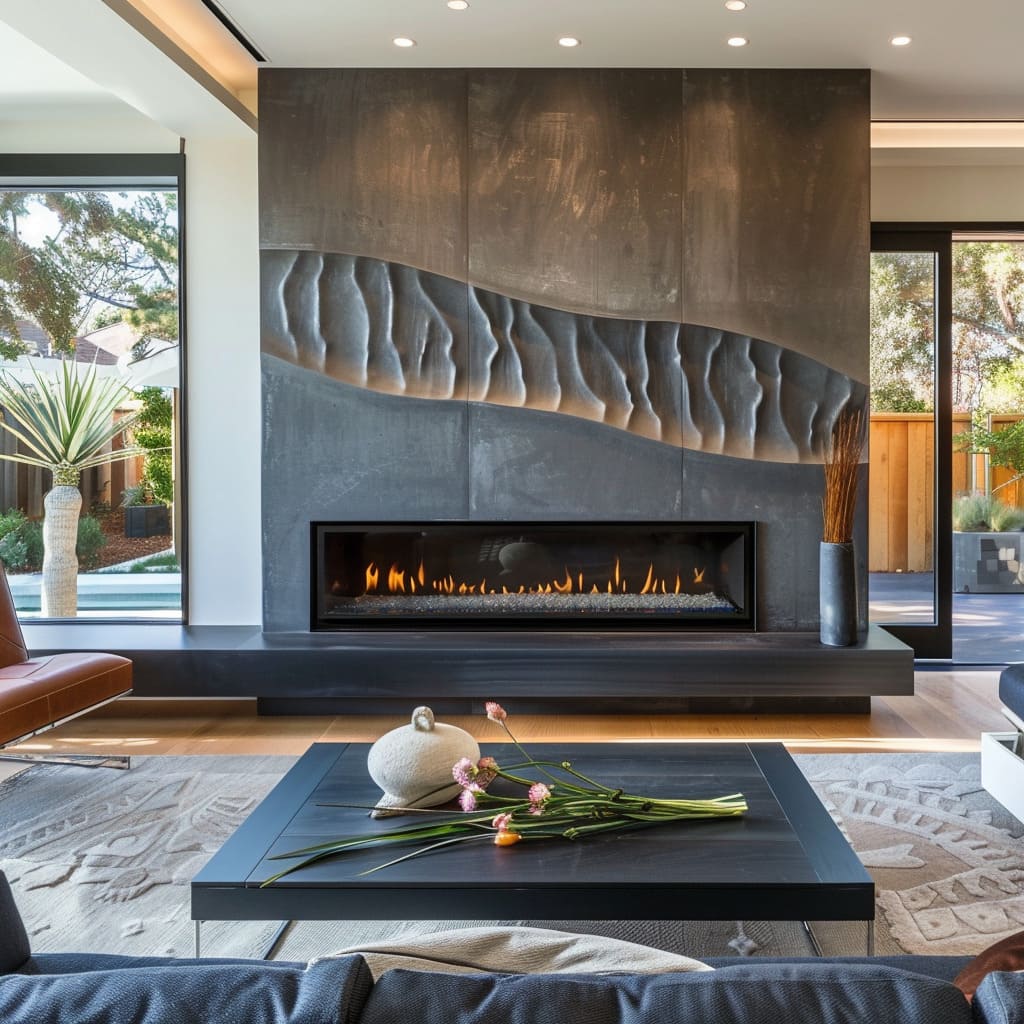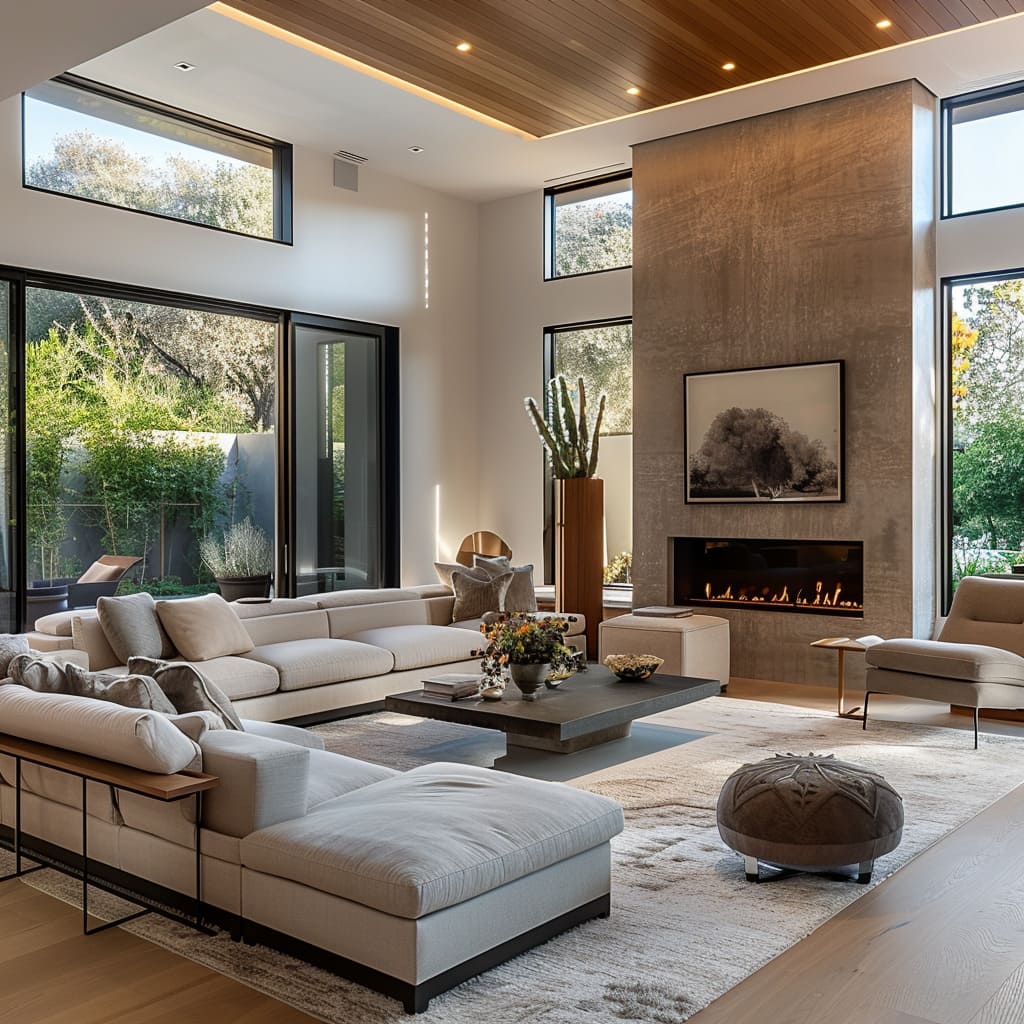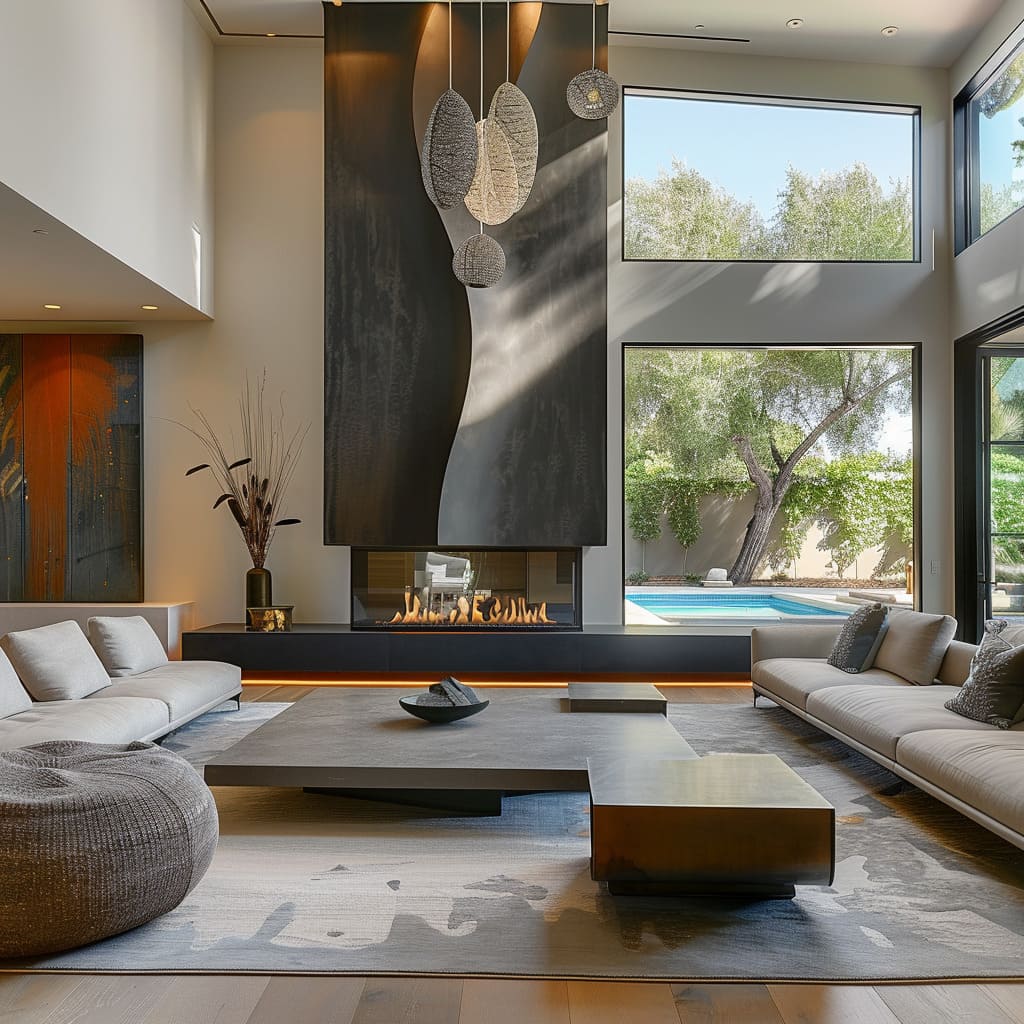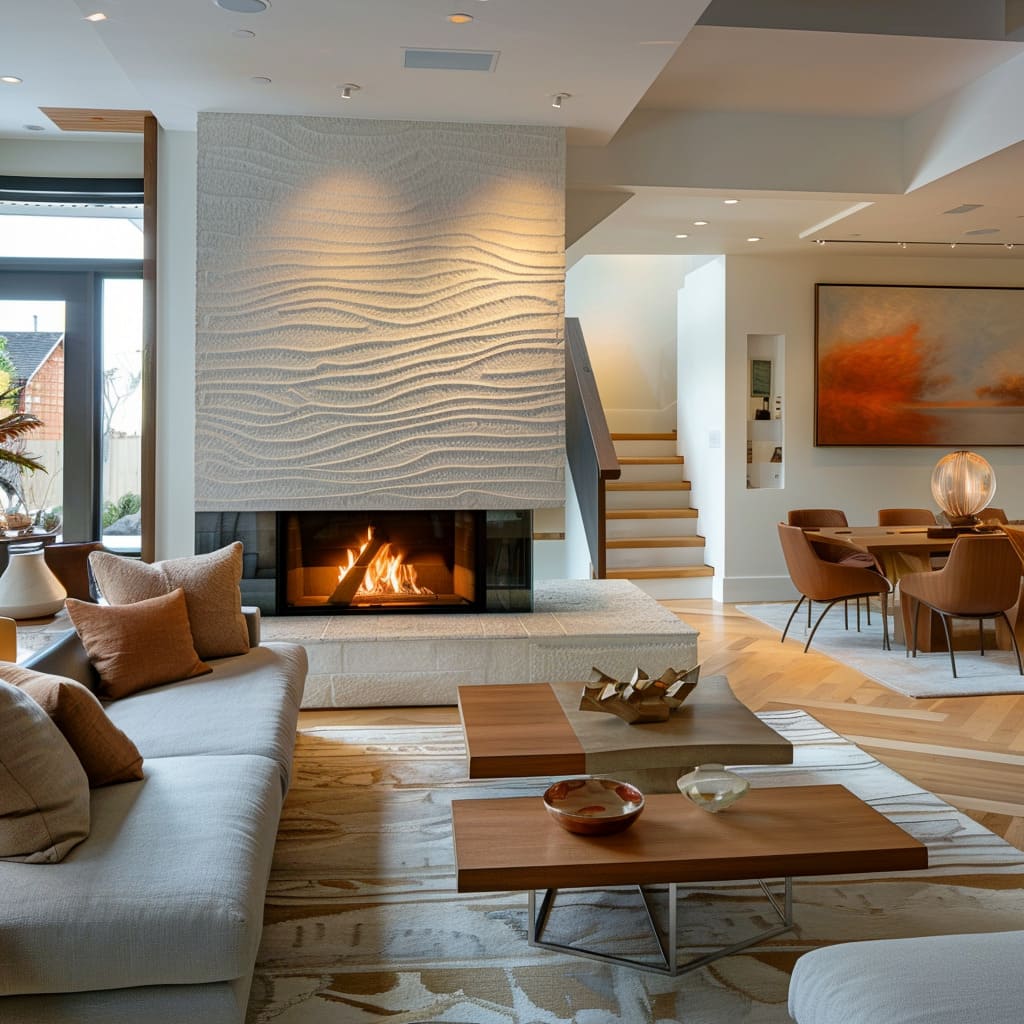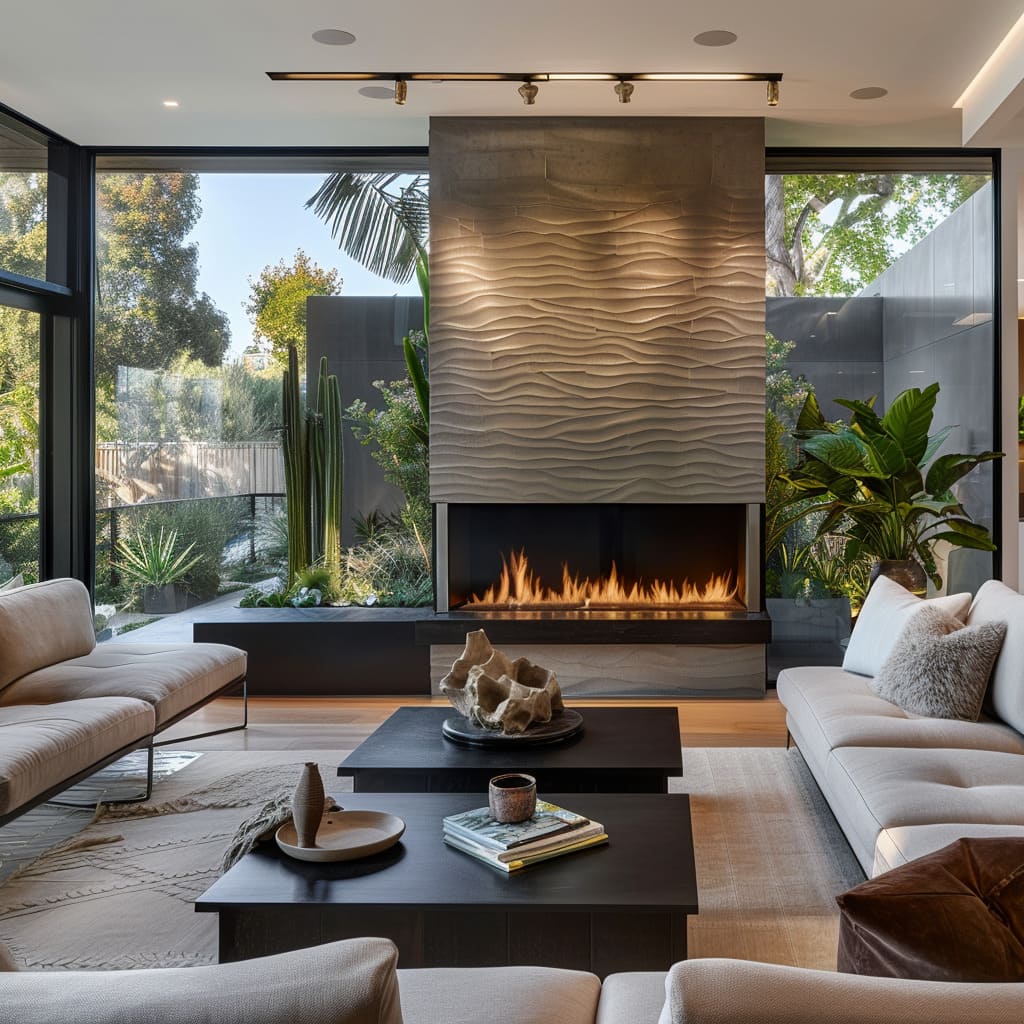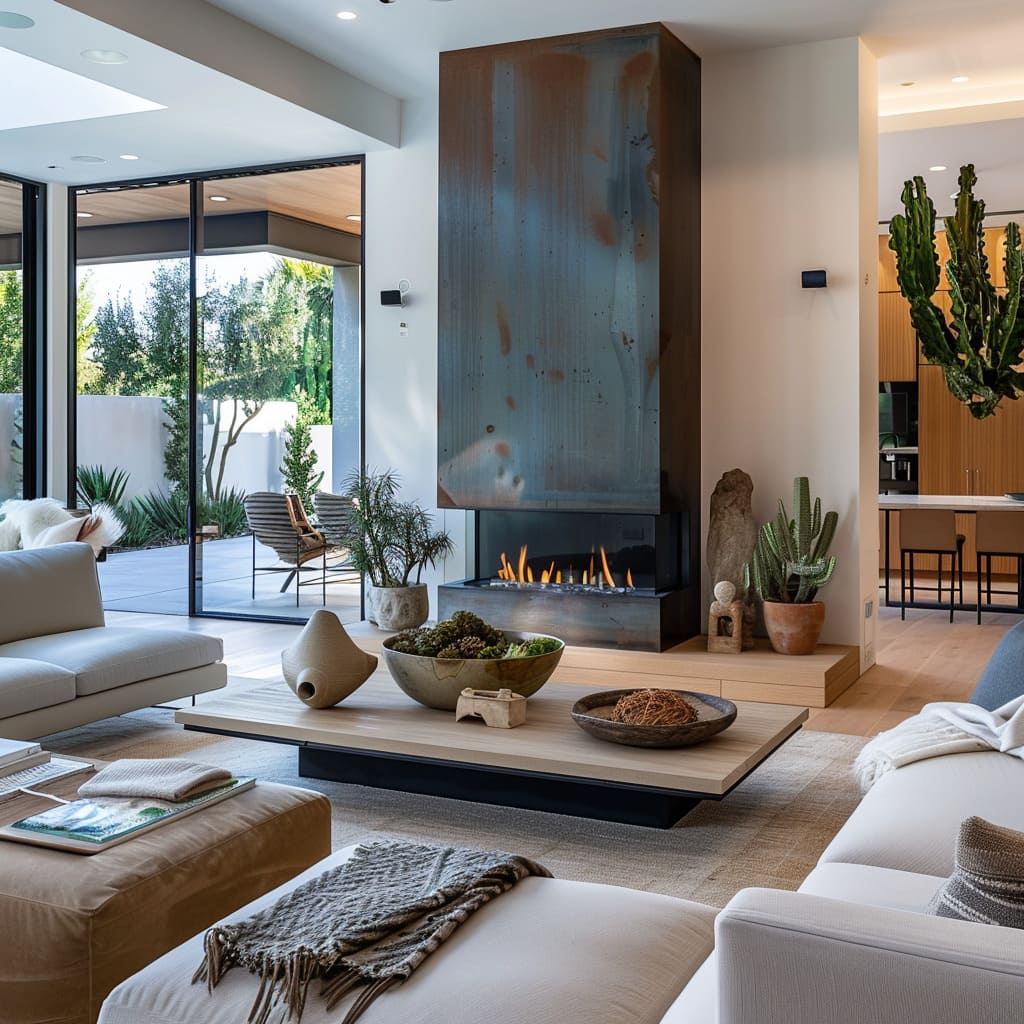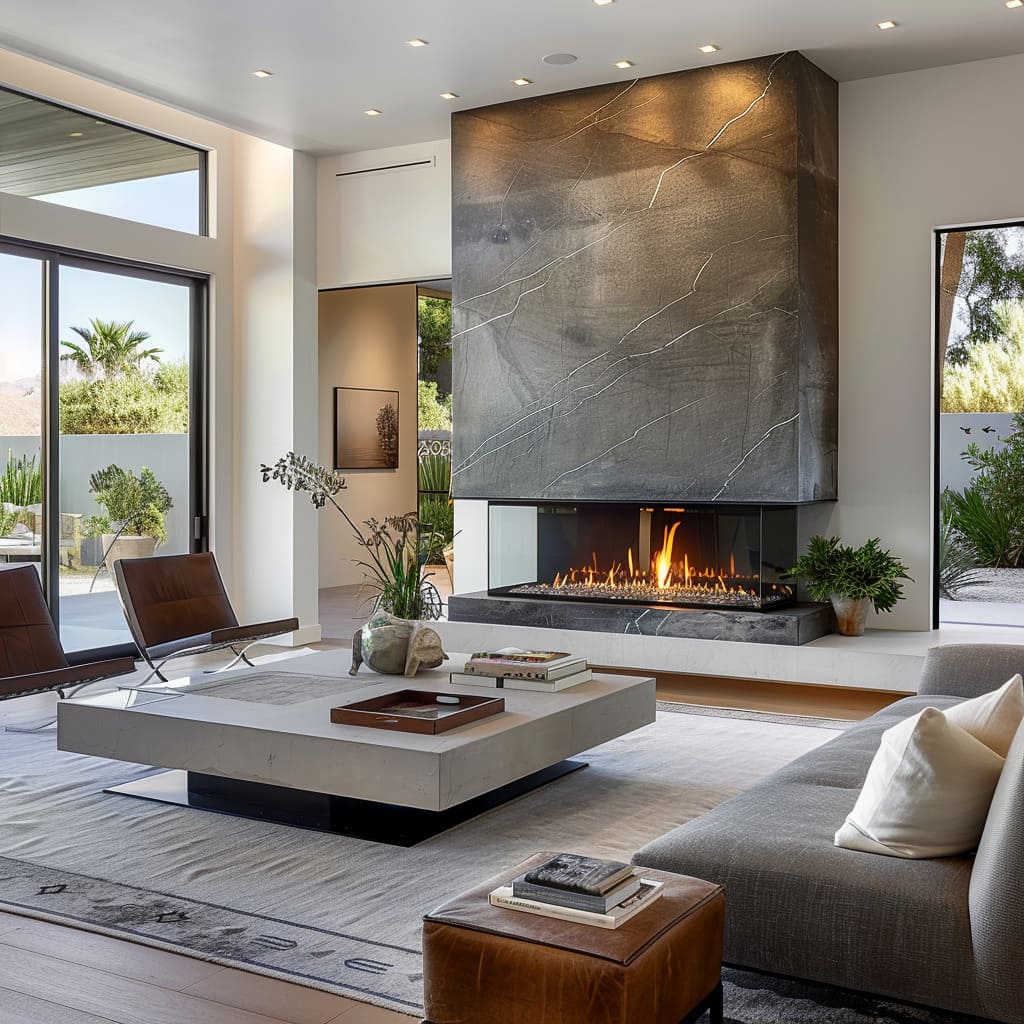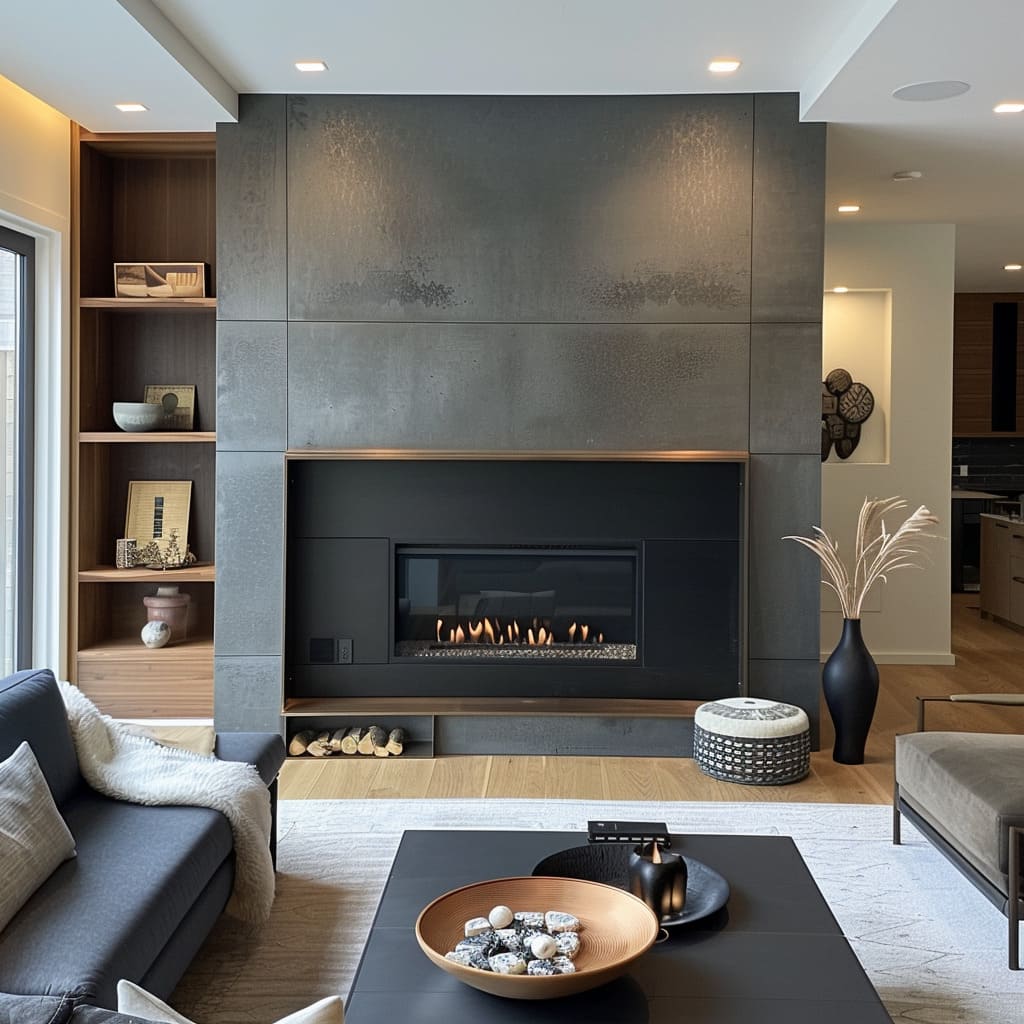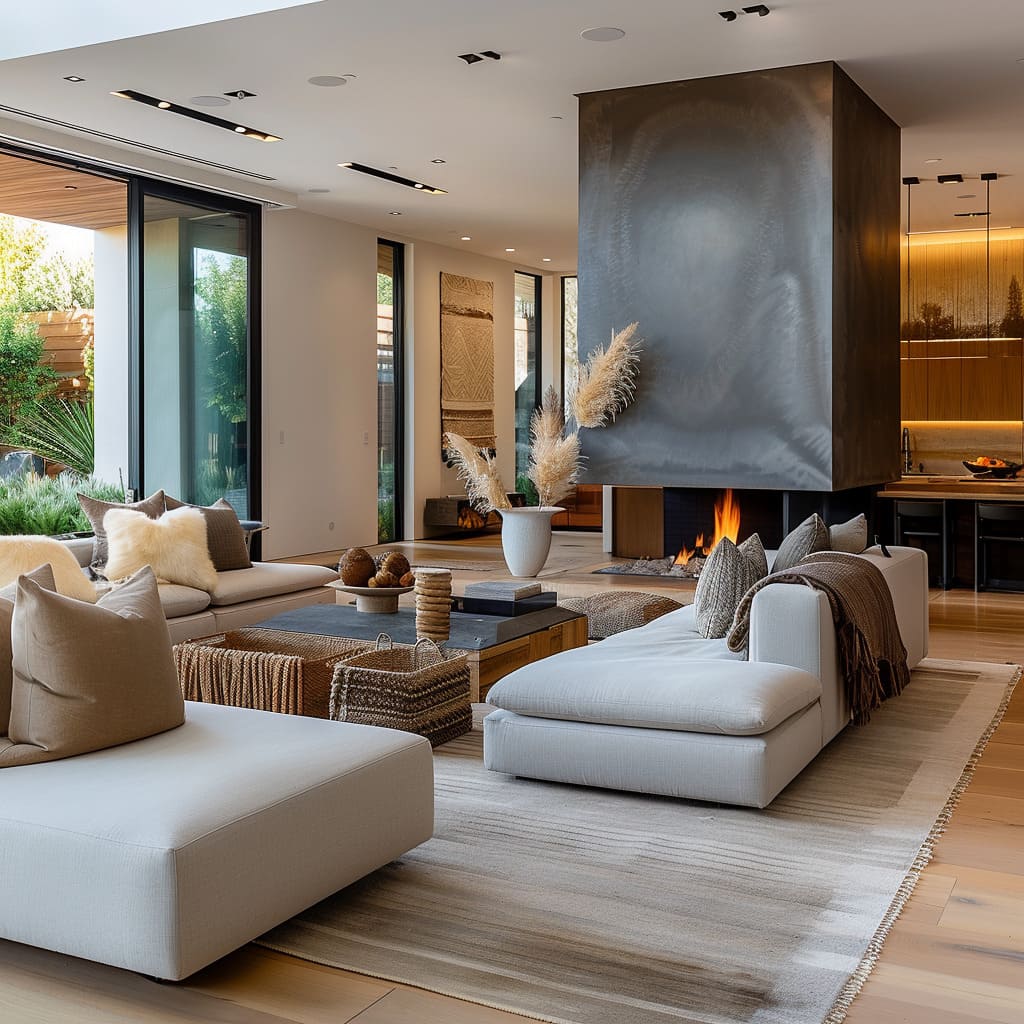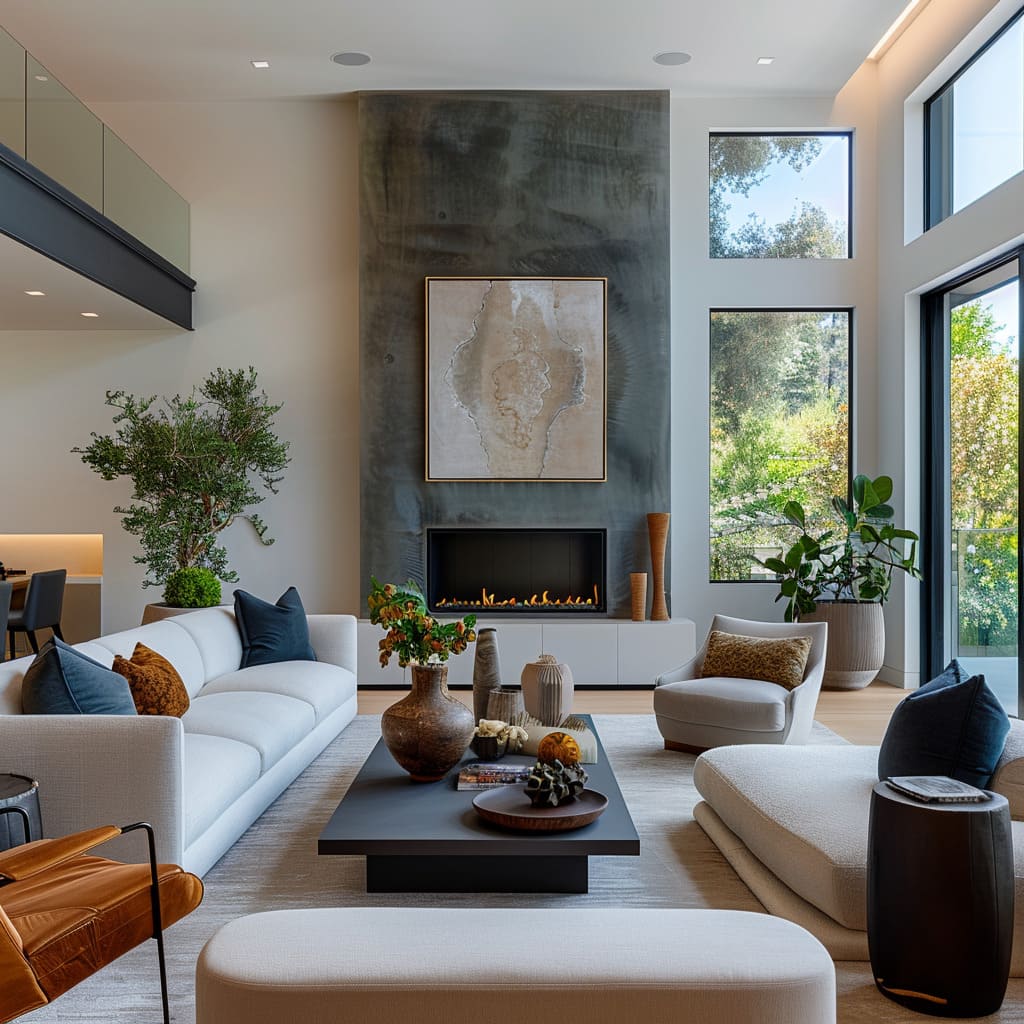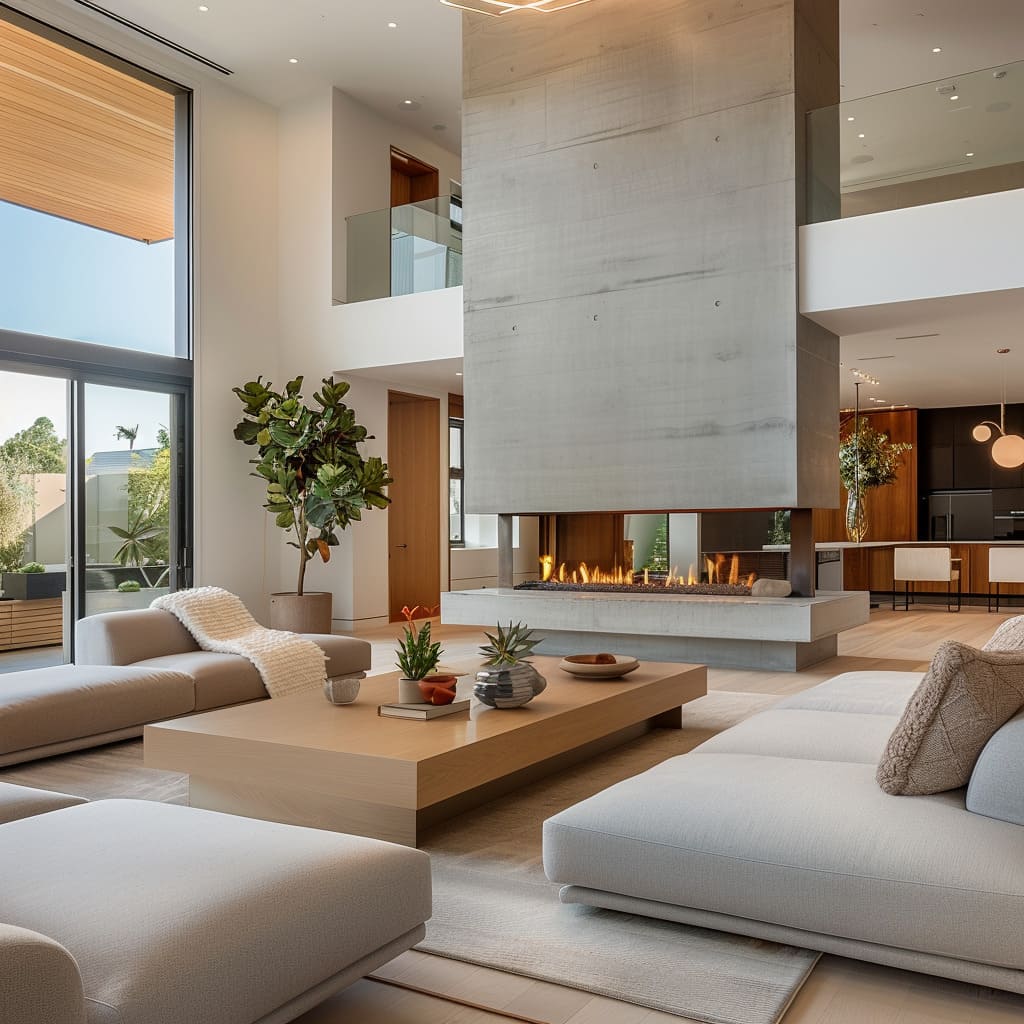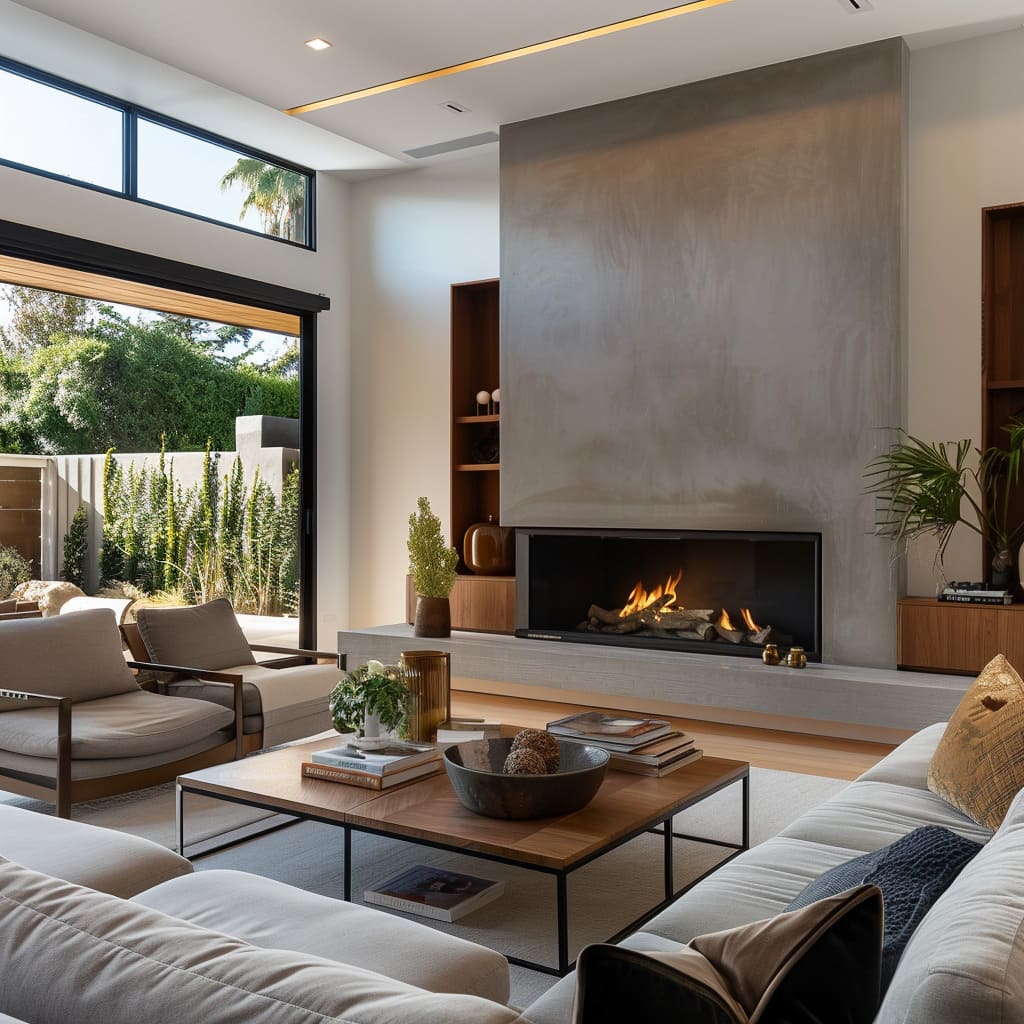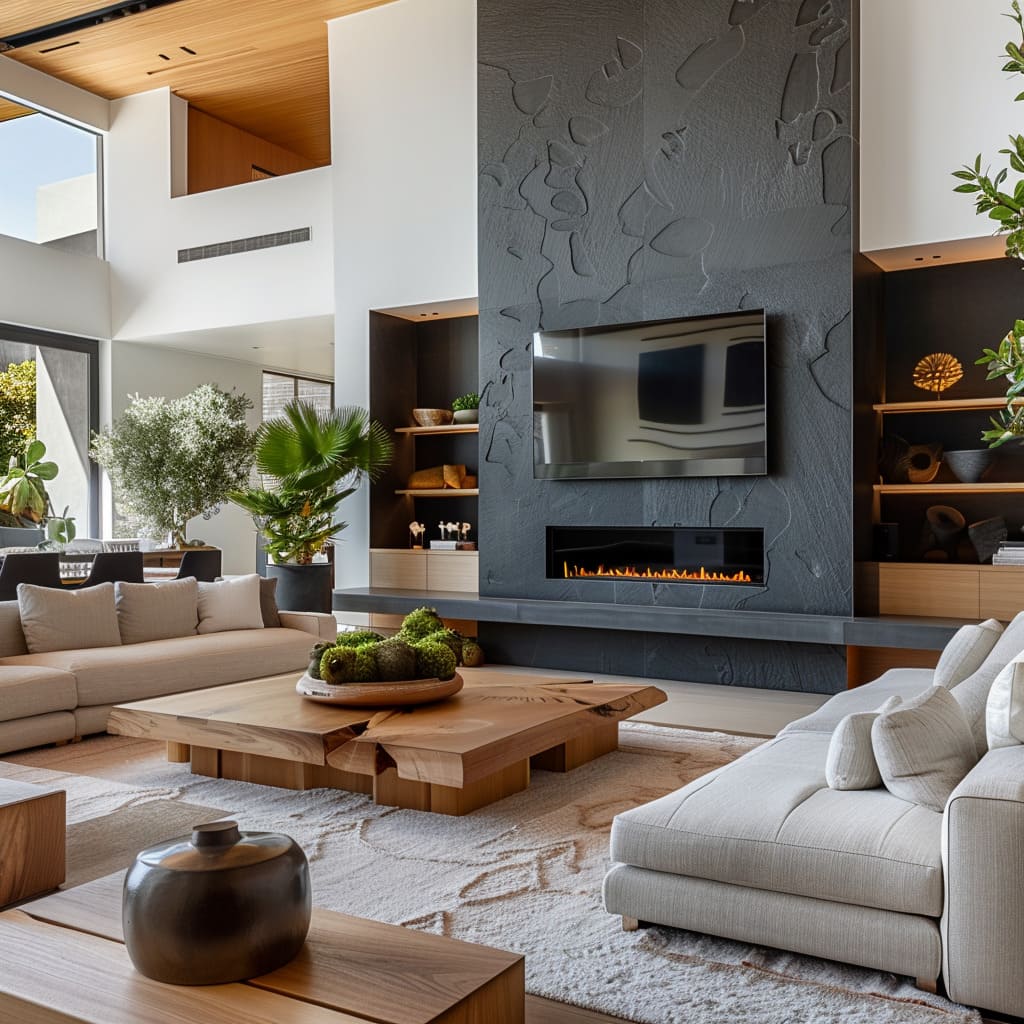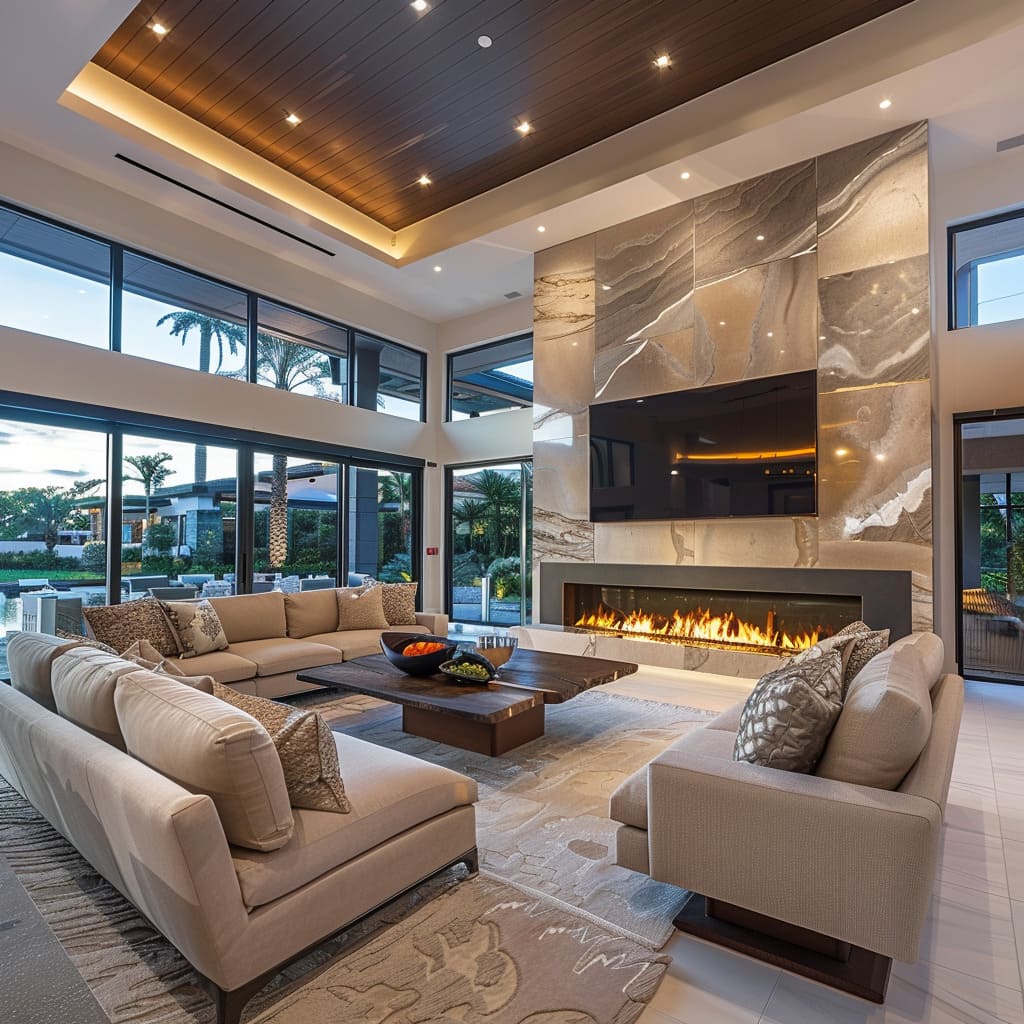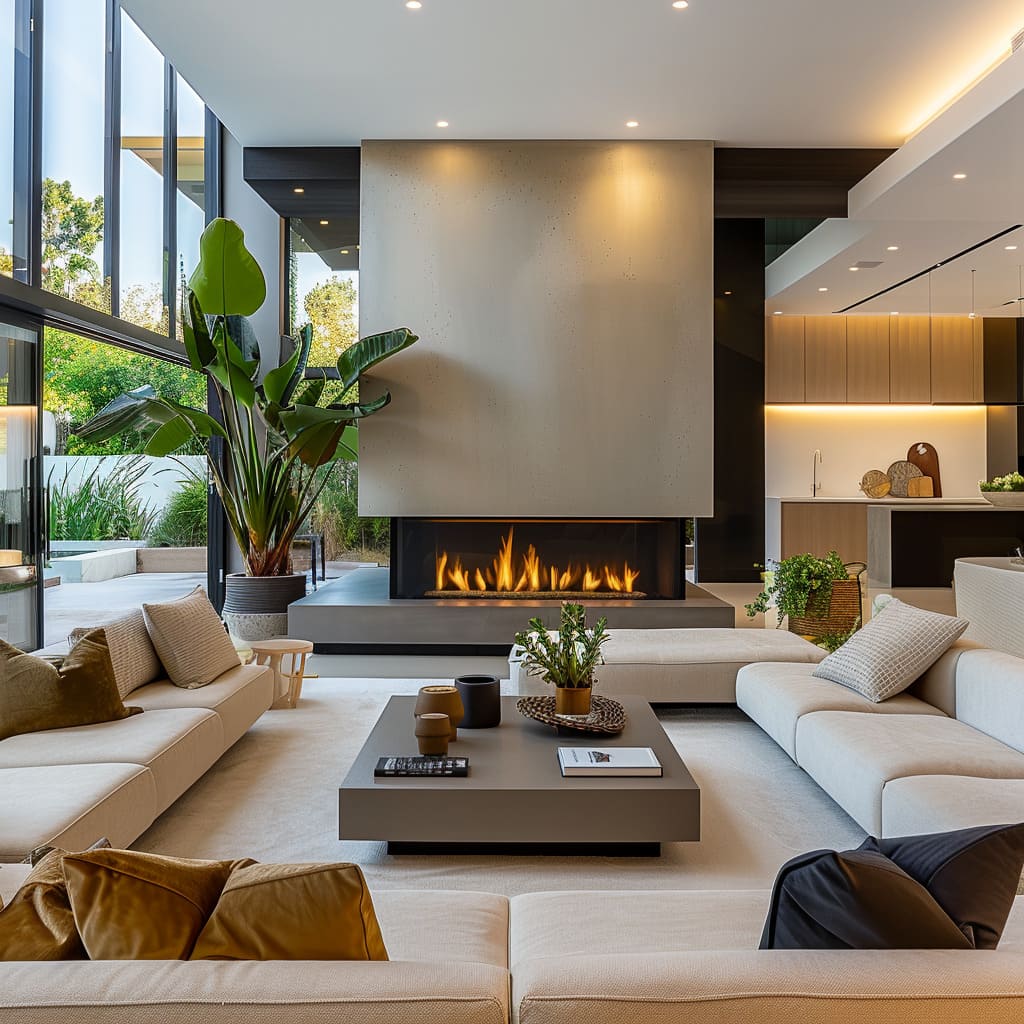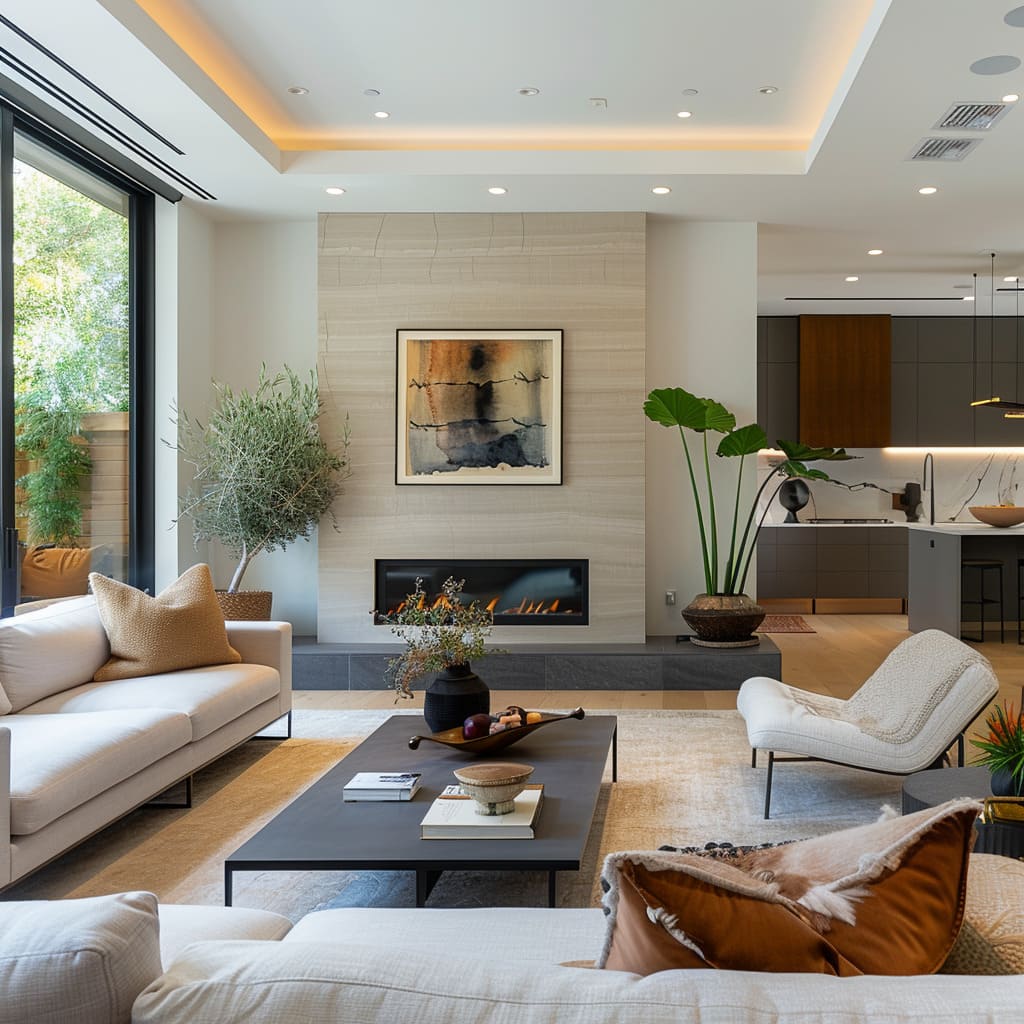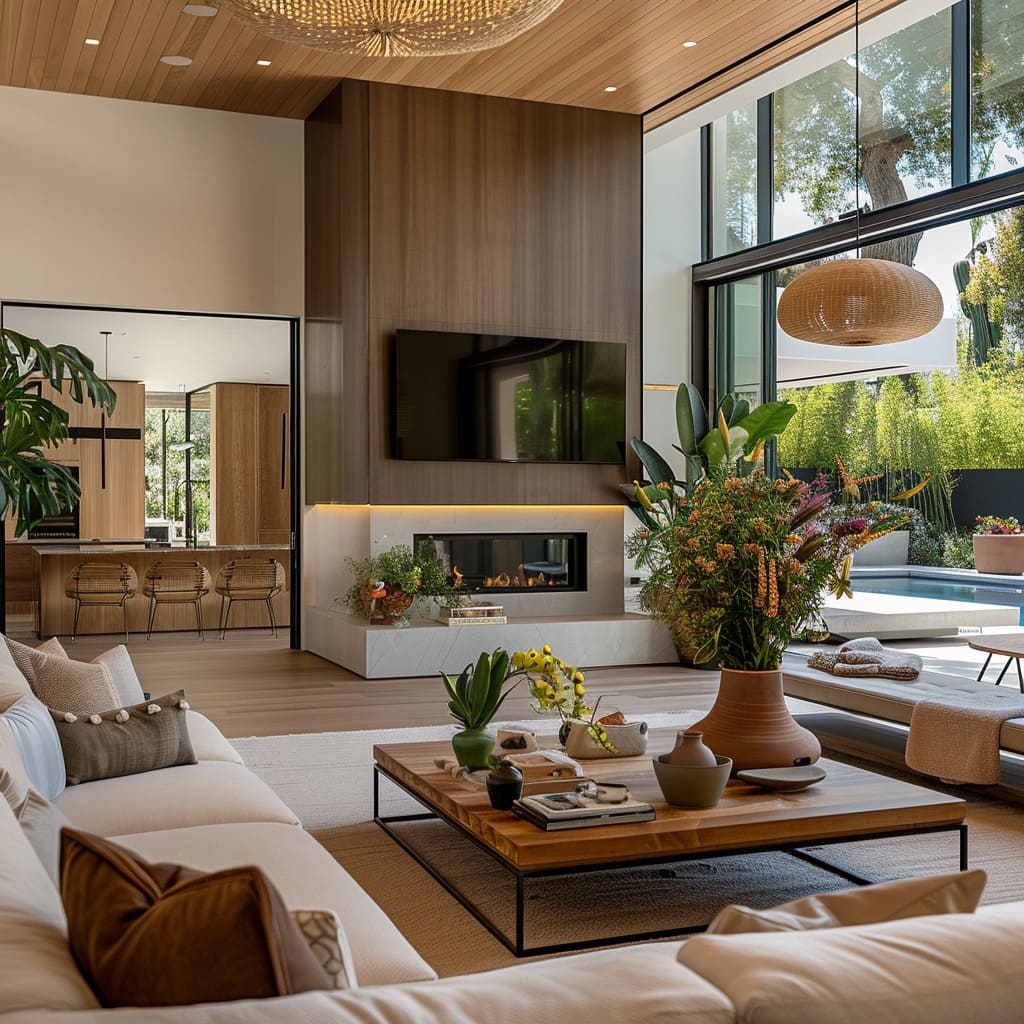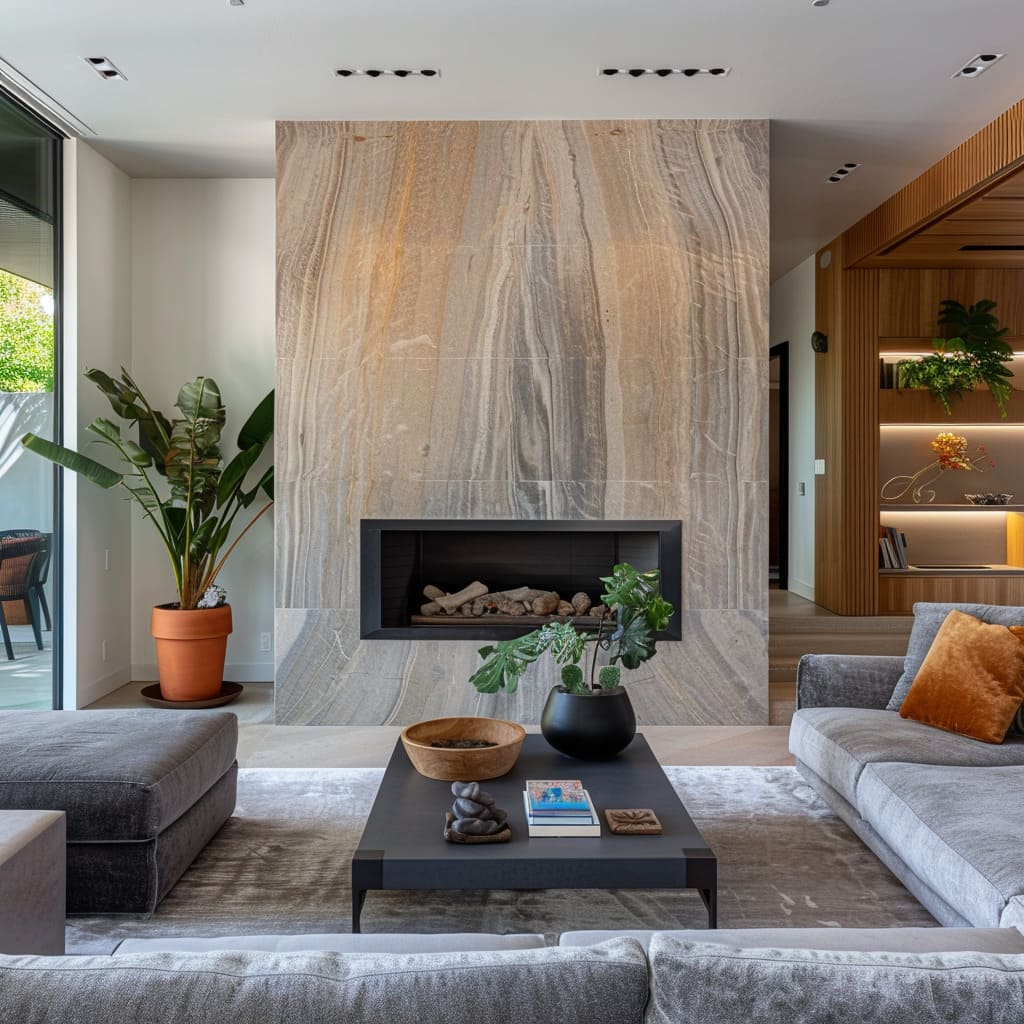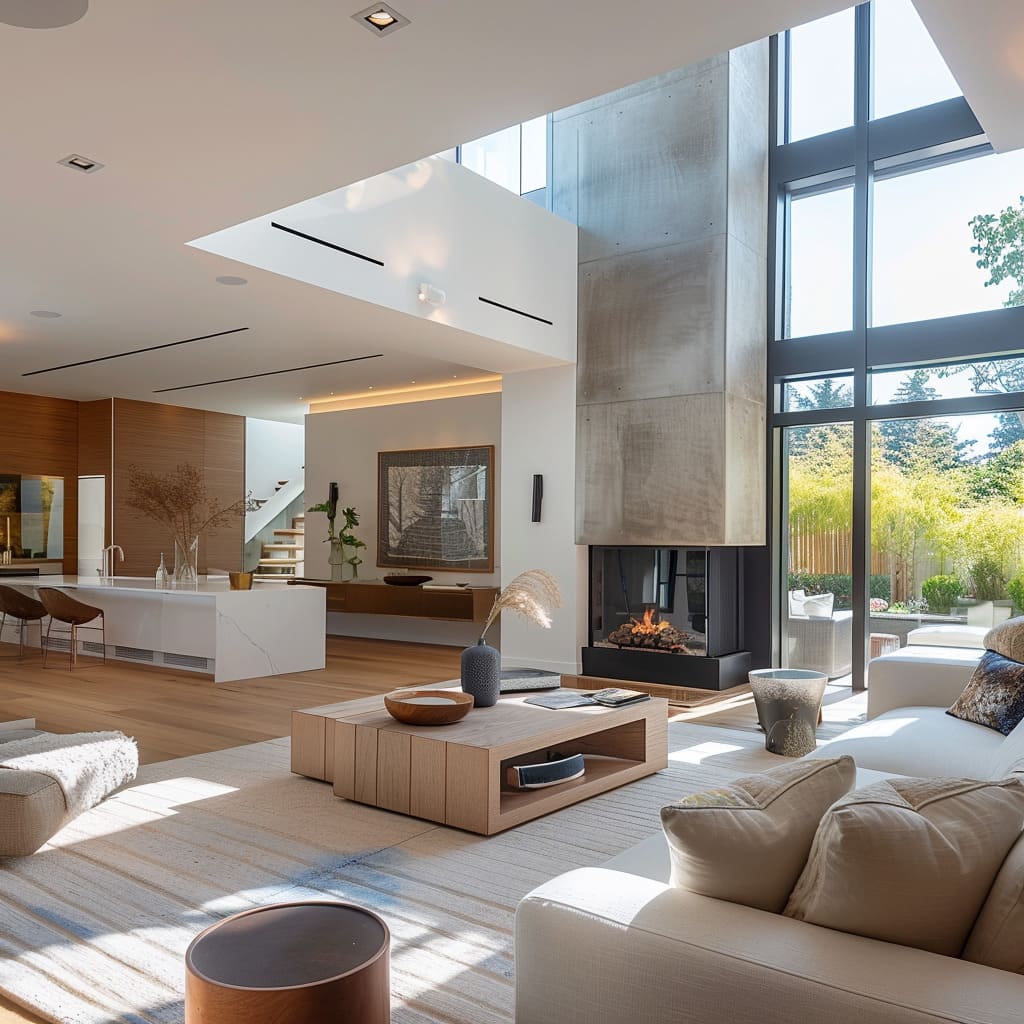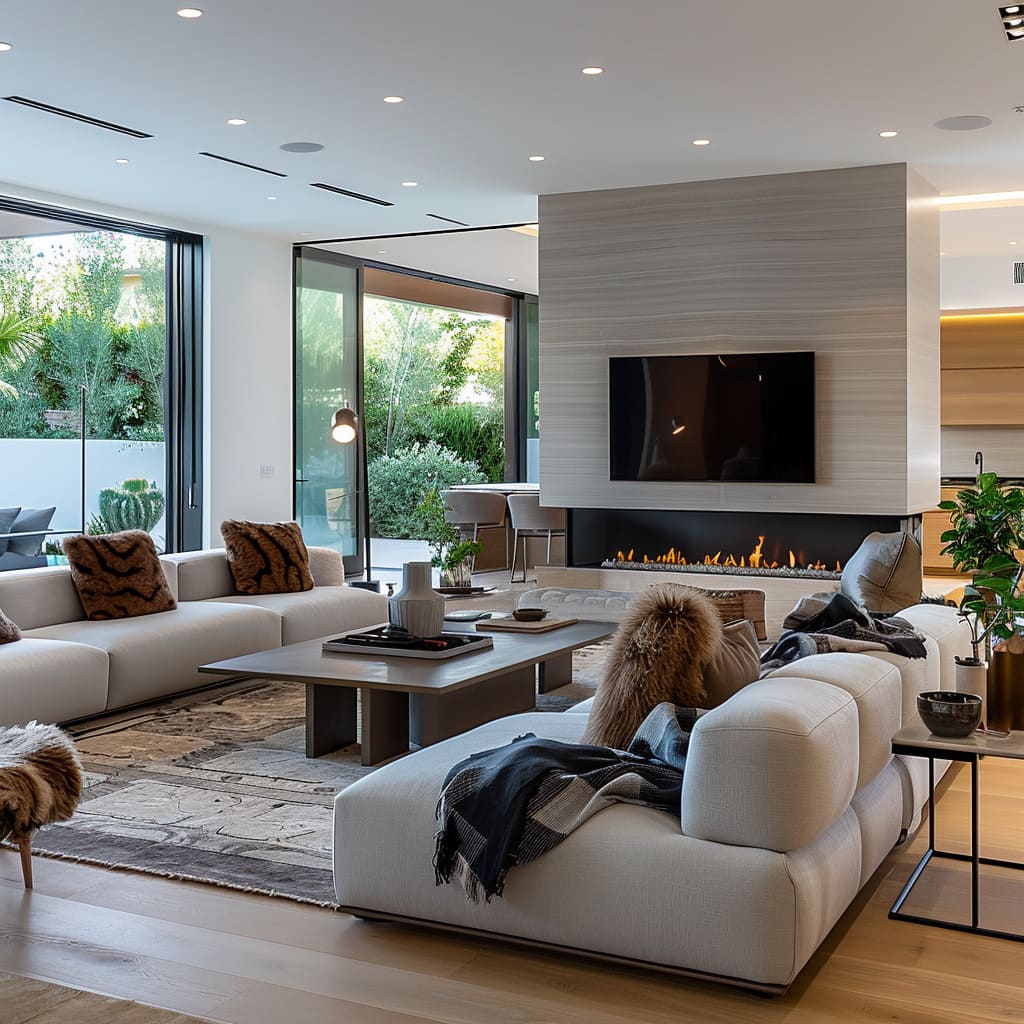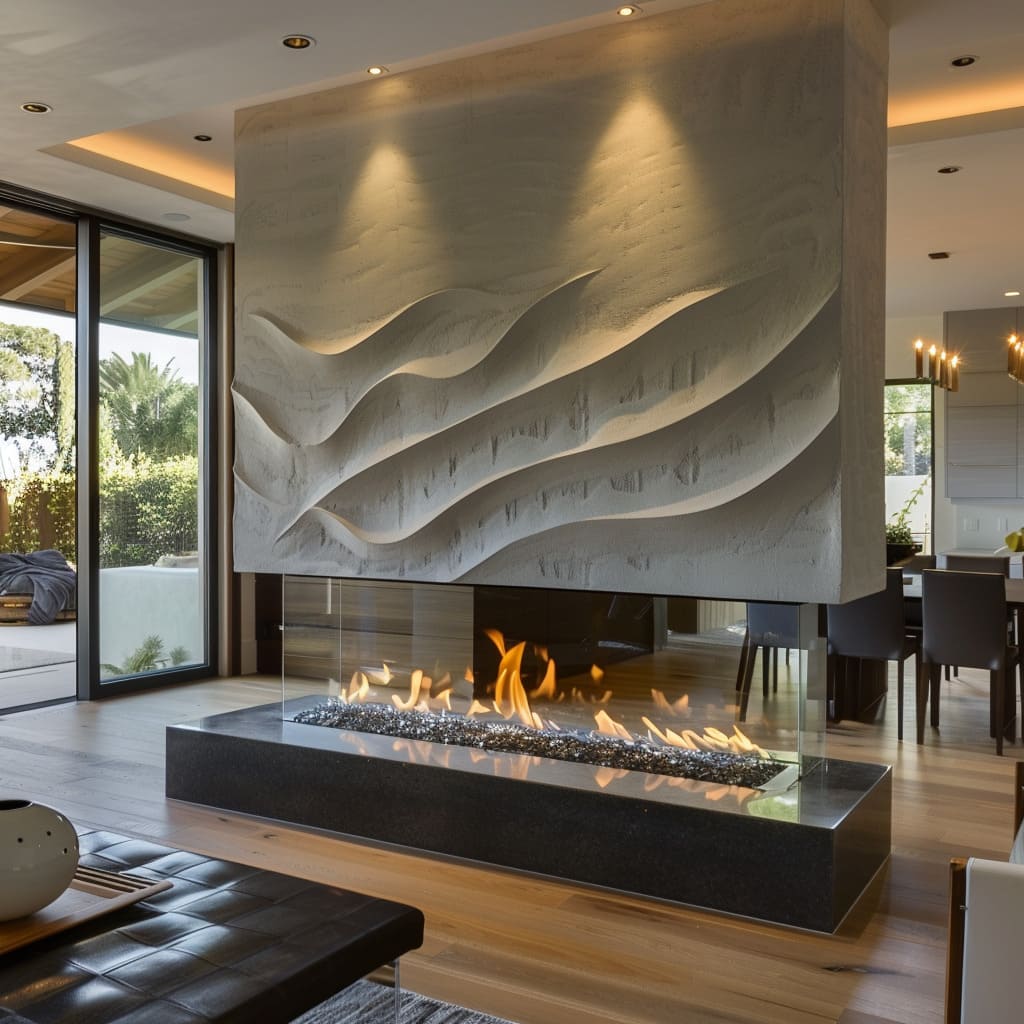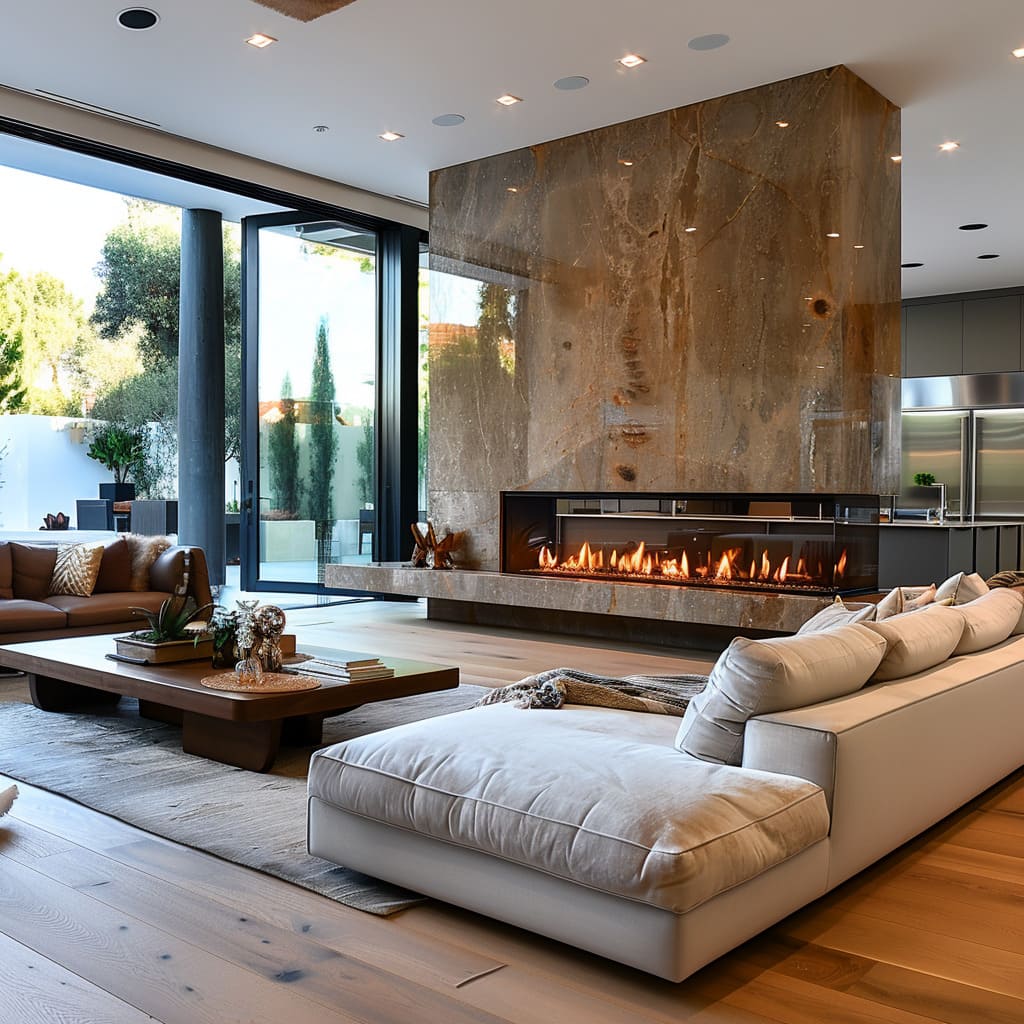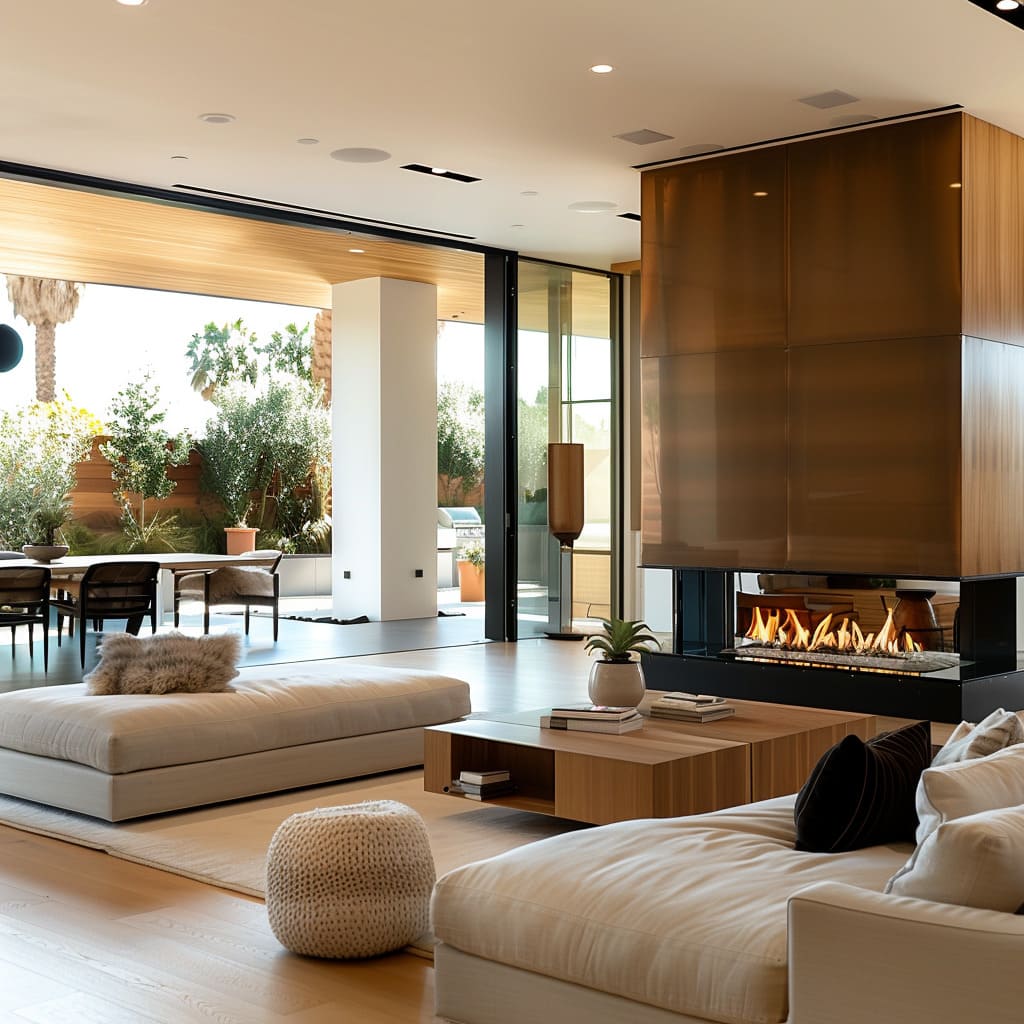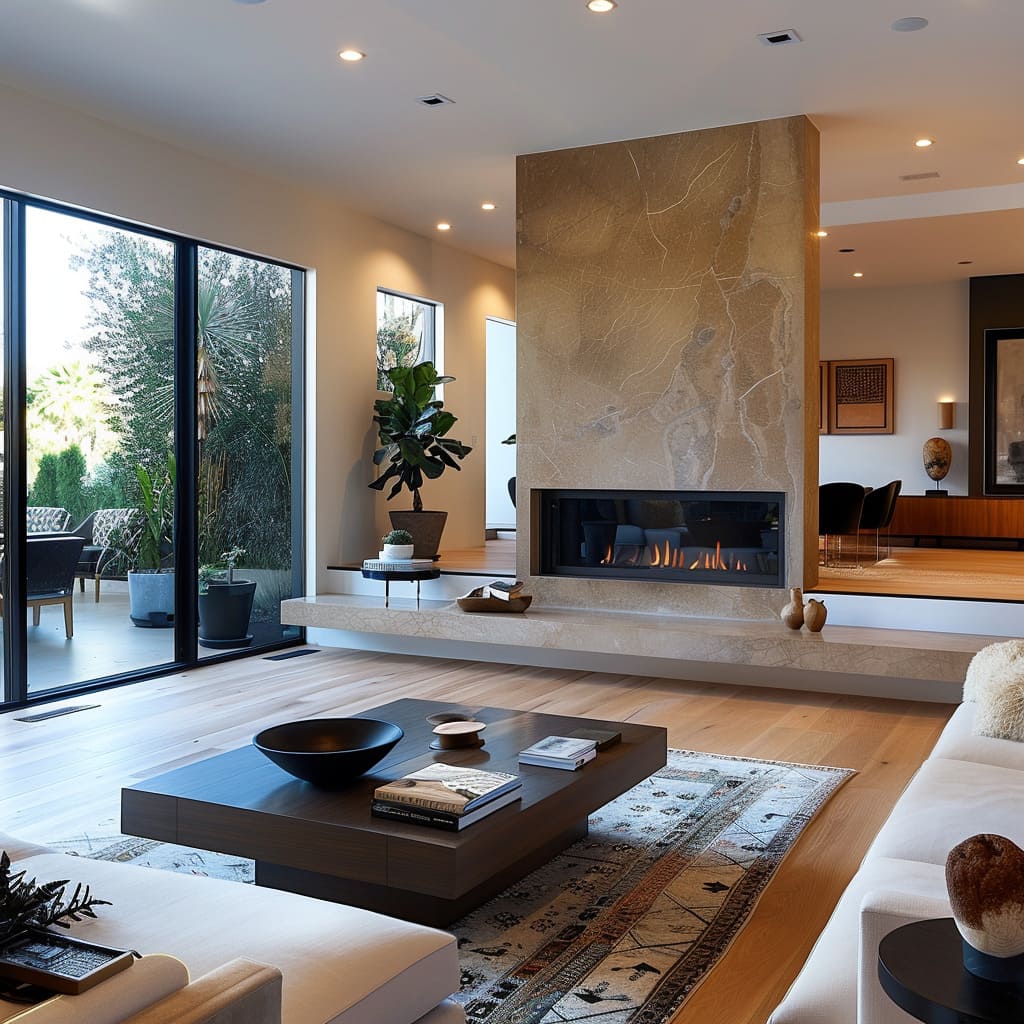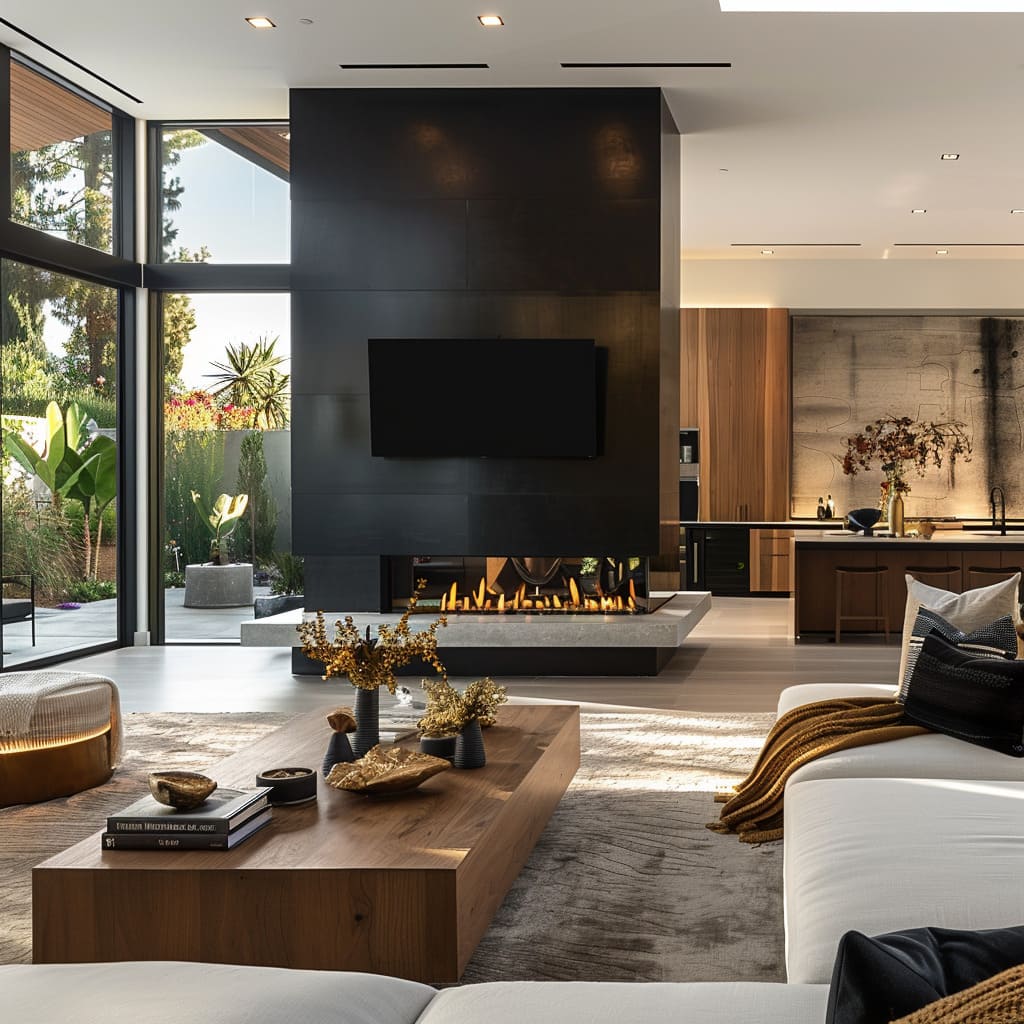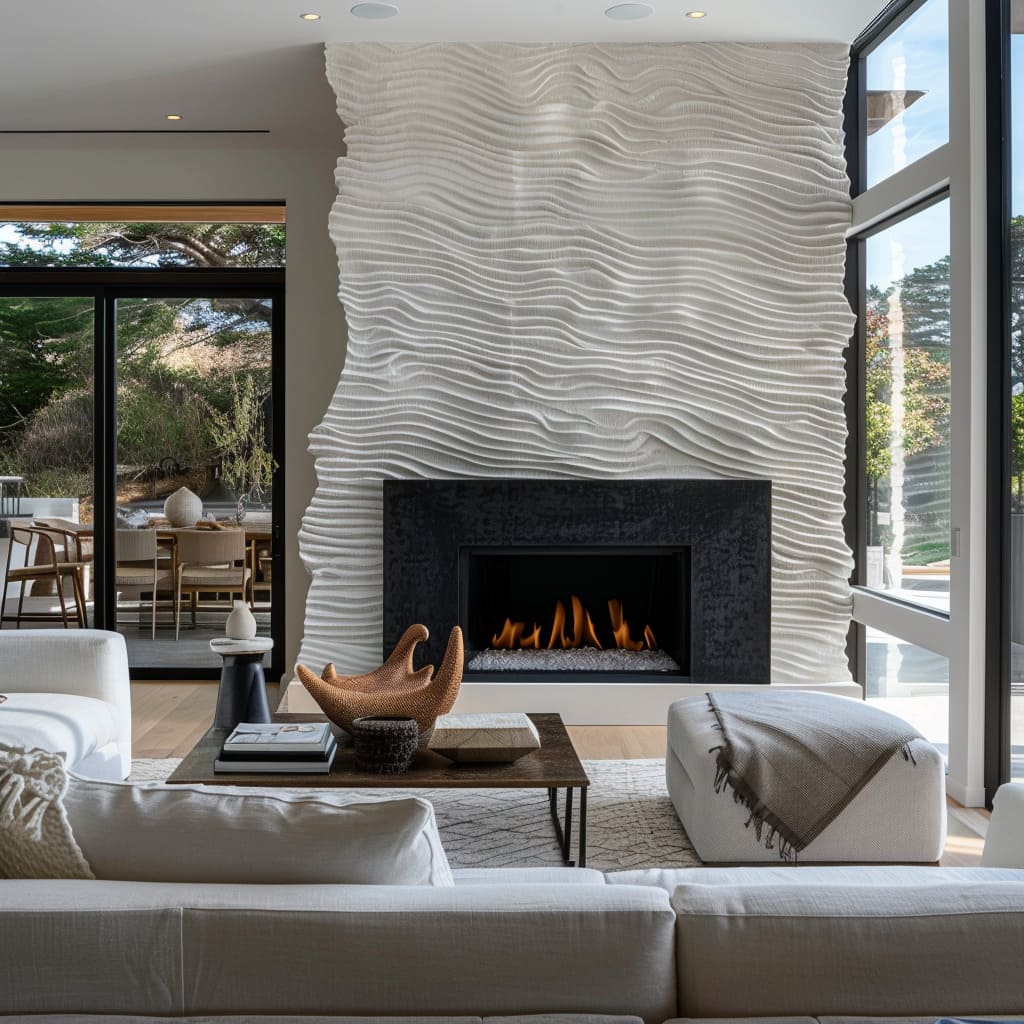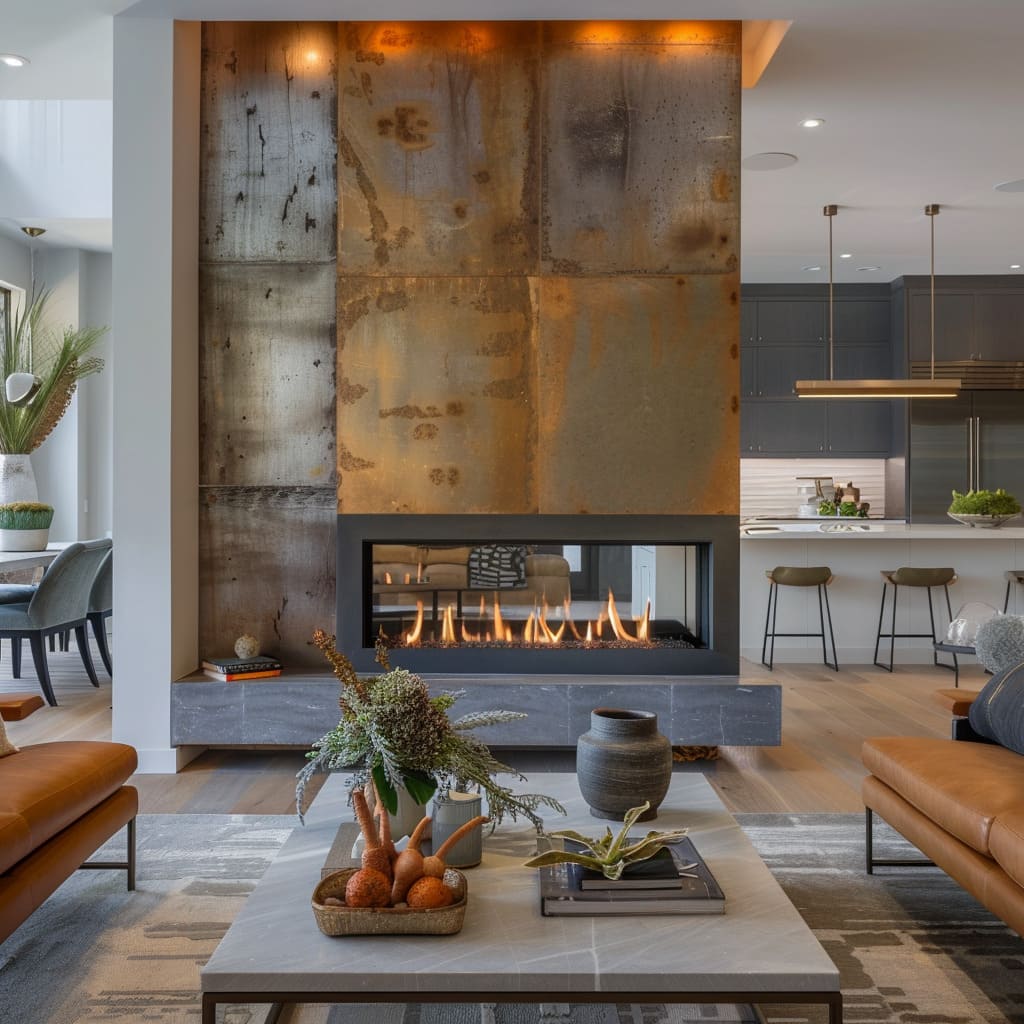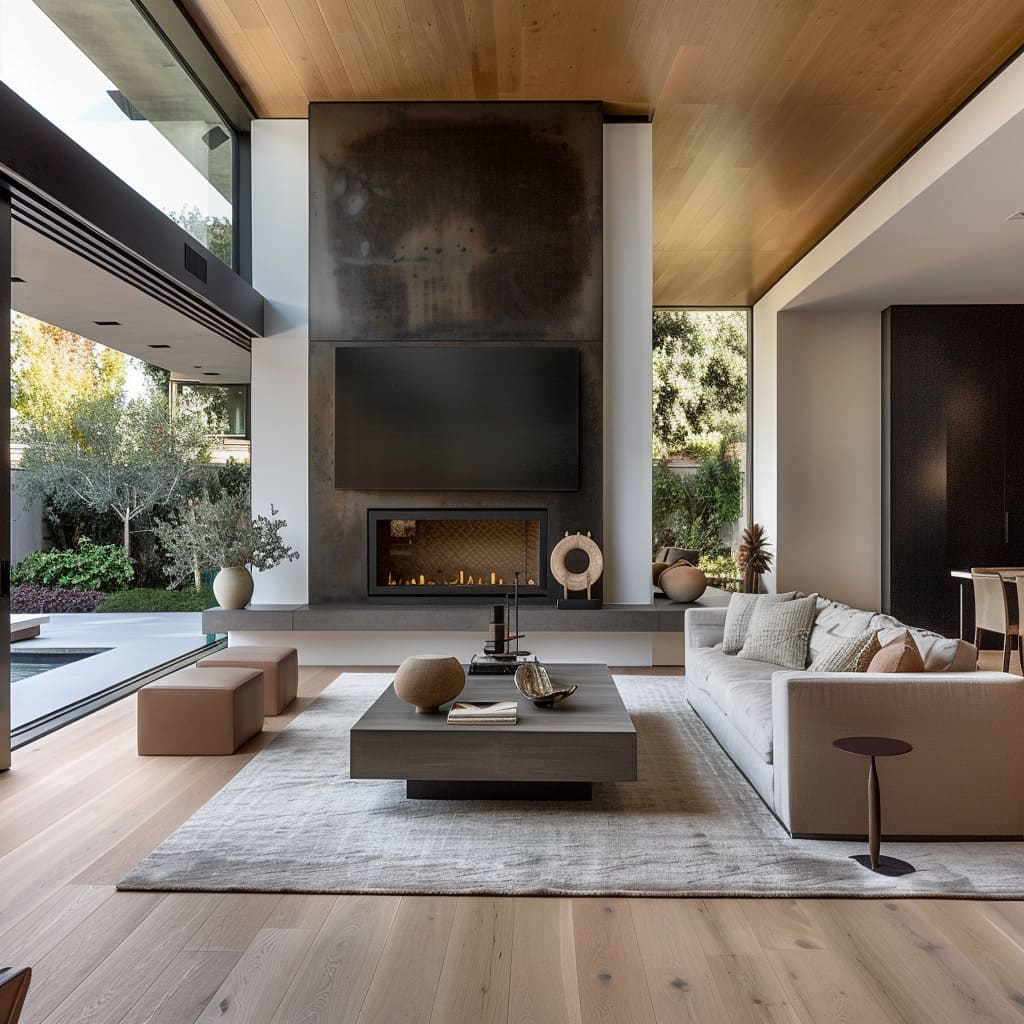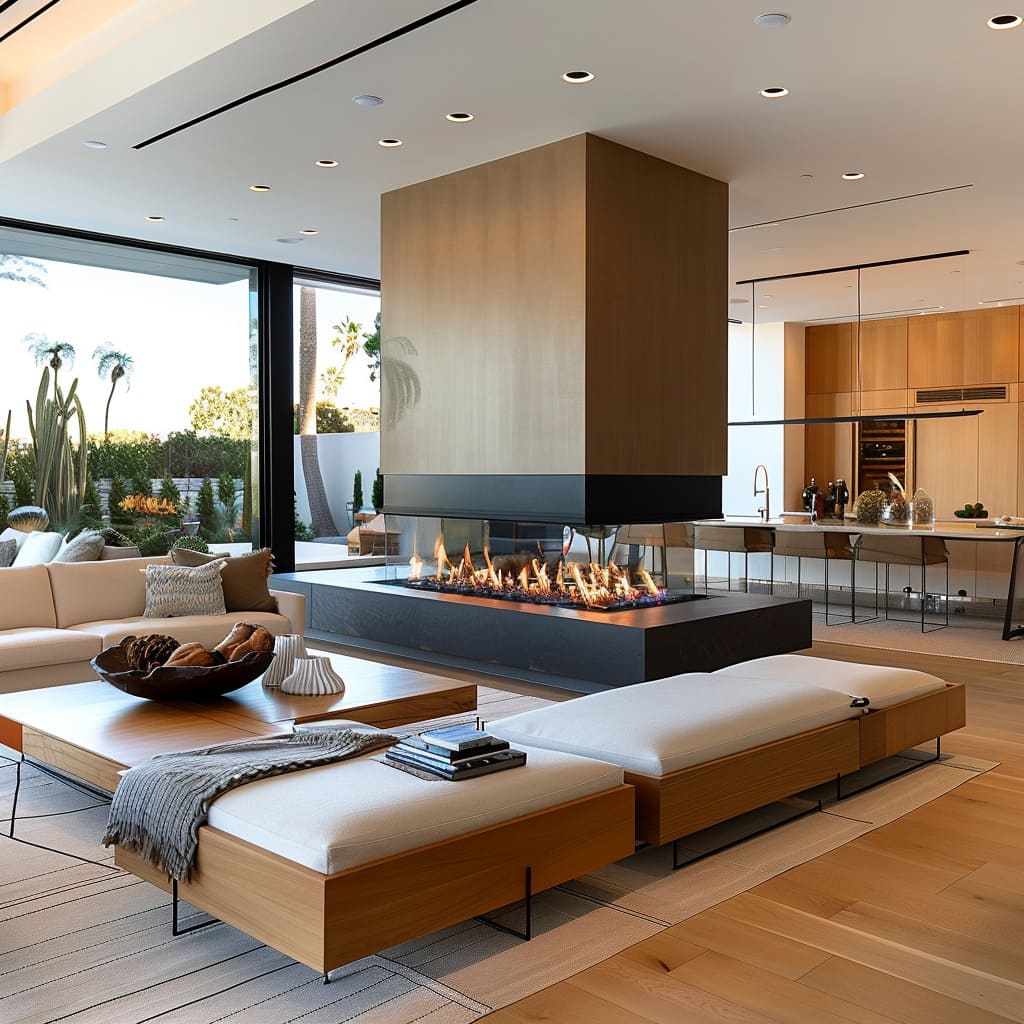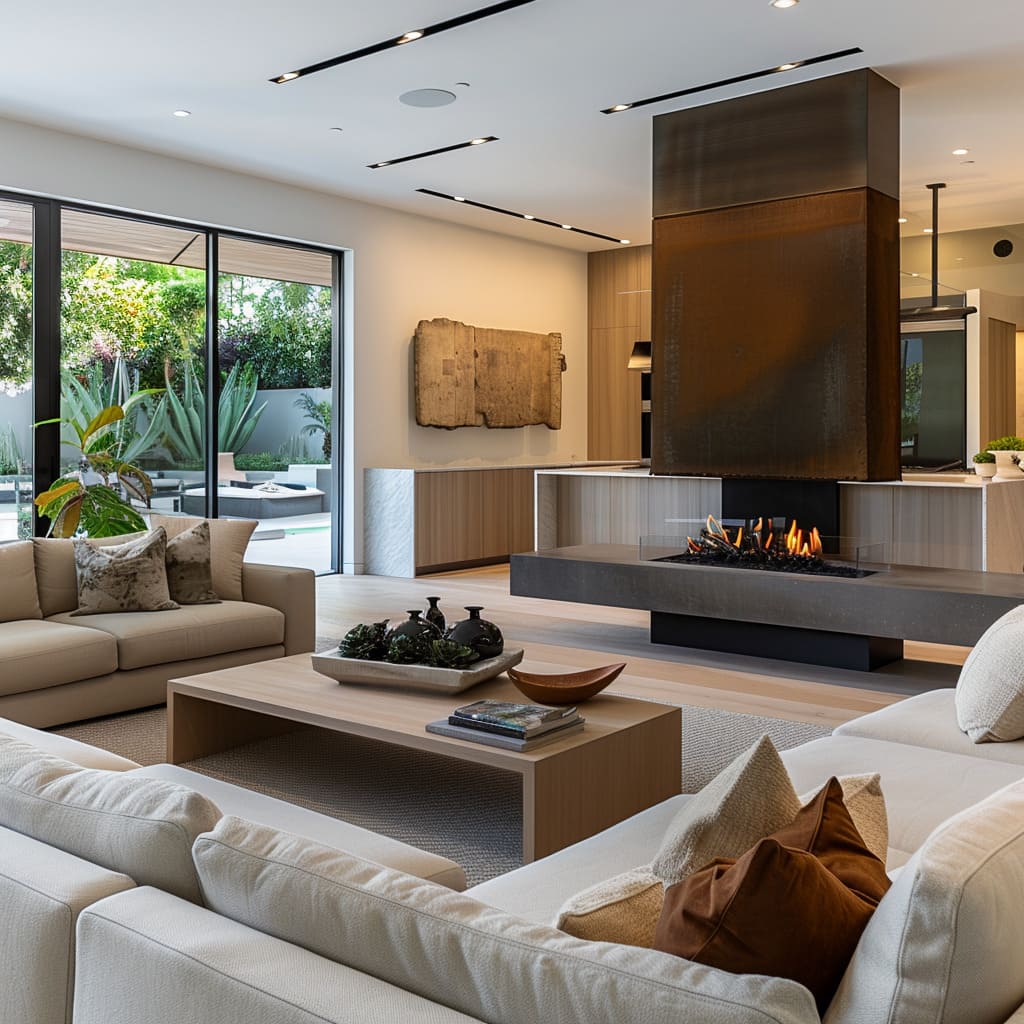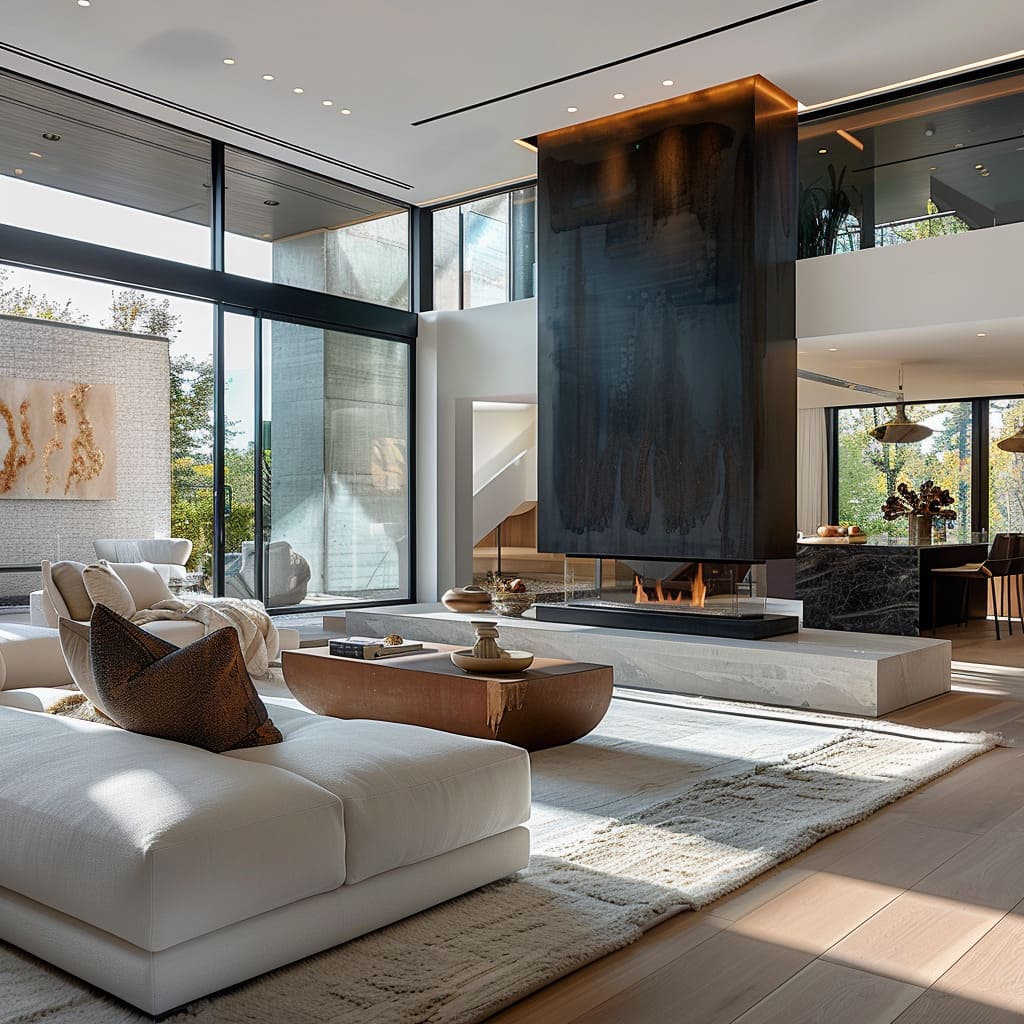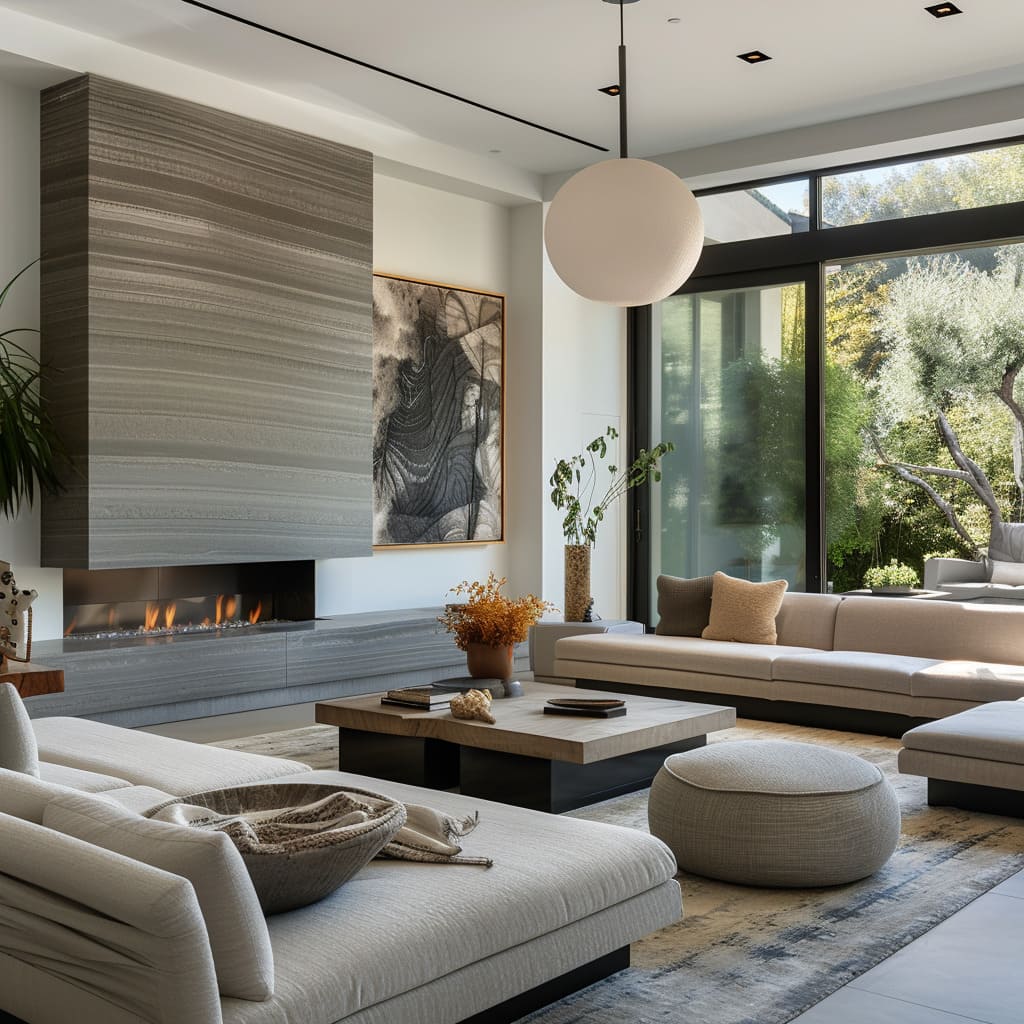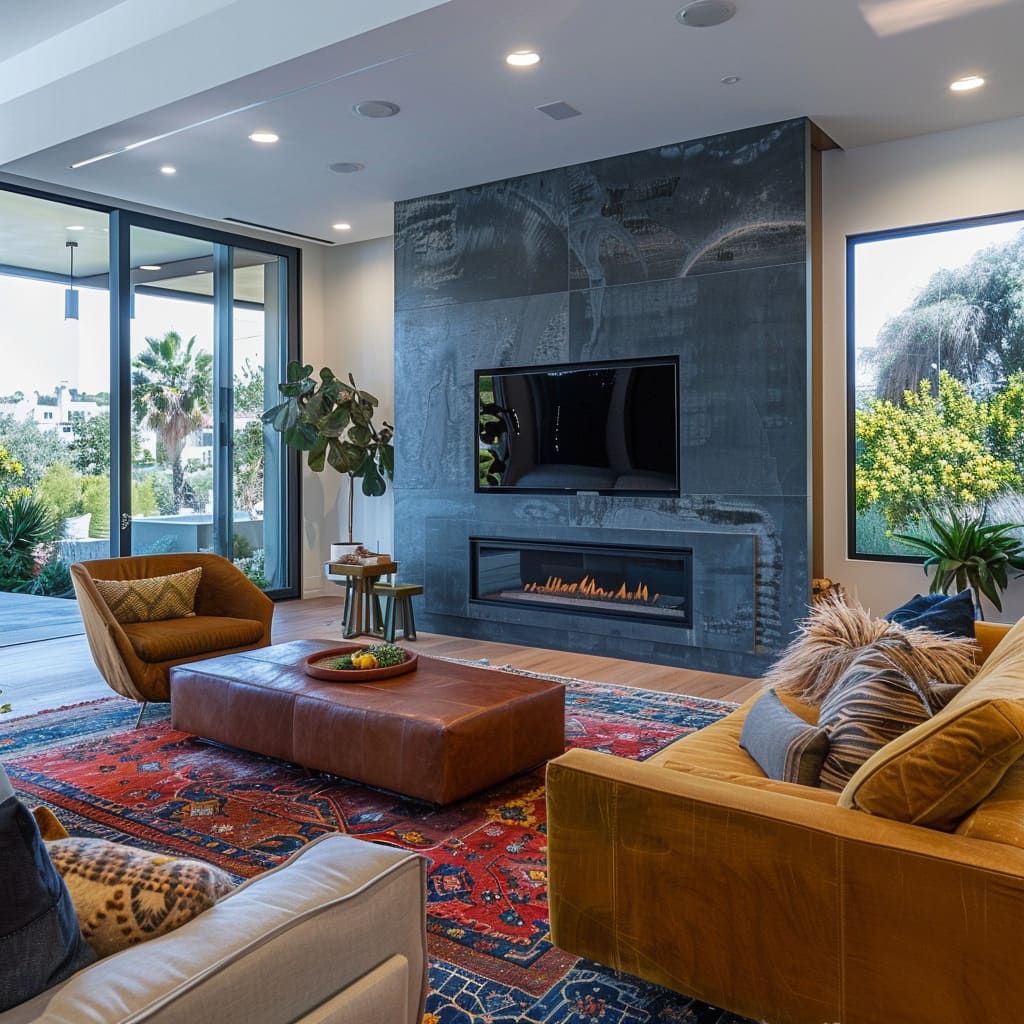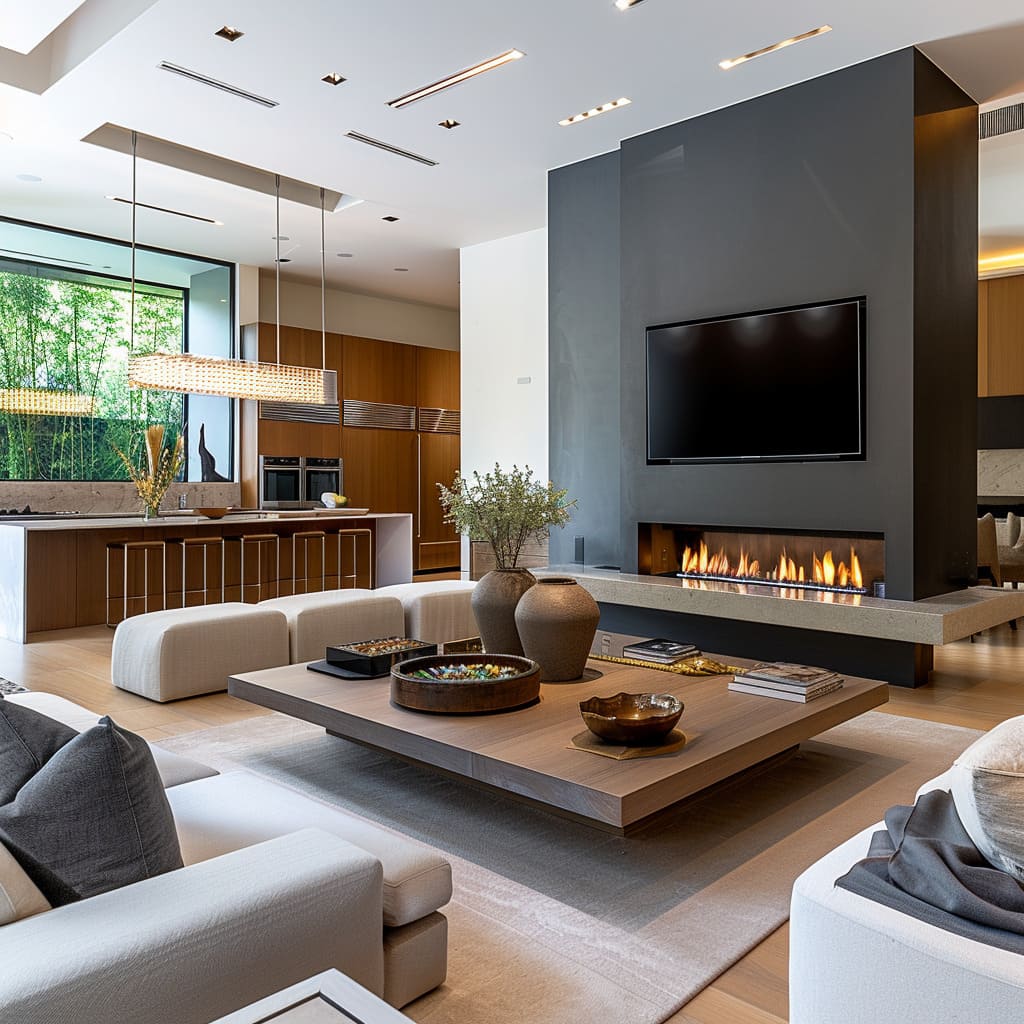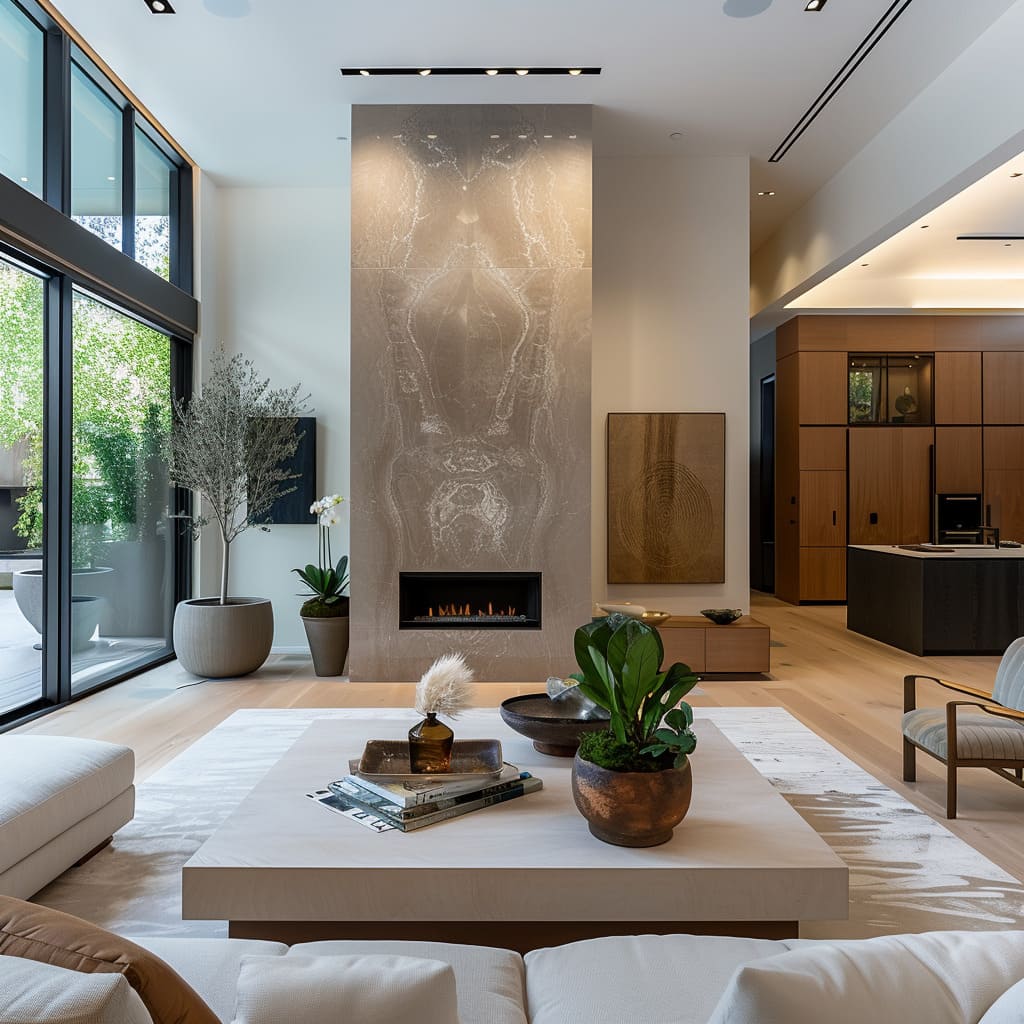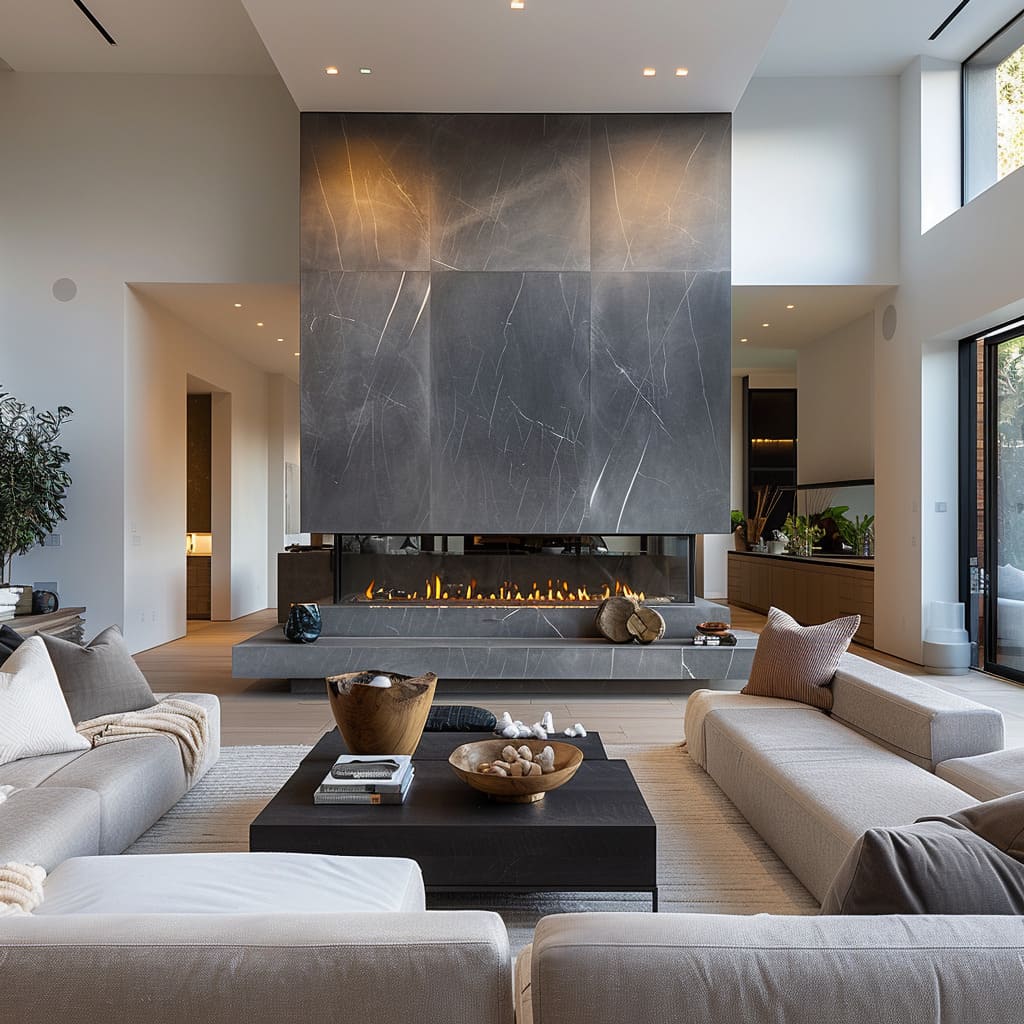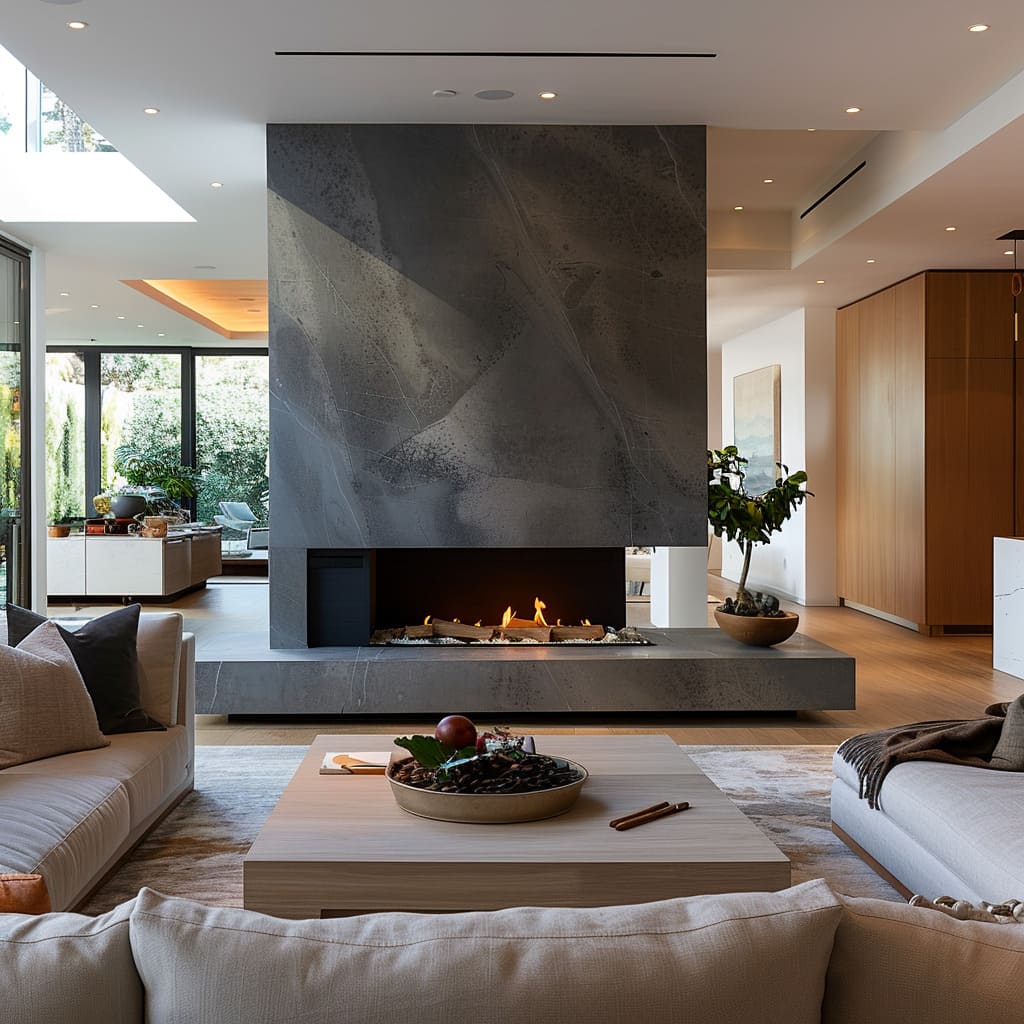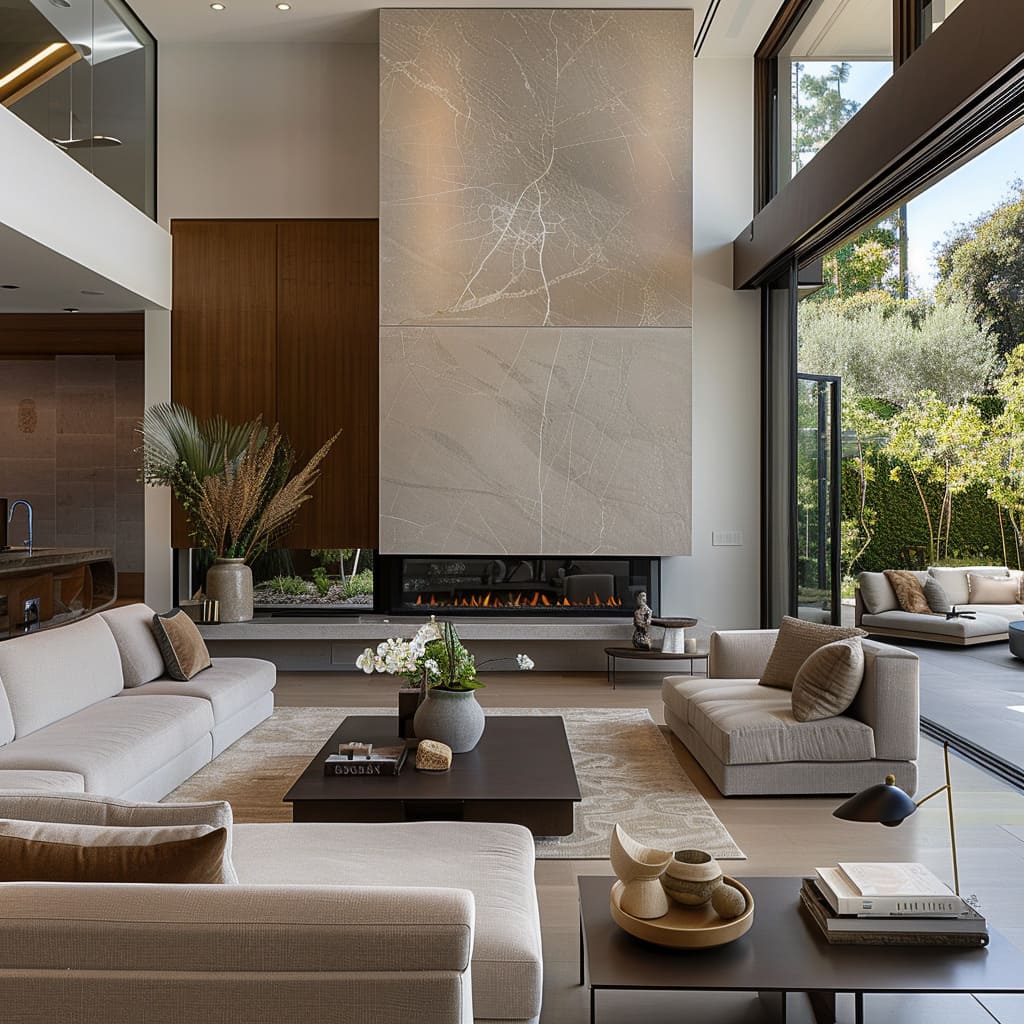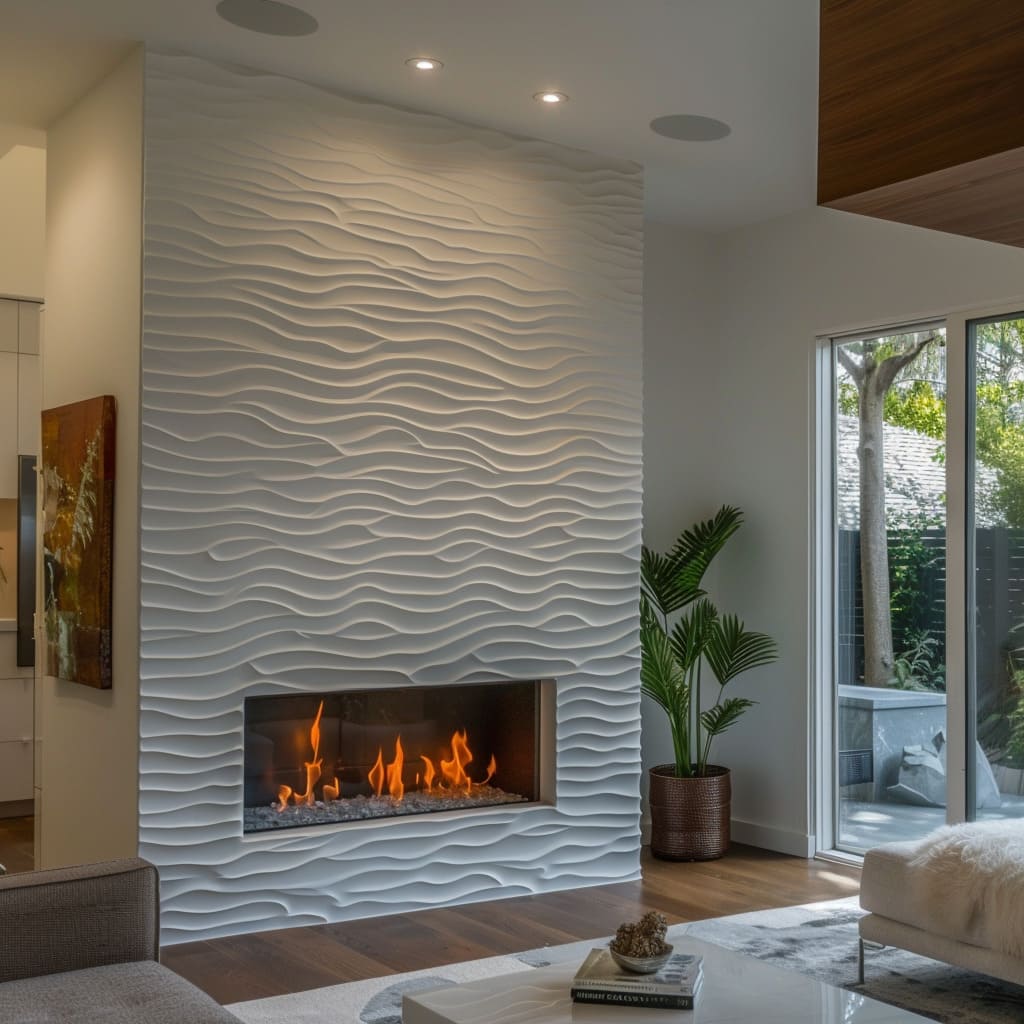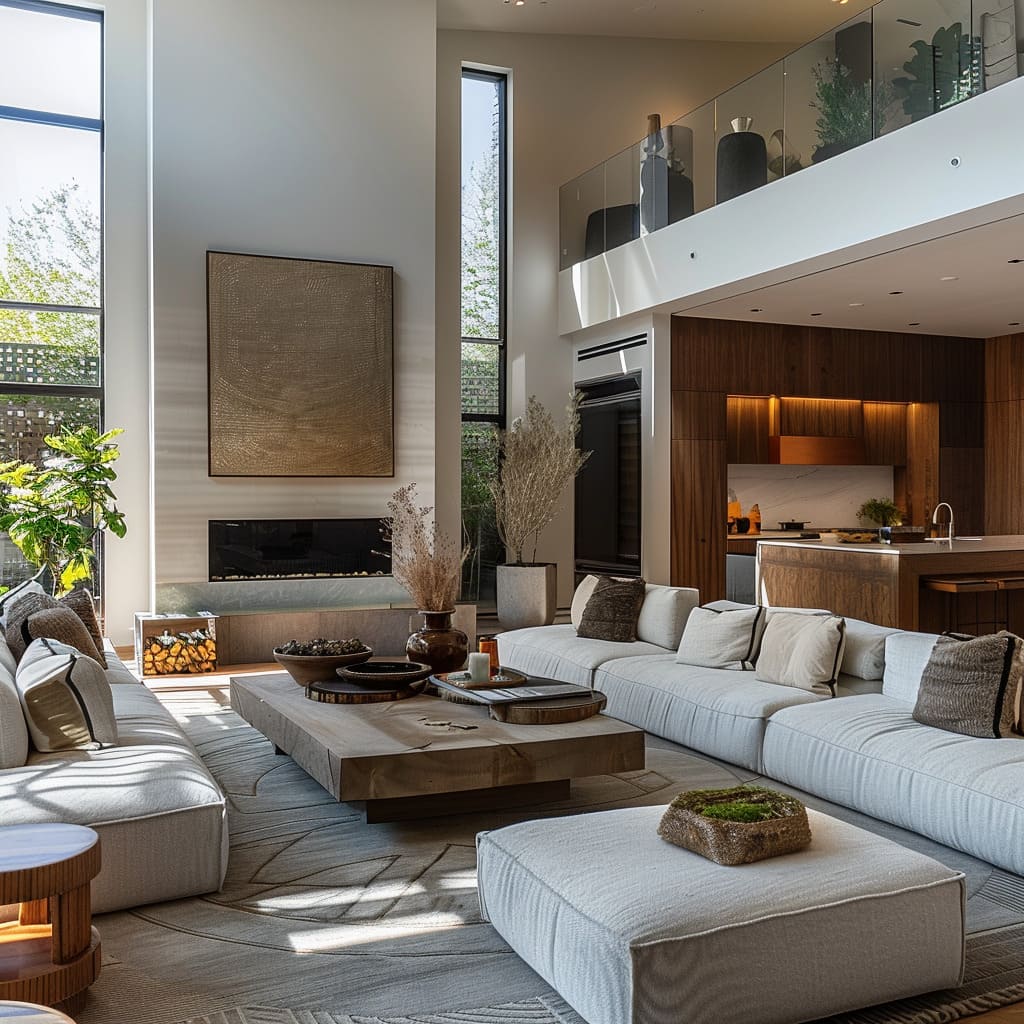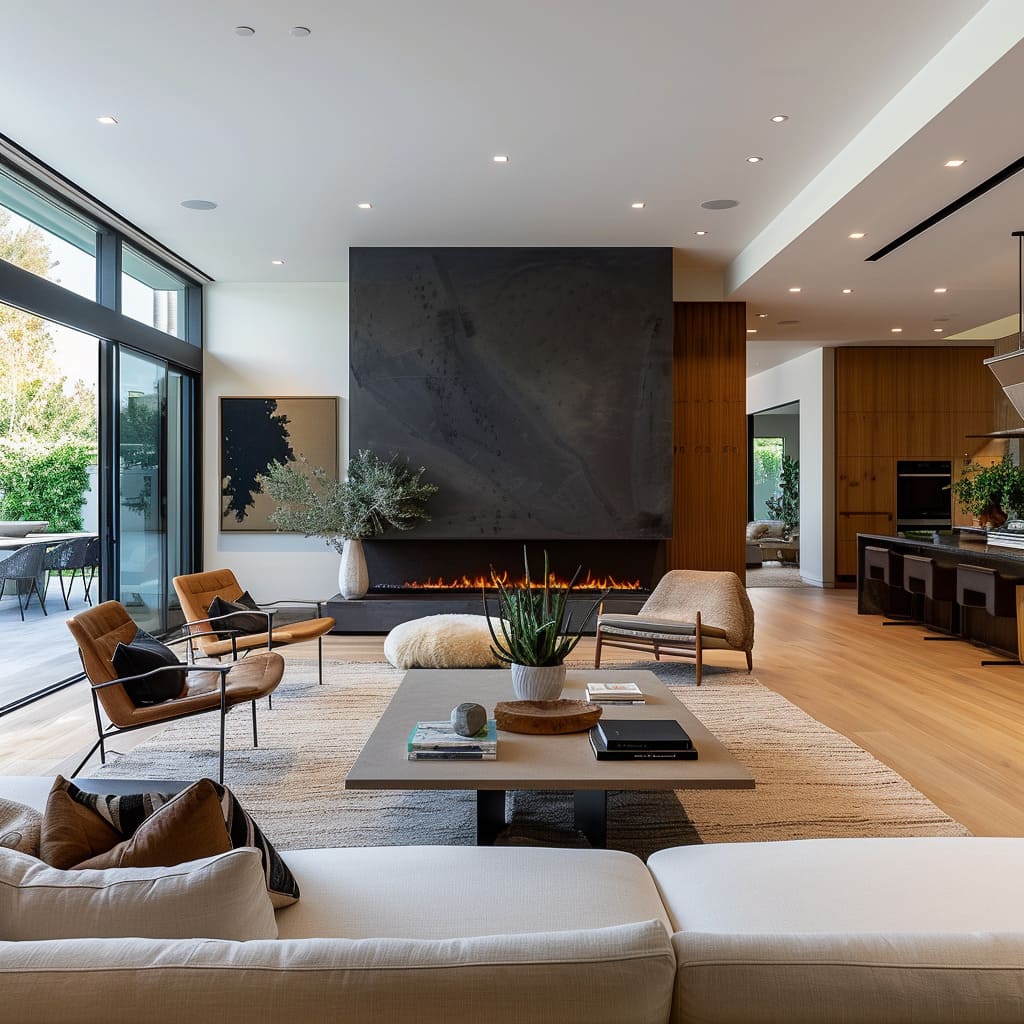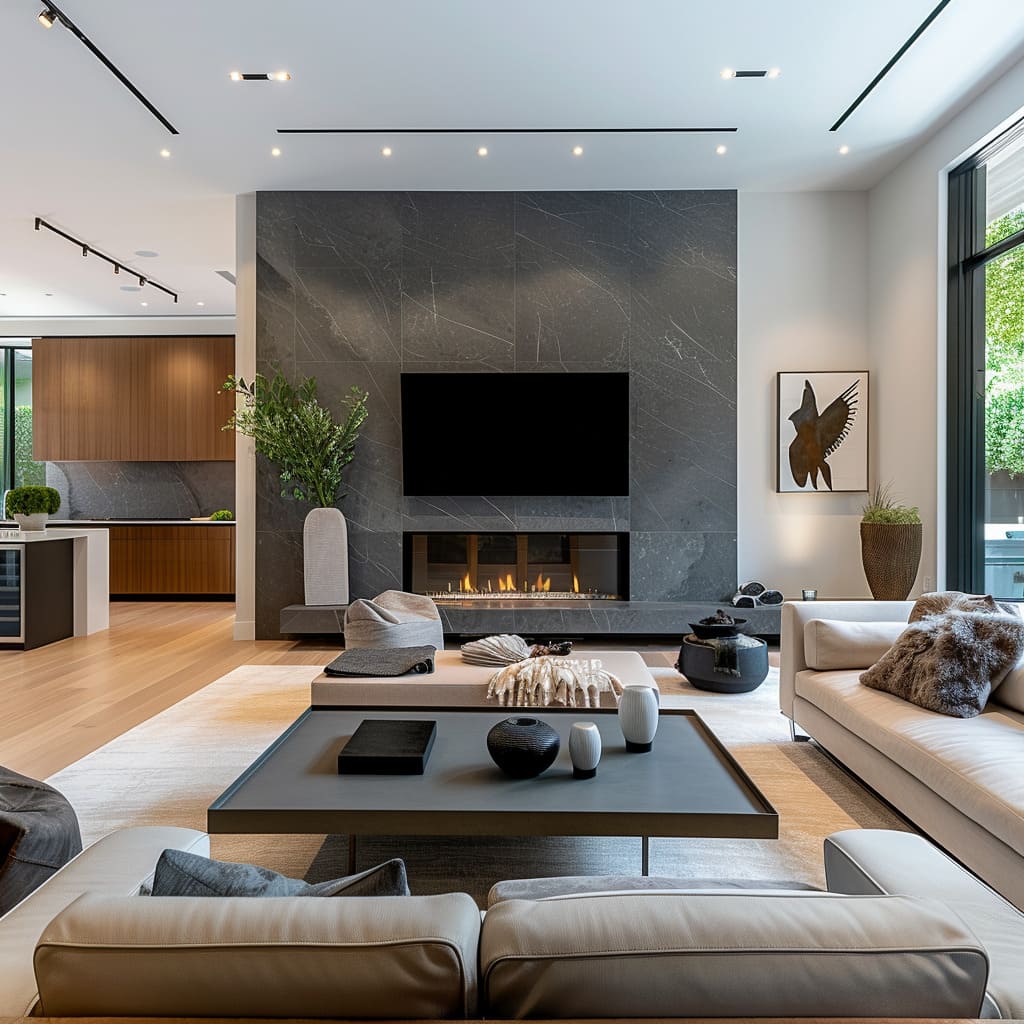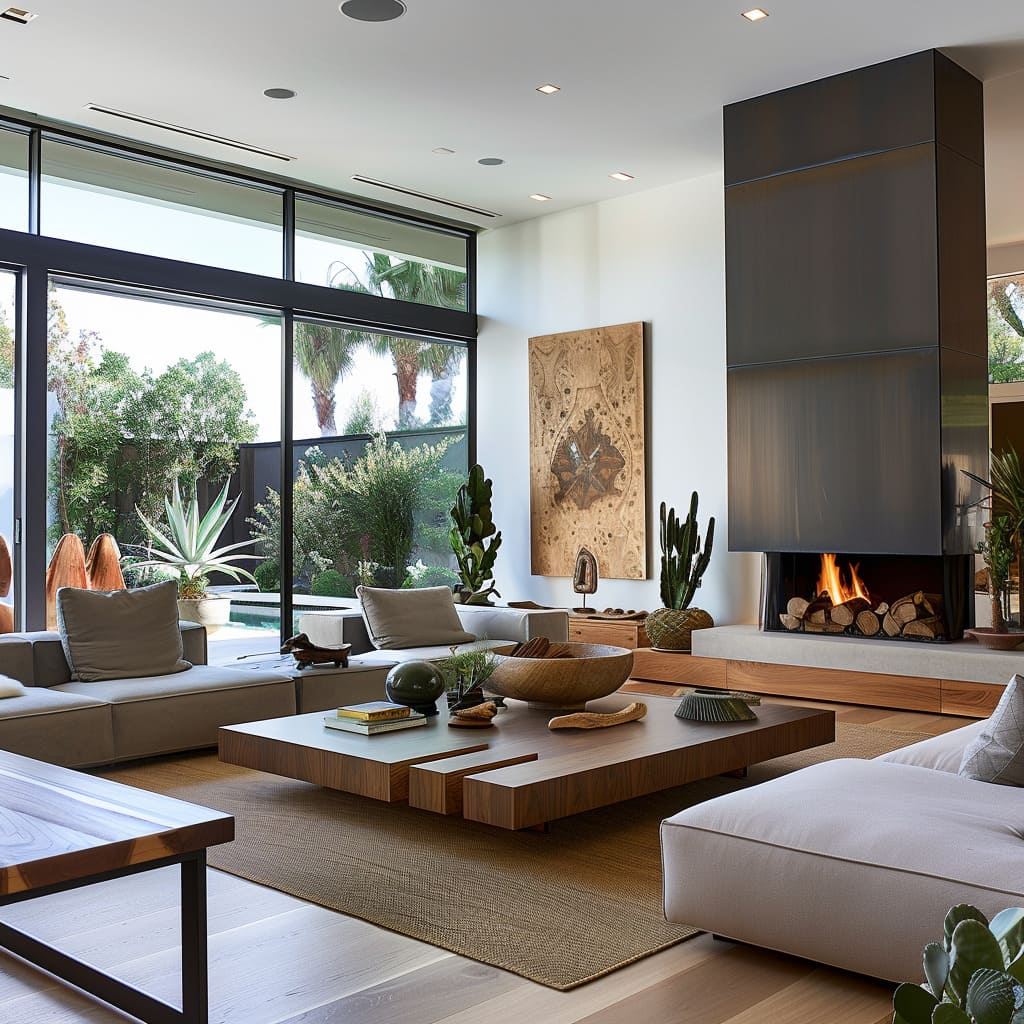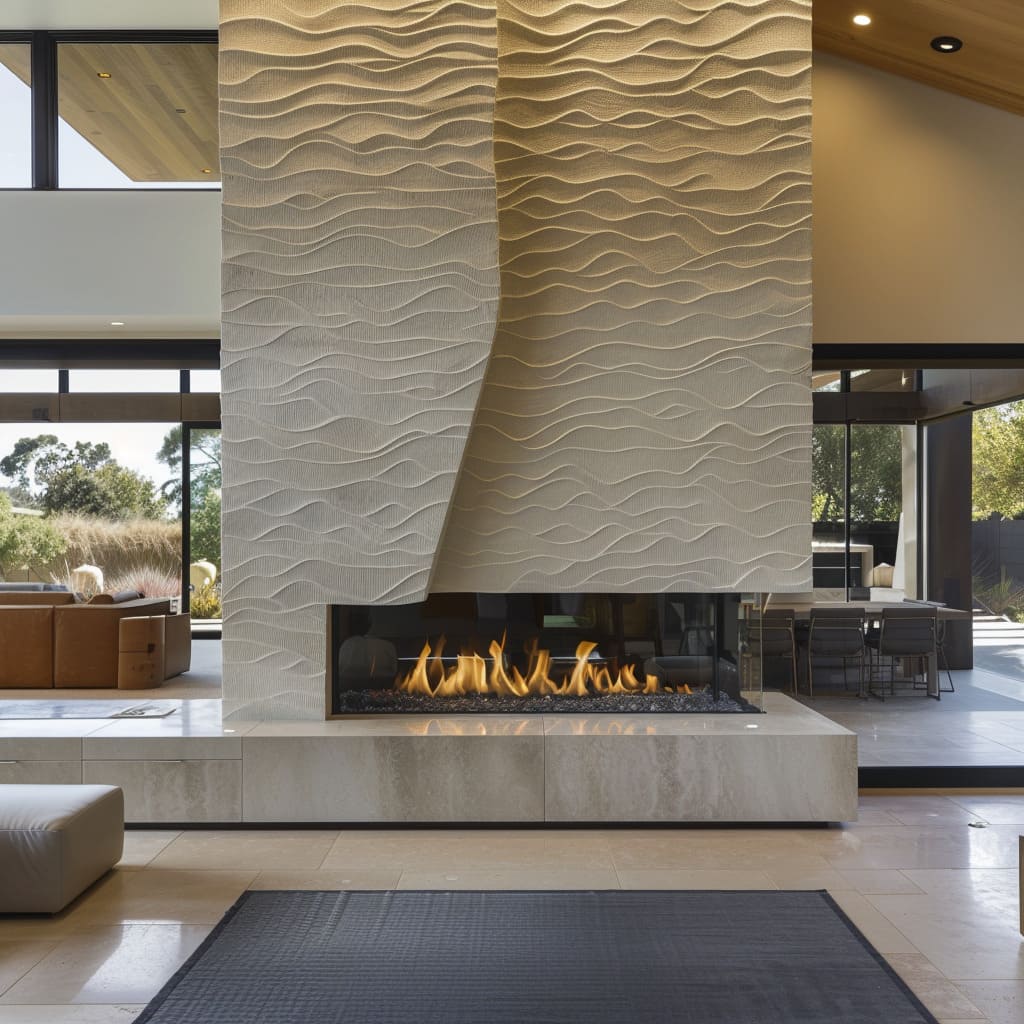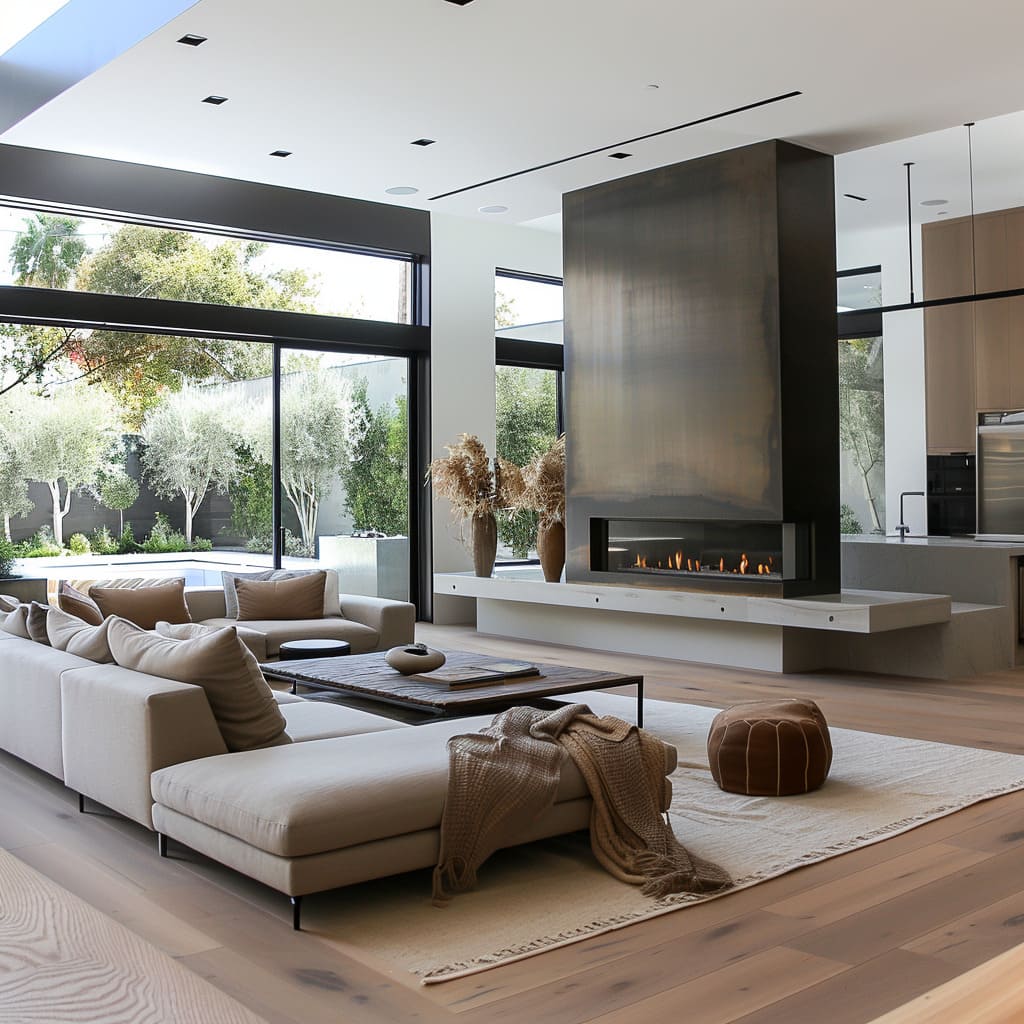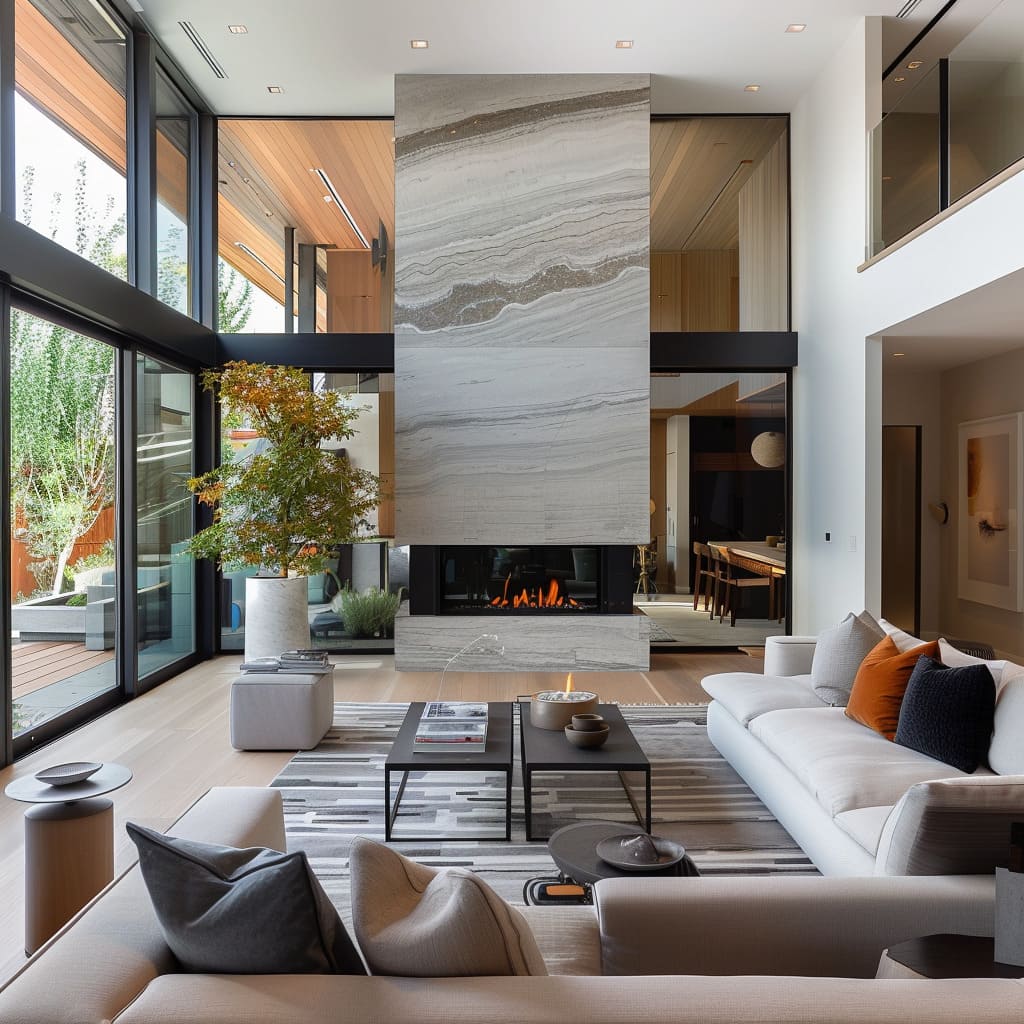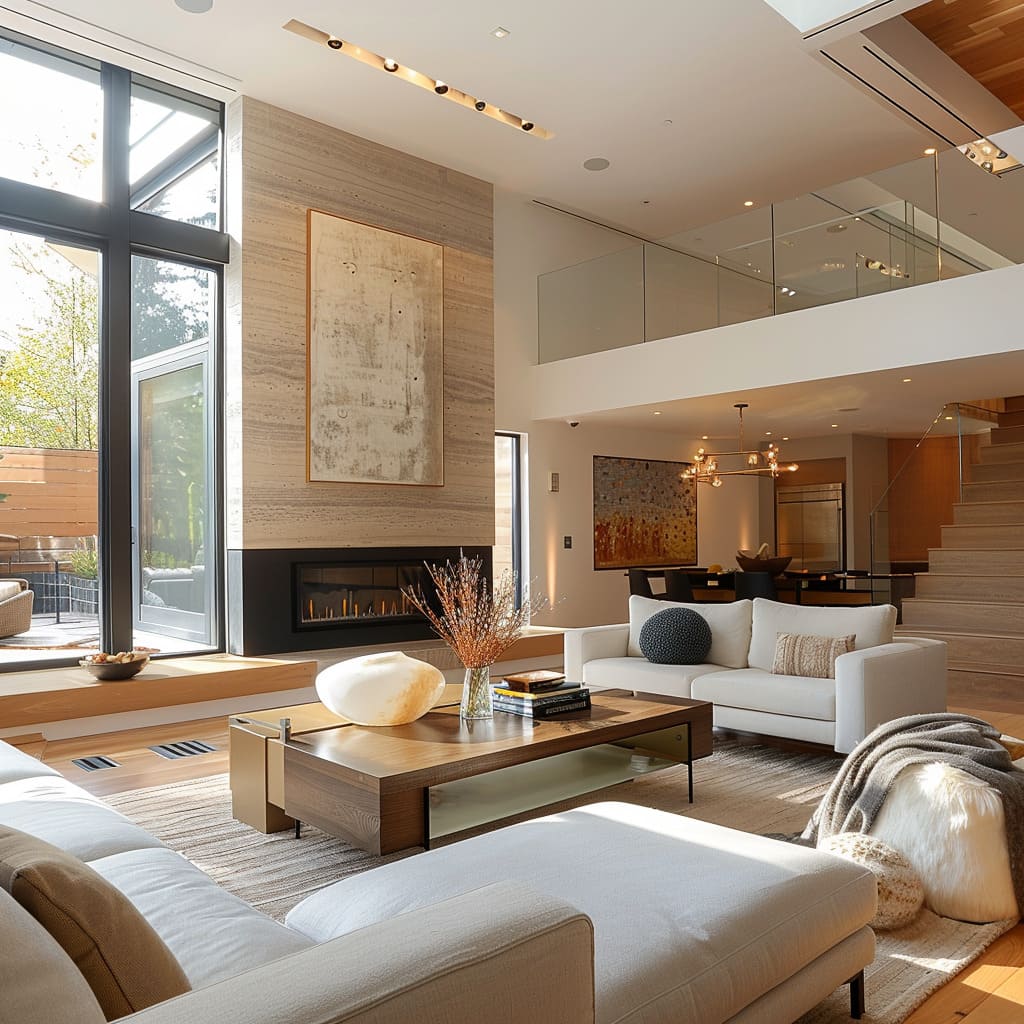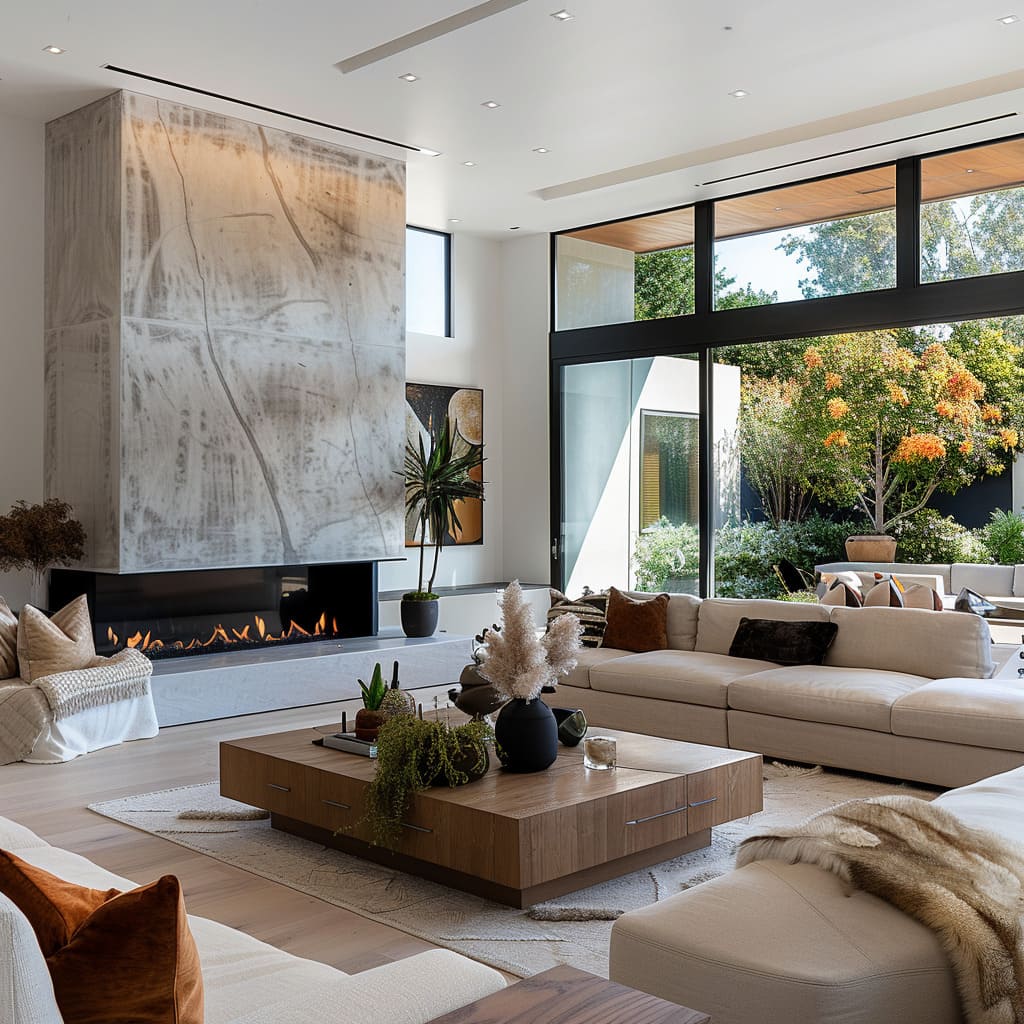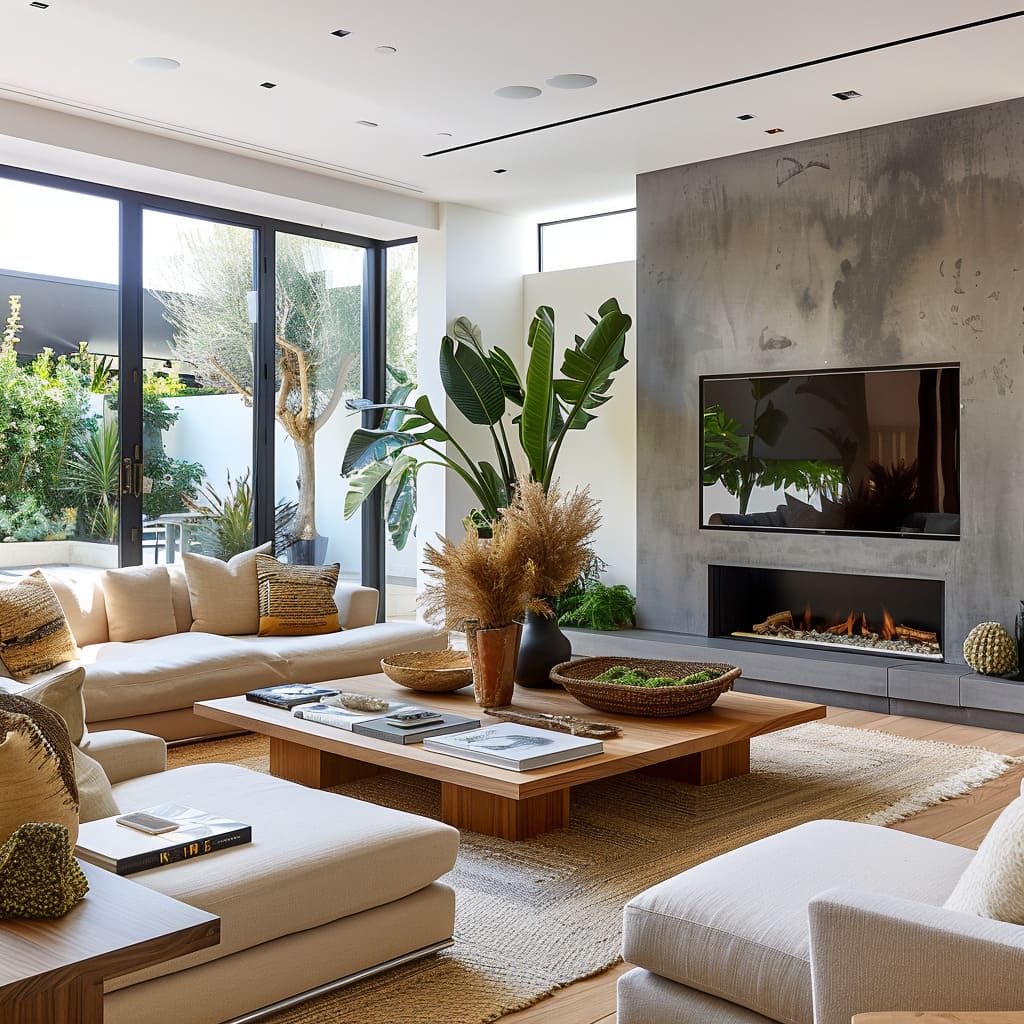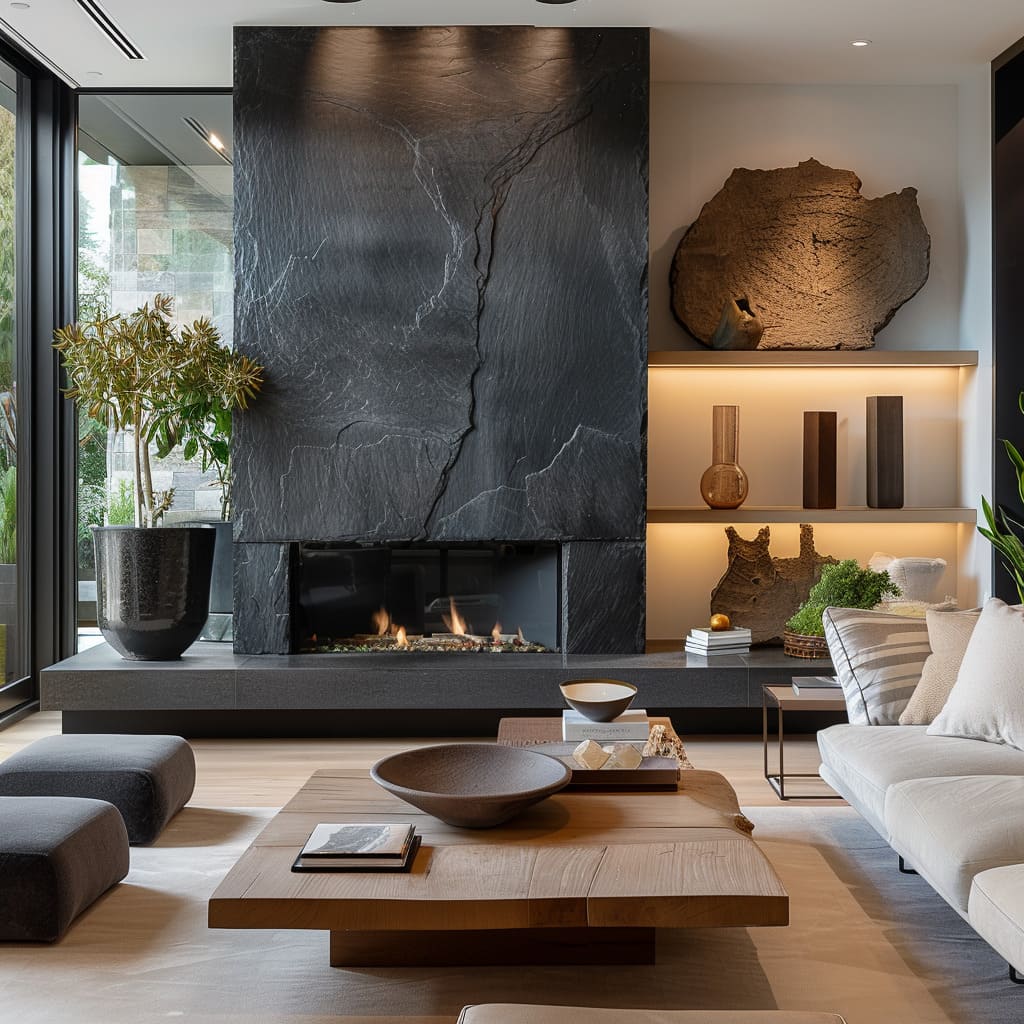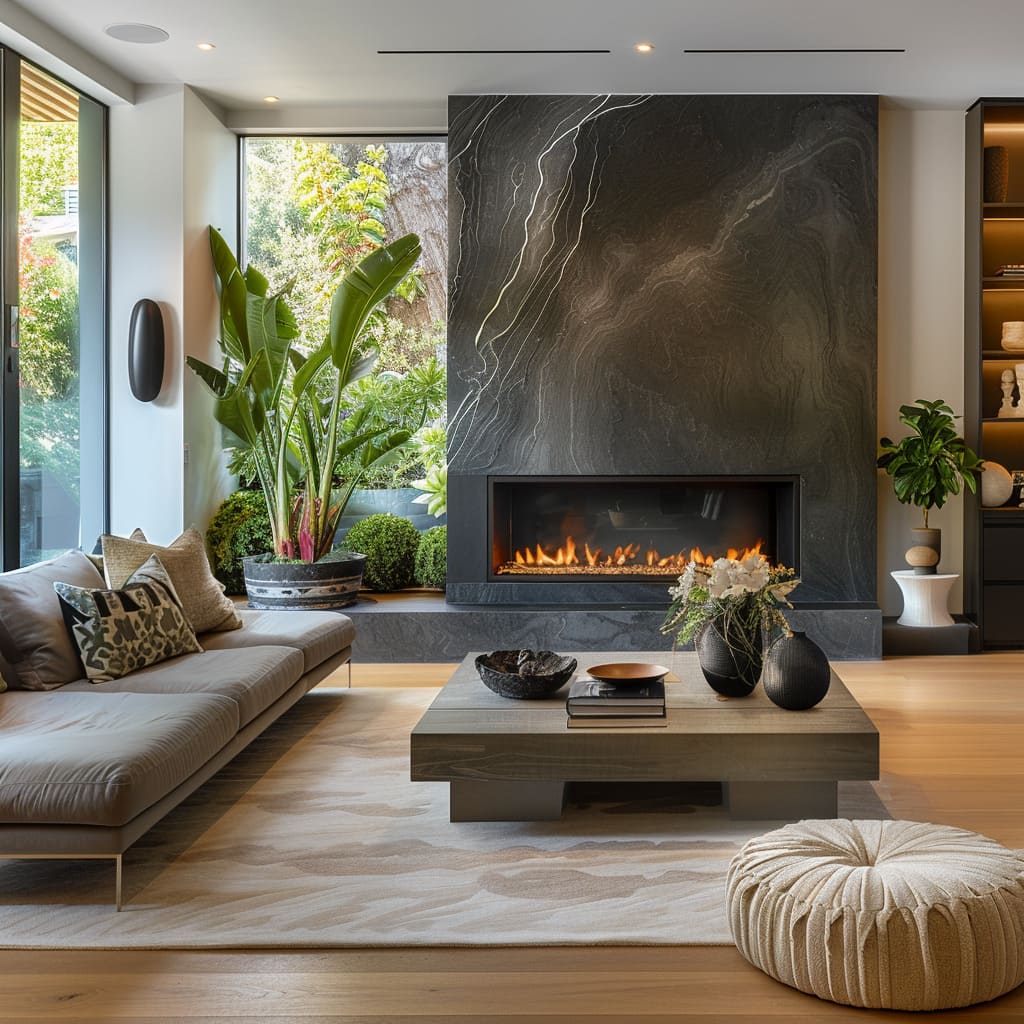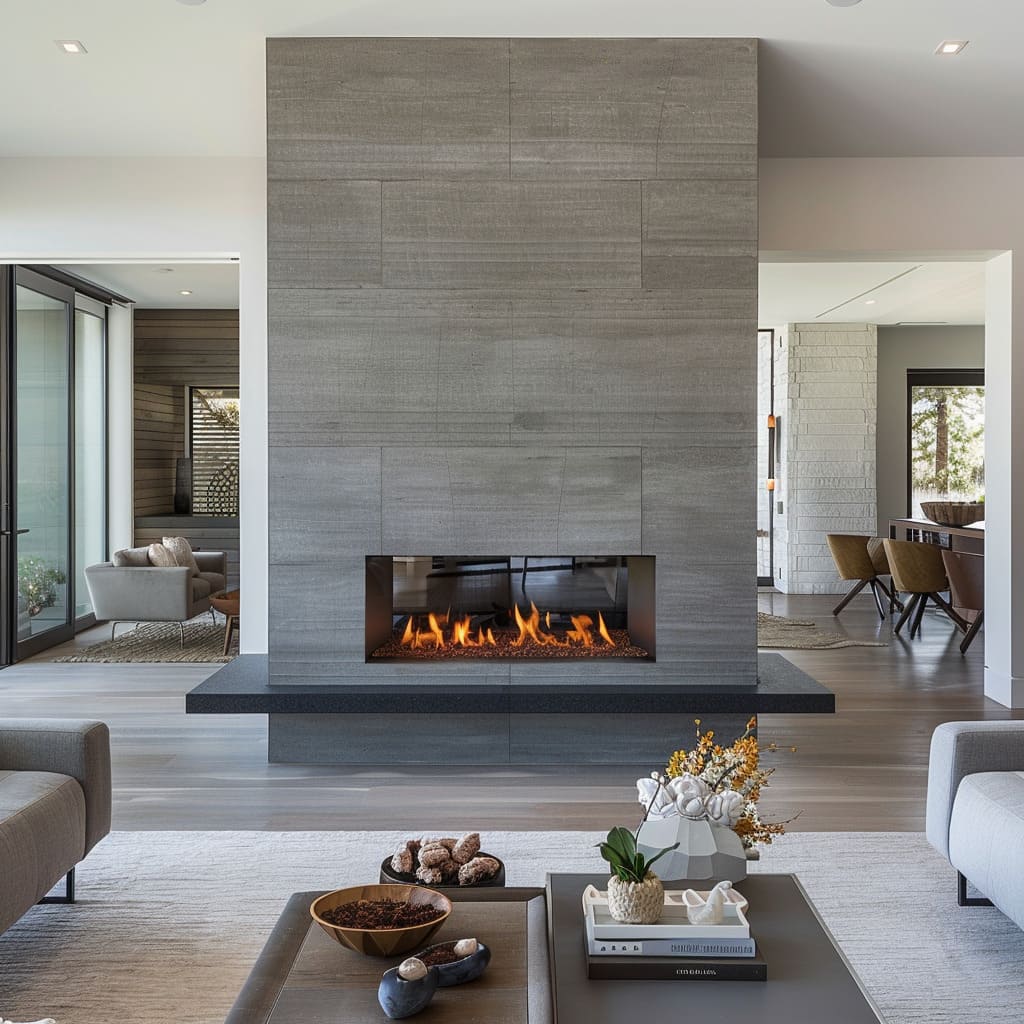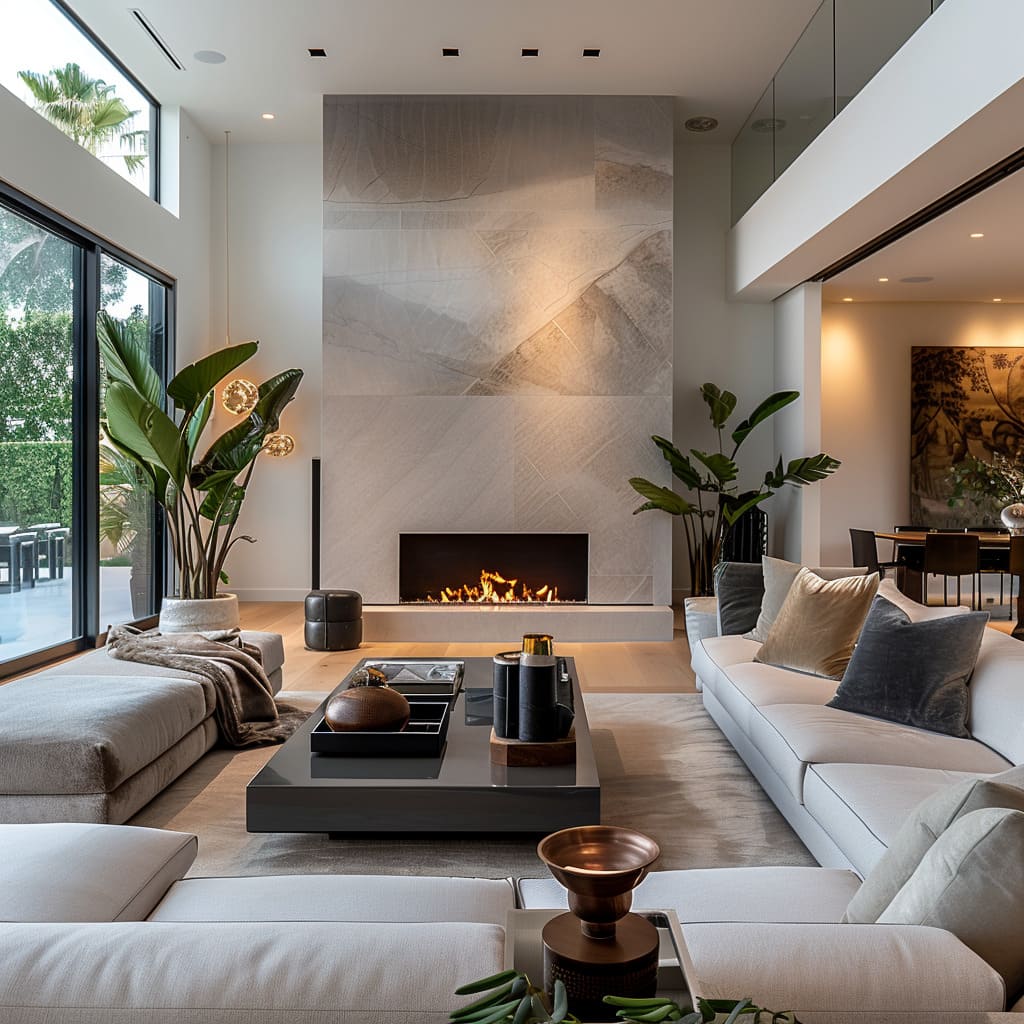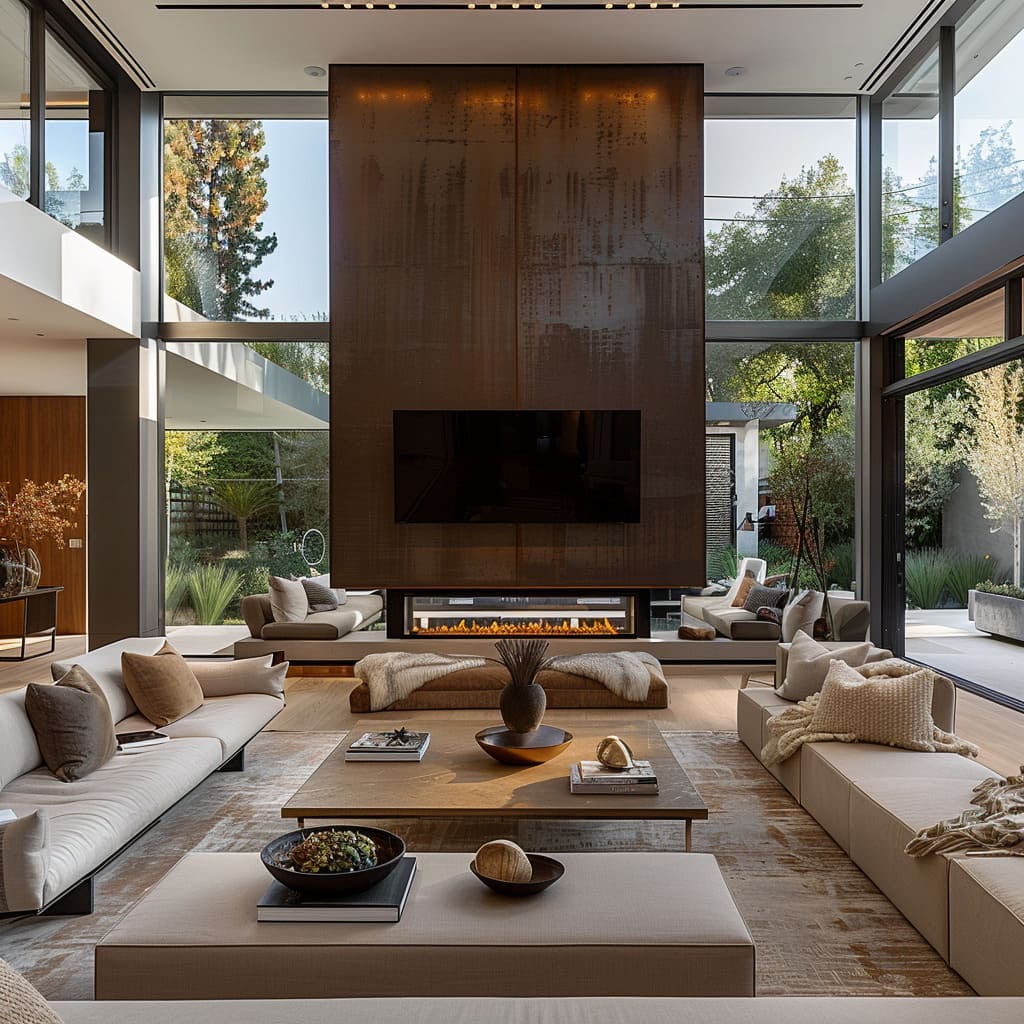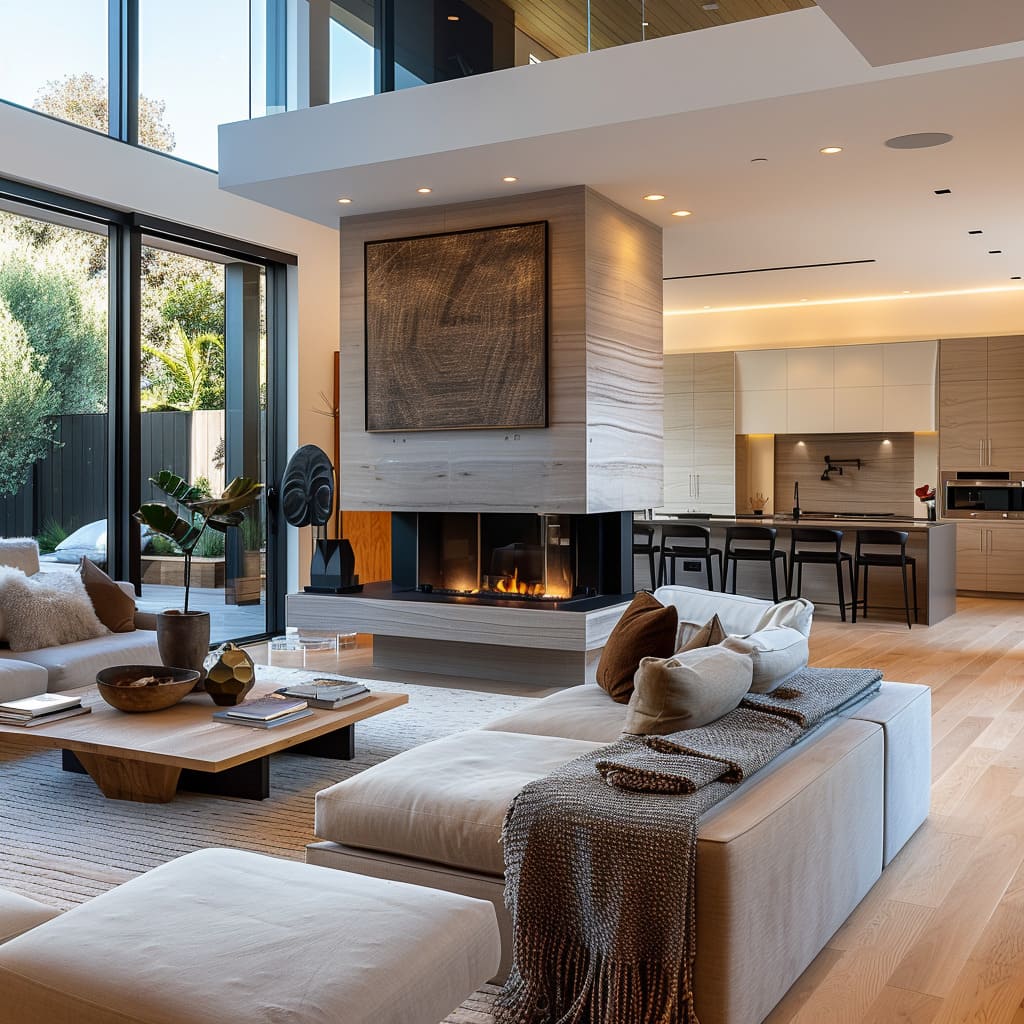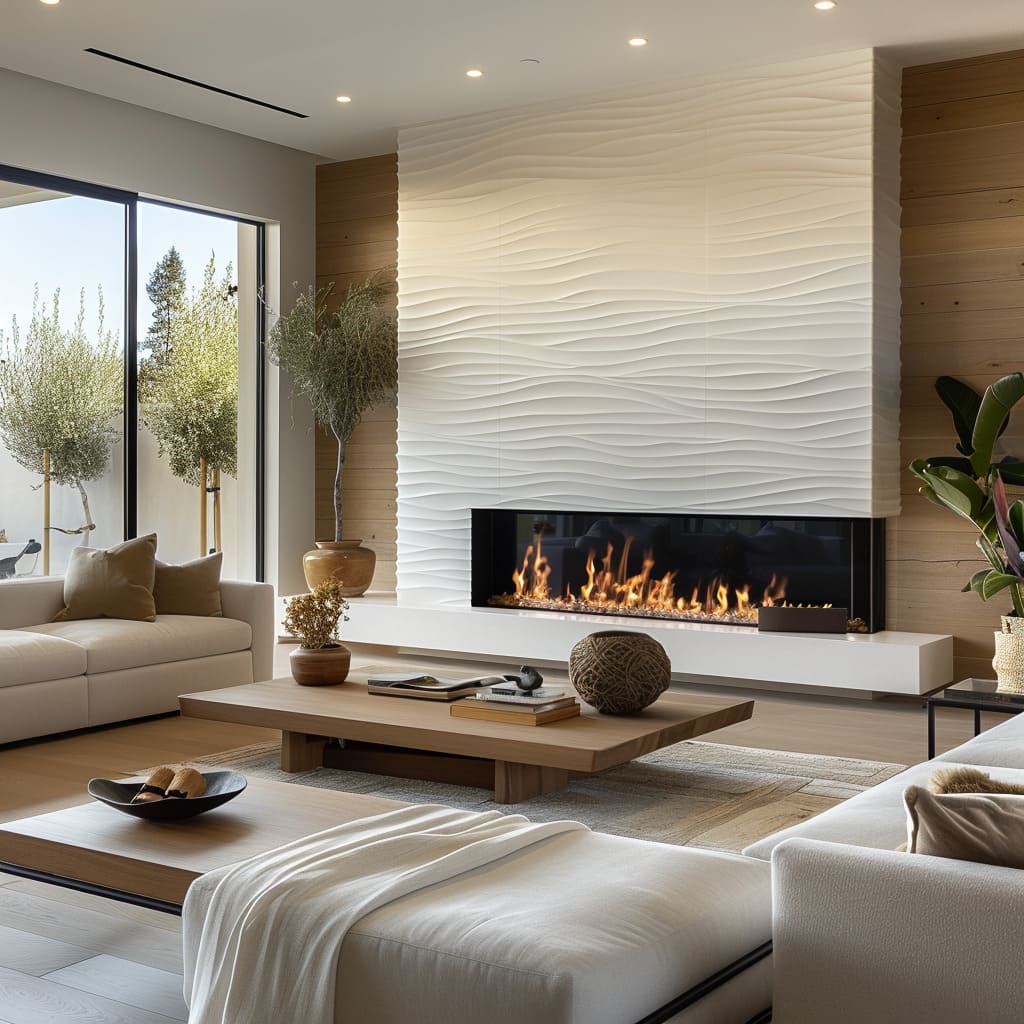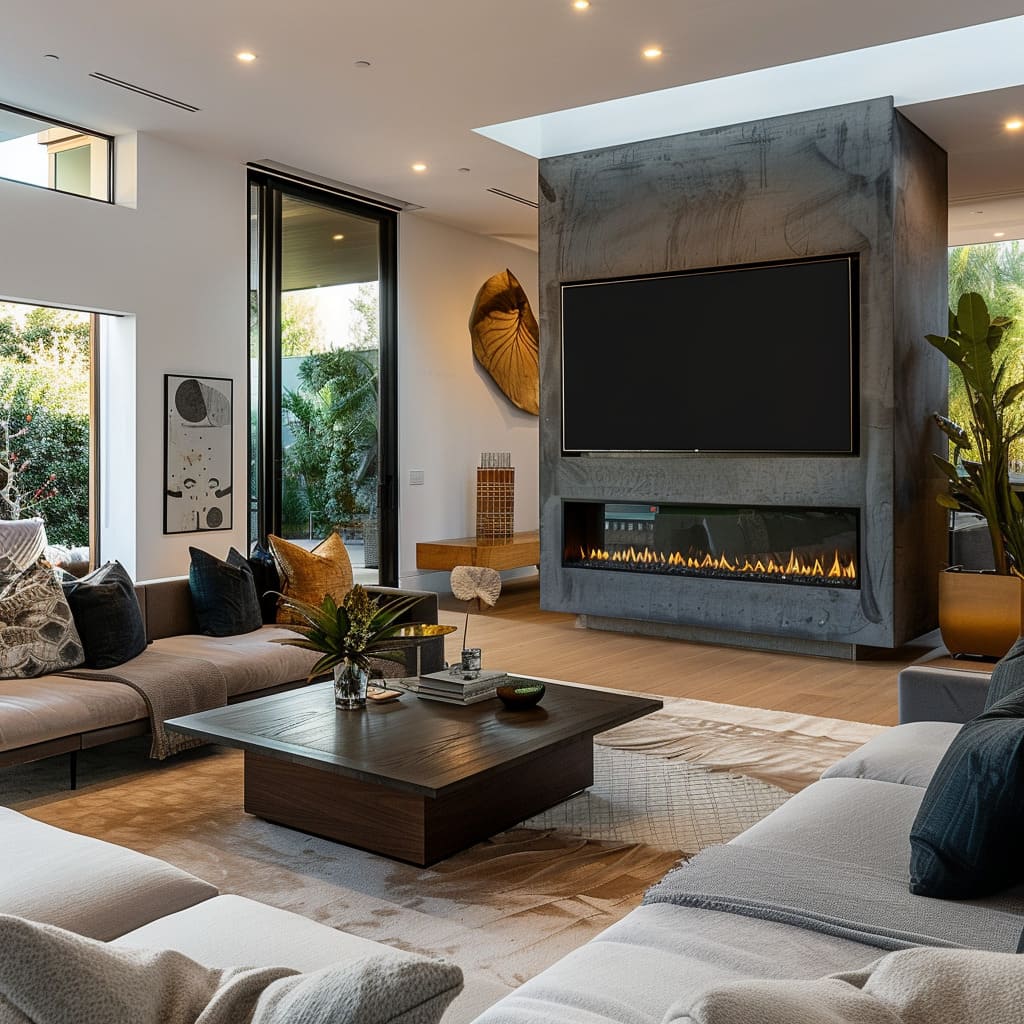In recent years, there has been a notable increase in the popularity of modern fireplace designs in living rooms across the US, Canada, and the UK. Homeowners and designers alike are embracing innovative ideas for mantels and fireplaces that blend functionality with style.
These contemporary fireplace ideas are transforming traditional living spaces into sophisticated and inviting areas. A fireplace serves as more than just a heating source; it becomes the heart of the home.
The importance of a fireplace as a focal point in modern interior design cannot be overstated. It anchors the room, providing a central element around which furniture and decor can be arranged.
With a variety of fireplace ideas in living room settings, from sleek electric models to classic stone surrounds, there are endless possibilities for creating a stunning visual impact.
Moreover, the rise of open-plan living spaces has led to creative ideas for fireplace walls that integrate seamlessly with other areas of the home. Whether it’s a minimalist, clean-lined design or a more elaborate setup with custom cabinetry and built-ins, the fireplace wall can enhance the overall aesthetic and functionality of the living space.
As we explore various modern fireplace ideas and practical tips in this article, you’ll discover how to make the most of this key feature in your home. From maintenance and safety considerations to cost breakdowns and decor suggestions, we cover everything you need to know to achieve a beautiful and efficient fireplace setup.
All About Fireplace Wall Design
Unique Design Elements
Modern fireplace wall designs have evolved to become a defining feature in contemporary living spaces, often incorporating modern fireplaces. One standout element in these designs is the emphasis on sleek, minimalist aesthetics that blend functionality with striking visual appeal.
The use of materials such as black marble, brushed metal, and light wood veneer plays a crucial role in creating a refined look. These materials not only offer durability but also introduce a range of textures and tones that contribute to the overall ambiance of the room.
Black marble, with its dramatic veining and polished finish, adds a touch of sophistication and luxury. This material’s natural patterns create an eye-catching focal point that draws the eye and anchors the room’s design, often featured in fireplace ideas in living rooms.
Brushed metal, on the other hand, provides an industrial edge with its smooth, matte surface. Its subtle sheen reflects light softly, adding depth without overpowering the space.
Light wood veneer brings warmth and a natural element, balancing the cooler tones of metal and marble.
A key trend in modern fireplace wall design is the integration of double-sided fireplaces. These fireplaces serve as functional room dividers, creating distinct zones within open-plan living areas.
The double-sided design allows the warmth and visual appeal of the fireplace to be enjoyed from multiple angles, enhancing the sense of continuity and flow between spaces. This approach not only maximizes the fireplace’s utility but also adds a dynamic architectural element to the room, showcasing some of the best modern fireplace ideas in living rooms.
Integration with Open-Plan Layouts
Open-plan living spaces benefit greatly from the strategic placement of modern fireplaces. These fireplaces act as central features around which the rest of the room can be organized, often inspiring modern fireplace wall ideas.
One effective placement strategy is to position the fireplace in a way that aligns with the natural pathways of the home, ensuring it remains a focal point without obstructing movement. For instance, placing a fireplace between the living and dining areas can create a seamless transition while still defining each space.
Another important consideration is the role of natural light. Large floor-to-ceiling windows are a common feature in contemporary homes, and the positioning of the fireplace should complement this architectural element.
By placing the fireplace near these windows, homeowners can take advantage of the interplay between natural and artificial light. The flickering flames of the fireplace can enhance the natural light during the day and provide a warm, inviting glow in the evening, aligning with many sitting room with fireplace ideas.
Outdoor connections are also a significant aspect of modern fireplace design.
Sliding glass doors that open onto patios or gardens can extend the living space, creating an indoor-outdoor flow. Positioning the fireplace to be visible from both inside and outside areas allows it to be a unifying element, enhancing the overall aesthetic and functionality of the home.
This setup encourages social interaction and provides a cohesive design that feels expansive and connected to nature.
In summary, modern fireplace wall designs are characterized by their clean lines, choice of luxurious and industrial materials, and their ability to act as multifunctional features within open-plan layouts. The integration of double-sided fireplaces and the thoughtful placement in relation to natural light and outdoor spaces ensure these fireplaces are not only functional heating elements but also pivotal design features that elevate the entire living space.
What Can You Afford with Your Budget?
Want to know what your budget can get you? Enter details for instant answers!
[budget_renovation_calculator]
Comprehensive Guide to Fireplace Wall Materials and Finishes
Popular Materials
When designing a modern fireplace wall, the choice of materials plays a crucial role in defining the overall aesthetic and functionality of the space. The selection of materials not only influences the visual appeal but also affects the durability and maintenance of the fireplace.
Here, we delve into some of the most popular materials used in modern fireplace wall designs, highlighting their characteristics, benefits, and potential drawbacks.
Black Marble
Black marble is synonymous with luxury and sophistication. This material is prized for its deep, rich colour and dramatic veining, which create a striking focal point in any room.
The natural patterns in black marble add depth and character, making each installation unique.
Pros:
- Aesthetic Appeal: Its elegant appearance enhances the visual impact of the fireplace.
- Durability: Marble is a hard, long-lasting material that can withstand high temperatures.
- Unique Patterns: No two slabs are identical, ensuring a one-of-a-kind design.
Cons:
- Cost: Black marble can be expensive, both in terms of material cost and installation.
- Maintenance: It requires regular sealing and cleaning to maintain its appearance and prevent staining.
Brushed Metal
Brushed metal brings an industrial edge to modern fireplace designs. The brushed finish reduces glare while adding a subtle texture that catches the light beautifully.
This material is versatile and can complement a wide range of interior styles.
Pros:
- Modern Aesthetic: Its sleek, contemporary look fits well with minimalist and industrial designs.
- Low Maintenance: It is easy to clean and doesn’t require much upkeep.
- Durability: Metal is resilient and can handle high temperatures without damage.
Cons:
- Cold Appearance: Metal can sometimes feel too stark or cold, needing warm accents to balance the look.
- Potential for Scratches: While brushed metal hides fingerprints well, it can show scratches and dents over time.
Rusted Finish Metal
Rusted finish metal, also known as corten steel, offers a weathered, rustic look that contrasts beautifully with modern interiors. The rusted surface develops a protective layer that prevents further corrosion, adding a rugged charm to the design.
Pros:
- Unique Appearance: The patina adds character and a natural, aged look.
- Low Maintenance: Once the patina has developed, it requires minimal upkeep.
- Durability: The protective layer formed by the rust prevents further corrosion.
Cons:
- Limited Colour Range: The rusted appearance may not suit all interior colour schemes.
- Initial Setup: The patina process can take time to develop fully, requiring patience.
Light Wood Veneer
Light wood veneer introduces warmth and a natural element to fireplace designs. This material is favoured for its ability to soften the look of modern interiors, creating a more inviting atmosphere.
Pros:
- Warmth: Wood adds a natural, welcoming feel to any space.
- Versatility: It can be stained or finished in various ways to match different interior styles.
- Cost-Effective: Veneer can be a more affordable option compared to solid wood or other materials.
Cons:
- Susceptibility to Damage: Wood can be prone to scratches, dents, and warping if not properly maintained.
- Maintenance: It requires regular care, such as polishing and occasional refinishing, to keep it looking its best.
Finishes and Textures
The finish and texture of the material used for a fireplace wall significantly influence its visual and tactile impact. Different finishes can alter the way light interacts with the surface, changing the mood and feel of the space.
Here, we explore some common finish options and their effects.
Polished Finish
A polished finish is characterized by its smooth, glossy surface that reflects light, creating a bright and clean appearance.
This finish is often used with materials like marble to enhance their natural patterns and colours.
Visual Impact:
- Reflective: Adds brightness and a sense of space to the room.
- Luxurious: The high-gloss finish exudes a sense of opulence.
Tactile Impact:
- Smooth: Offers a sleek, clean feel to the touch.
Brushed Finish
A brushed finish features a matte surface with subtle texture created by brushing the material in one direction. This finish is commonly used with metals and wood to add a sophisticated, understated texture.
Visual Impact:
- Subtle Sheen: Diffuses light softly, reducing glare.
- Modern: Contributes to a contemporary, refined look.
Tactile Impact:
- Textured: Adds a slight roughness that can be felt upon touch, providing a tactile contrast to smoother surfaces.
Patina Finish
A patina finish involves the natural or chemically induced aging of a material, resulting in a weathered, antique appearance. This finish is often used with metals like corten steel to create a rustic, earthy look.
Visual Impact:
- Aged: Gives the material a sense of history and depth.
- Natural: The organic development of patina adds a unique character.
Tactile Impact:
- Varied: The surface can have a mix of smooth and rough areas, offering a complex tactile experience.
In conclusion, the choice of materials and finishes for a modern fireplace wall is a crucial aspect of design that significantly affects both the aesthetics and functionality of the space. By carefully selecting the right combination of materials and finishes, homeowners can create a fireplace that not only serves as a heating source but also as a central element of their interior decor.
Room Layout Options in Open Living Rooms
Open-Plan Living Room Layouts
Integrating a fireplace into an open-plan living room requires thoughtful consideration to maximize both aesthetic appeal and functional use. In large, open spaces, fireplaces can serve as stunning focal points that bring warmth and cohesion to the room.
Here are some strategies to effectively incorporate fireplaces into these expansive layouts:
Strategies for Integrating Fireplaces in Large, Open Spaces
- Central Placement: Placing the fireplace centrally within the living area can create a natural gathering point. This positioning allows the fireplace to be easily viewed and enjoyed from multiple parts of the room, enhancing its role as a unifying element.
A centrally located fireplace can also help balance the room’s visual weight, making the space feel more organized and inviting.
By aligning the fireplace with the primary seating arrangement, you create a harmonious and comfortable environment.
The feature wall can be highlighted with unique materials like black marble or brushed metal to further emphasize the fireplace.
Examples of Seating Arrangements Around Fireplaces
- Symmetrical Arrangement: Arrange sofas and chairs symmetrically around the fireplace to create a balanced and formal look. This setup works well in large spaces where symmetry can bring a sense of order and elegance.
Adding a central coffee table and matching side tables can complete the arrangement, making it perfect for both entertaining and everyday relaxation.
It allows for a cozy corner while keeping the space open for movement and interaction.
It’s particularly effective in open-plan designs where the living room needs to maintain a flexible and adaptive feel.
Zoning with Fireplaces
In open-plan living rooms, fireplaces can also function as effective tools for zoning—creating distinct areas within a large space without the need for walls. Here’s how fireplaces can help define different zones while maintaining a cohesive flow:
Using Fireplaces as Functional Dividers
- Living and Dining Areas: A double-sided fireplace can serve as a stylish divider between the living and dining areas.
This setup allows the warmth and ambiance of the fireplace to be enjoyed from both sides, creating a seamless transition between spaces. It visually separates the two areas while maintaining an open and connected feel.
Positioning the fireplace between these areas helps define the boundaries while keeping the overall design cohesive. This approach also ensures that the fireplace can be a shared feature, enhancing both the kitchen and living spaces.
For instance, a fireplace placed between a reading nook and the main living area can provide a cozy retreat without isolating it from the rest of the room.
Maintaining Visual Continuity and Flow
- Consistent Materials and Colours: Using the same or complementary materials and colours for the fireplace and surrounding decor helps maintain visual continuity. For example, a fireplace wall in black marble can be complemented by matching countertops in the kitchen or accent walls in the living area.
This consistency ties the different zones together, creating a harmonious flow.
Strategically placing the fireplace to one side or incorporating a see-through design can help achieve this goal.
Accent pieces, such as vases, cushions, and rugs, can further enhance this sense of unity.
In summary, modern fireplaces are versatile design elements that can enhance open-plan living rooms in various ways. Whether serving as focal points, functional dividers, or elements of visual continuity, fireplaces play a key role in defining and elevating the overall design of these spaces.
By carefully considering placement, seating arrangements, and materials, homeowners can create stylish and cohesive living environments that are both beautiful and functional.
Connection with Other Rooms
Seamless Transitions
Modern home design often emphasizes open, airy spaces where the living room, kitchen, and dining areas flow together without interruption. Achieving this seamless connection requires careful planning and thoughtful design choices, particularly when incorporating a fireplace into the layout.
Creating Fluid Connections Between Living Rooms, Kitchens, and Dining Areas
To ensure smooth transitions between these key areas, it’s essential to maintain a consistent design language throughout the space. This can be achieved by using similar materials, colours, and finishes across all rooms.
For instance, if the fireplace wall features a specific type of stone or wood, echoing this material in the kitchen countertops or dining room table can create a unified look.
The layout of furniture also plays a crucial role in fostering these connections. Arranging seating to face the fireplace from the living room, while positioning the dining table and kitchen island in a way that maintains open sightlines, helps to draw the eye naturally from one area to the next.
This arrangement not only enhances the visual appeal but also ensures practical functionality, making it easy to move between spaces during daily activities or social gatherings.
Use of Consistent Materials and Colours for a Cohesive Look
Selecting a cohesive palette of materials and colours is key to creating a unified and harmonious home environment. When choosing materials for the fireplace, consider how these will blend with other elements in the kitchen and dining areas.
For example, a black marble fireplace can be complemented by matching marble countertops in the kitchen or black accent pieces in the dining room. This continuity in materials helps to tie the spaces together, creating a cohesive and polished look.
Consistent colour schemes also contribute to a seamless transition between rooms. Neutral tones, such as whites, greys, and beiges, can be used as a base, with pops of colour introduced through accessories and decor items.
This approach allows the fireplace to stand out as a central feature while ensuring that the overall design feels balanced and integrated.
Visual Integration
The fireplace can serve as a powerful visual anchor that unites different areas of an open-plan home. By thoughtfully integrating the fireplace into the broader design scheme, it becomes a central element that enhances the cohesion of the space.
Techniques for Making the Fireplace a Central Element That Ties Multiple Spaces Together
- Double-Sided Fireplaces: A double-sided fireplace can be a practical and stylish solution for connecting living and dining areas. This design allows the warmth and ambiance of the fireplace to be enjoyed from both sides, creating a sense of continuity and connection between the two spaces.
By acting as a see-through partition, a double-sided fireplace maintains an open feel while subtly delineating different functional zones.
Similarly, matching hardware finishes, such as brushed metal or matte black, across various fixtures and fittings can enhance the sense of unity.
Using textiles, such as cushions, throws, and rugs in complementary colours and patterns, can also enhance the visual flow and connection.
Pendant lights above the dining table, under-cabinet lighting in the kitchen, and recessed lights in the living room can all be coordinated to create a well-lit, cohesive environment.
In summary, achieving seamless transitions and visual integration in an open-plan home requires careful selection of materials, colours, and design elements. By focusing on consistency and harmony, the fireplace can serve as a central, unifying feature that enhances the overall aesthetic and functionality of the living space.
Furniture in Open Living Rooms with Fireplaces
Furniture Arrangement
Creating an inviting and functional space in living room designs with fireplaces involves thoughtful furniture arrangement. The goal is to complement the fireplace while ensuring comfort and practicality.
Here are some optimal placements and examples:
- Sectional Sofas: Sectional sofas are ideal for large, open-plan living rooms. Placing a sectional sofa facing the fireplace can create a cozy, central seating area.
This arrangement allows everyone to enjoy the warmth and visual appeal of the fireplace. In larger rooms, the sectional can also help define the living area without obstructing the flow between spaces.
For a fireplace in living room design, choose a coffee table that complements the materials and finishes of the fireplace. For instance, a wooden coffee table can add warmth and natural texture, while a metal or glass table can enhance a modern aesthetic.
Place these pieces to create conversation zones or reading nooks near the fireplace. This not only provides extra seating but also makes the space more flexible and inviting.
Complementary Furniture Styles
Matching modern furniture styles with the fireplace design can create a harmonious and visually appealing living room. Here are some living room furniture ideas with fireplace to consider:
- Modern Minimalist: For a sleek and contemporary look, choose furniture with clean lines and minimalist designs.
A low-profile sofa in a neutral colour, paired with a streamlined coffee table, can enhance the modern feel of the fireplace. Adding a few well-chosen decor items, like a geometric vase or abstract artwork, can complete the look without overwhelming the space.
Leather sofas, metal-framed chairs, and reclaimed wood tables can create a cohesive and stylish living room. This style blends raw materials with refined design, making the fireplace a standout feature.
Wooden tables, woven poufs, and linen cushions can add warmth and texture to the living room. These elements not only complement the fireplace but also create a cozy and inviting atmosphere.
Integration of Natural Elements
Integrating natural elements into living room ideas with fire place enhances the overall ambiance and connects the indoor space with the outdoors. Here are some decor ideas for living room with fireplace that incorporate natural materials:
- Wooden Tables: Wooden coffee and side tables add a touch of nature to the living room.
Choose tables with a raw or distressed finish for a more rustic look, or opt for polished wood for a sophisticated feel. These tables can complement the fireplace’s design and add warmth to the space.
Placing a large, woven rug in front of the fireplace creates a cozy area for lounging. Poufs can provide additional seating or serve as footrests, adding both style and functionality.
Choose low-maintenance indoor plants that thrive in the lighting conditions of the room. Placing a few potted plants near the fireplace or on side tables can create a fresh and vibrant atmosphere.
In conclusion, furniture arrangement and style play a crucial role in enhancing living room designs with fireplaces. By carefully selecting and positioning furniture pieces, incorporating complementary styles, and integrating natural elements, you can create a living room that is both beautiful and functional.
These living room ideas with fire place ensure that the fireplace remains a central and harmonious feature of the home.
Room Decor to Accomplish Living Room Design with Fireplace
Decor Items and Accents
When it comes to sitting room ideas with fireplace, selecting the right decor items and accents can significantly enhance the visual appeal of the space. The goal is to complement the fireplace without overshadowing it, ensuring that it remains the focal point while adding depth and character to the room.
- Vases: Vases are versatile decor items that can add colour, texture, and height to your living room fireplace decor ideas. Opt for vases in varying sizes and shapes to create an interesting arrangement.
Ceramic or glass vases in neutral or muted tones work well with modern fireplace designs, while bold colours can make a statement in a more eclectic room.
Place tall plants in floor pots beside the fireplace or arrange smaller plants on the mantel for a balanced look. Plants not only enhance the aesthetics but also improve the indoor air quality.
Choose bowls made from natural materials like wood or stone to add warmth and texture. These bowls can be filled with seasonal items such as pinecones in winter or fresh flowers in spring, allowing you to update your decor throughout the year.
Consider hanging a large statement piece above the fireplace to draw the eye upwards and create a sense of height. Alternatively, a collection of smaller framed artworks can add a gallery-like feel.
Ensure that the artwork complements the colours and style of the fireplace to maintain a cohesive look.
Flameless candles are a safe alternative that still offer the same visual effect.
Balancing Minimalism and Personality
Achieving a clean, modern look while adding personal touches is key to successful fire place decoration ideas. Here’s how to strike the perfect balance:
- Keep It Simple: Minimalism is all about simplicity and functionality.
Avoid overcrowding the fireplace area with too many decor items. Choose a few key pieces that complement each other and the overall design of the room.
This approach helps maintain a tidy and uncluttered appearance.
These items make the space feel more lived-in and unique.
This mix helps create a dynamic yet harmonious look.
For example, use light, airy fabrics and bright colours in the summer, and switch to cozy, warm textures and hues in the winter.
This technique helps create a sense of depth and dimension, making the fireplace area more visually appealing.
Asymmetry, on the other hand, adds a dynamic and casual vibe, ideal for a relaxed and inviting space.
Types of Modern Fireplaces
Electric fireplaces have become increasingly popular in modern home design due to their versatility and ease of installation. Here’s an in-depth look at the benefits, installation, and maintenance of electric fireplaces, as well as their design flexibility and energy efficiency.
Benefits of Electric Fireplaces
- Ease of Installation: Electric fireplaces are relatively simple to install compared to traditional wood-burning or gas fireplaces. Most models can be plugged into a standard electrical outlet, making them an excellent option for apartments or homes without an existing chimney or gas line.
- Safety: Electric fireplaces are a safe alternative to traditional fireplaces.
They do not produce real flames, which eliminates the risk of burns, sparks, or carbon monoxide emissions. This makes them particularly suitable for homes with children or pets.
They convert almost all of the electricity they use into heat, reducing energy waste. Additionally, many models come with adjustable heat settings and timers, allowing homeowners to control the temperature and energy consumption effectively.
Installation and Maintenance
Built-in models may require more extensive preparation, such as creating a recessed area in the wall. However, they still do not require venting or a gas line, simplifying the process.
There is no need to clean out ash or soot, and they do not need regular chimney cleaning. Periodic dusting of the exterior and checking the electrical components for wear and tear are usually sufficient. Design Flexibility and Energy Efficiency
- Design Flexibility: Electric fireplace wall ideas can be adapted to a wide range of interior styles.
From sleek, modern designs with glass and metal finishes to more traditional looks with faux logs and classic mantels, there is an electric fireplace to suit every taste.
This can lead to significant savings on heating bills.
While electric fireplaces offer numerous advantages, other types of modern fireplaces, such as gas and bioethanol, also have their own unique benefits. Here’s a comparison of these options in terms of aesthetics, functionality, and environmental impact:
Gas Fireplaces
- Aesthetics and Design: Gas fireplace ideas often revolve around their realistic flame effects and elegant designs.
They can be integrated into various styles, from contemporary to traditional. Gas fireplaces can be built into walls, installed as inserts in existing fireplaces, or designed as standalone units.
They require a gas line and proper venting, which can add to the installation complexity but ensures efficient and powerful heating.
Bioethanol Fireplaces
- Aesthetics and Design: Bioethanol fireplaces are known for their clean, minimalist designs. They do not require venting, which allows for more flexibility in placement.
Bioethanol fireplaces can be wall-mounted, freestanding, or even tabletop models, making them versatile in living room designs with a fireplace.
The fuel is easy to refill, but they do require careful handling and storage.
Comparison of Different Types
1) Aesthetics:
- Electric Fireplaces: Offer a wide range of styles, from modern to traditional, with customisable flame effects.
- Gas Fireplaces: Provide realistic flames and a wide variety of design options, suitable for both contemporary and classic interiors.
- Bioethanol Fireplaces: Feature sleek, modern designs with real flames, perfect for minimalist decor.
2) Functionality:
- Electric Fireplaces: Easy to install and maintain, with adjustable heat settings and minimal safety concerns.
- Gas Fireplaces: Provide powerful heating and instant flames, but require a gas line and proper venting.
- Bioethanol Fireplaces: Offer real flames and flexibility in placement, with moderate heating capacity and clean-burning fuel.
3) Environmental Impact:
- Electric Fireplaces: Energy-efficient and safe, with no emissions, but depend on electricity, which may come from non-renewable sources.
- Gas Fireplaces: Lower emissions than wood-burning but still use fossil fuels.
- Bioethanol Fireplaces: Use renewable fuel and produce minimal emissions, making them a green choice.
In conclusion, each type of modern fireplace offers distinct advantages and can be chosen based on individual needs and preferences. Whether you’re looking for electric fireplace wall ideas, gas fireplace design ideas, or exploring the benefits of bioethanol fireplaces, there are options to suit every home and lifestyle.
Room Ambiance
Creating a Cozy Atmosphere
The ambiance of a living room with a fireplace can significantly influence the overall feel of the space. A well-designed fireplace can be the cornerstone of creating a cozy and inviting atmosphere.
Here’s how to effectively use lighting and flame design to set the perfect mood in your living room.
The Role of Lighting and Flame Design in Setting the Mood
- Lighting: Proper lighting is crucial in enhancing the ambiance of any room. When it comes to living room design ideas with a fireplace, consider a layered lighting approach that combines ambient, task, and accent lighting.
- Ambient Lighting: General lighting provides overall illumination.
Recessed ceiling lights or a central chandelier can offer sufficient ambient light without overshadowing the fireplace. Dimmable lights are particularly useful, allowing you to adjust the brightness to suit different occasions.
Floor lamps or table lamps placed near seating areas provide functional light that complements the cozy atmosphere created by the fireplace.
Modern fireplaces offer a range of flame designs, from realistic log sets to minimalist ribbon flames.
- Realistic Flames: For a traditional and comforting feel, opt for fireplaces with realistic flame effects. These designs mimic the look of a wood-burning fire, complete with flickering flames and glowing embers.
This style is ideal for sitting room fireplace ideas where warmth and nostalgia are desired.
From warm oranges and reds to cool blues and purples, these options can add a dynamic element to your living room.
Balancing Warmth and Sophistication in Modern Living Rooms
Achieving the right balance between warmth and sophistication in a modern living room involves thoughtful planning and design. Here are some tips to help you create a space that is both inviting and elegant.
- Material Choices: The materials you choose for your fireplace and surrounding decor play a crucial role in the room’s ambiance.
Combining natural materials like wood and stone with sleek finishes such as glass and metal can create a balanced look. For instance, a stone fireplace surround paired with a glass coffee table and metal accents can provide a mix of rustic charm and modern sophistication.
Sectional sofas or pairs of armchairs can be positioned to face the fireplace, making it the focal point of the room. This setup not only enhances the cozy atmosphere but also encourages conversation and relaxation.
Soft textiles like throws and cushions add warmth and comfort, while decorative objects such as vases, sculptures, and artwork can introduce sophistication. Consider using natural elements like potted plants or a woven rug to add texture and depth.
Ensure that the TV is mounted at a comfortable viewing height and that the wall can support its weight. To maintain the room’s aesthetic, choose a TV with a sleek, minimalistic design and consider concealing the cables for a clean look.
Neutral tones like beige, grey, and white create a serene backdrop, while accent colours can be introduced through decor items and textiles. This approach ensures that the fireplace stands out without clashing with other elements in the room.
In summary, creating a cozy and sophisticated ambiance in a living room with a fireplace involves careful consideration of lighting, flame design, and decor elements. By combining different types of lighting, selecting the right flame style, and balancing materials and colours, you can transform your living room into a warm and inviting space.
These ideas for wall fireplace and sitting room fireplace ideas ensure that your fireplace remains the heart of your home, providing both comfort and elegance.
Practical Tips
Modern fireplaces, while stylish and functional, require regular maintenance and adherence to safety practices to ensure they remain safe and efficient. Here are some essential tips for maintaining modern fireplaces and best practices for safety.
Essential Tips for Maintaining Modern Fireplaces
- Regular Cleaning:
- Electric Fireplaces: Clean the exterior surfaces with a soft cloth and mild detergent. For built-in entertainment centers with a fireplace, make sure the vents are free from dust and debris to maintain proper airflow.
- Gas Fireplaces: Inspect and clean the glass doors regularly to prevent soot buildup.
Check the burner and pilot light for any blockages.
- Schedule annual inspections by a professional to check for any issues with gas lines, vents, or electrical connections.
This is crucial for ensuring the fireplace operates safely and efficiently.
- For electric fireplaces, periodically check the wiring and plugs to ensure there are no signs of wear or damage.
- Gas fireplaces should have their gas connections and valves checked for leaks. Ensure the flue and venting systems are clear and functional.
Safety Considerations and Best Practices
- Proper Ventilation:
- Ensure that gas fireplaces have adequate ventilation to prevent the buildup of harmful gases. Regularly check the venting system for obstructions.
- Carbon Monoxide Detectors:
- Install carbon monoxide detectors in rooms with gas fireplaces to monitor for leaks and protect against carbon monoxide poisoning.
- Fire Safety:
- Keep flammable materials, such as drapes and furniture, at a safe distance from the fireplace.
This is particularly important in living rooms with modern TV fireplace wall unit designs where electronics and decor can be close to the heat source.
- Follow the manufacturer’s guidelines for the operation and maintenance of your fireplace. Avoid using unapproved fuels or materials that could damage the fireplace or create safety hazards.
Cost Considerations
Installing a modern fireplace can vary widely in cost, depending on the type of fireplace, materials used, and installation complexity. Here’s a comprehensive guide to understanding the costs associated with modern fireplace installations in the US.
Breakdown of Material Costs
- Electric Fireplaces:
- Basic Models: $200 – $500
- Mid-Range Models: $500 – $1,500
- High-End Models: $1,500 – $3,000+
- Gas Fireplaces:
- Basic Inserts: $500 – $1,000
- Built-In Units: $1,000 – $4,000
- High-End Custom Units: $4,000 – $10,000+
- Bioethanol Fireplaces:
- Small Freestanding Models: $200 – $700
- Wall-Mounted Units: $700 – $2,000
- Large Custom Installations: $2,000 – $5,000+
- Materials for Surrounds:
- Stone Fireplace Ideas: $2,000 – $10,000 depending on the type of stone and complexity of the design.
- Tile Surrounds: $500 – $2,500 for materials, depending on the quality and design of the tiles.
- Wood Mantels: $500 – $3,000 for custom wood mantels.
Installation Fees
- Electric Fireplaces:
- Installation is typically straightforward, ranging from $200 to $500 depending on whether it’s wall-mounted or a built-in unit.
- Gas Fireplaces:
- Professional installation is required, which can range from $500 to $2,500. This includes connecting to a gas line and venting.
- Bioethanol Fireplaces:
- Installation can range from $200 to $1,000 depending on the complexity, such as wall-mounting or custom built-in designs.
Potential Additional Expenses
- Permits and Inspections:
- Some installations, particularly for gas fireplaces, may require permits and inspections, which can add $100 to $500 to the overall cost.
- Structural Modifications:
- If significant modifications are needed to accommodate the fireplace, such as reinforcing walls or creating openings for venting, costs can add $1,000 to $5,000 or more.
- Decor and Finishing Touches:
- Adding finishing touches and decor elements, such as mantels, hearths, or custom surrounds, can vary widely in cost, depending on the materials and complexity. This can range from $500 to $5,000 or more to achieve the desired aesthetic and functionality.
Additional costs for fireplace makeover projects, such as adding a modern fire place idea accent wall with fireplace or incorporating a built-in entertainment center with fireplace, can range from $500 to $5,000 depending on materials and complexity.
In summary, maintaining and safely operating a modern fireplace requires regular upkeep and adherence to safety guidelines. The costs associated with installing a modern fireplace can vary widely, but understanding the breakdown of expenses can help homeowners plan and budget effectively for their fireplace remodel ideas.
By investing in quality materials and professional installation, you can ensure your fireplace not only enhances the aesthetic of your home but also functions safely and efficiently for years to come.
Conclusion
In this article, we explored various aspects of modern fireplace design, from innovative living room fireplace ideas to the integration of contemporary fireplace ideas into open-plan layouts. We discussed the importance of selecting the right materials and finishes, such as black marble and brushed metal, to enhance the fireplace’s aesthetic appeal and functionality.
We also examined how fireplaces can act as focal points and functional dividers in living spaces, creating seamless transitions between rooms.
Furthermore, we delved into the practical aspects of maintaining modern fireplaces, emphasizing the need for regular cleaning, inspection, and safety measures. Understanding the costs associated with installing a modern fireplace, including material costs and installation fees, helps homeowners budget effectively for their projects.
We also highlighted the role of decor in complementing the fireplace, suggesting fireplace surround ideas and accent pieces that balance minimalism with personal touches.
Thoughtful fireplace design is crucial in modern living spaces. A well-designed fireplace not only serves as a source of warmth but also enhances the overall ambiance and style of the room.
By carefully considering elements such as material choice, layout, and decor, homeowners can create a fireplace that is both functional and visually appealing. Whether you’re looking to update your existing fireplace or install a new one, the ideas and tips discussed in this article can help you achieve a harmonious and inviting living space.

